


www.SNN.Network Follow us: @StockNewsNow
SNN Inc.
4055 Redwood Ave. Suite 133 Los Angeles, CA 90066 www.SNN.network
PUBLISHER
Robert K. Kraft, MBA SNN Chief Executive Officer, Executive Editor & Director rkraft@snnwire.com




www.SNN.Network Follow us: @StockNewsNow
SNN Inc.
4055 Redwood Ave. Suite 133 Los Angeles, CA 90066 www.SNN.network
PUBLISHER
Robert K. Kraft, MBA SNN Chief Executive Officer, Executive Editor & Director rkraft@snnwire.com
www.SNN.Network
Follow
SNN inc. 4055 Redwood Ave. Suite 133 Los Angeles, CA 90066 www.SNN.network
pUBLiSHEr Robert K. Kraft, MBA
SNN Chief Executive Officer, Executive Editor & Director rkraft@snnwire.com
Shelly Kraft SNN Founder, Publisher Emeritus skraft@snnwire.com
Shelly Kraft SNN Founder, Publisher Emeritus skraft@snnwire.com
Lynda Lou “Lulu” Kraft SNN President & Director lkkraft@snnwire.com
ASIAN PACIFIC CORRESPONDENT
Leslie Richardson
You know the phrase, “sell in May, and go away” - it’s a popular phrase in the investing world. In MicroCaps, this has been especially true, but it’s been more like “sell in November 2021, and never come back” - at least it’s felt as much. Despite every pundit being wrong (so far) regarding the U.S. going into a recession and almost every economic indicator signaling the strength of the U.S. economy, the negative sentiment in MicroCap (and even Small Cap) has now extended from 12 months to 18 months to 20-22 months with no real end in sight.
In all my conversations with quality buy-side, family offices and high-net worth retail, two key points we all agree on:
1. We have no idea when sentiment will turn, and
As we get bombarded with market information and intel in the news, social media, newsletters, TV ads, YouTube etc. we have to keep our own perspective in mind, which is, how does what’s happening in the stock market affect microcap stocks? How do we manage the holdings in our portfolio? How do we make our decisions of whether we should buy, sell or hold? As investors we do need to decipher pertinent details from the noise of those trying to sell us their ideas. Picking up morsels of truth is still relevant to our decision making which brings me to the point of staying in our lane, picking sources we trust with a history of accuracy, doing this will do more to protect our self-made directives while resisting a constant repetitive barrage of attempted paid influences.
Lynda Lou “Lulu” Kraft SNN President & Director lkkraft@snnwire.com
SNN COmPLIANCE AND DUE DILIgENCE ADmINISTRATION
Jack Leslie
2. We went from having a dearth of quality ideas in November 2021, to an environment where there’s almost too many!
aSiaN paciFic corrESpoNDENT Leslie Richardson
SNN coMpLiaNcE aND
CHAIRmAN OF SNN ADvISORy BOARD
DUE DiLigENcE aDMiNiSTraTioN
Dr. Leonard Makowka
Jack Leslie
ADvERTISINg and SALES info@snnwire.com
cHairMaN oF SNN aDviSory BoarD Dr. Leonard Makowka
gRAPHIC PRODUCTION
aDvErTiSiNg and SaLES info@snnwire.com
Unitron Media Corp info@unitronmedia.com
SNN CONFERENCES info@snnwire.com
grapHic proDUcTioN Unitron Media Corp info@unitronmedia.com
SNN coNFErENcES info@snnwire.com
Pundits in the microcap world often preach doing your homework, believe in your own methods, stick to your plan, learn from your mistakes, and build your sensibility to maintain focus. I believe for the most part they are correct. However, it’s quite difficult to locate non-biased information during our searching for it and even harder to interpret incoming information when it finds you.
Inc.
This publication and its contents are not to be construed, under any circumstances, as an offer to sell or a solicitation to buy or effect transactions in any securities. No investment advice is provided or should be construed to be provided herein. Planet Microcap Review Magazine and its owners, employees and affiliates are not, nor do any of them claim to be, registered broker-dealers or registered investment advisors. This publication may contain “forward-looking statements” within the meaning of the Private Securities Litigation Reform Act of 1995, Section 27A of the Securities Act of 1933 and Section 21E of the Securities Exchange Act of 1934. All statements other than statements of historical fact are “forward-looking statements” for purposes of federal and state securities laws, including, but not limited to, any projections of earnings, revenue or other financial items; any statements of the plans, strategies and objectives of management for future operations; any statements concerning proposed new services or developments; any statements regarding future economic conditions or performance; any statements of belief; and any statements of assumptions underlying any of the foregoing. Such forward-looking statements of or concerning the companies mentioned herein are subject to numerous uncertainties and risk factors, including uncertainties and risk factors that may not be set forth herein, which could cause actual results to differ materially from those stated herein. Accordingly, readers are cautioned not to place undue reliance on such forward-looking statements. This publication undertakes no obligation to update any forward-looking statements that may be contained herein. Planet Microcap Review Magazine, its owners, employees, affiliates and their families may have investments in companies featured in this publication, may purchase securities of companies featured in this publication and may sell securities of companies featured in this publication, at any time and from time to time. However, it is the general policy of this publication that such persons will refrain from engaging in any pre-publication transactions in securities of companies featured in this publication until two trading days following the publication date. This publication may contain company advertisements/advertorials indicated as such. Information about a company contained in an advertisement/advertorial has been furnished by the company, the publisher has not made any independent investigation of the accuracy of any such information and no warranty of the accuracy of any such information is provided by this publication, its owners, employees and affiliates. Pursuant to Section 17(b) of the Securities Act of 1933, as amended, in situations where the publisher has received consideration for the advertisement/advertorial of a company or security, the amount and nature of such consideration will be disclosed in print. Readers should always conduct their own due diligence before making any investment decision regarding the companies and securities mentioned in this publication. Investment in securities generally, and many of the companies and securities mentioned in this publication from time to time, are speculative and carry a high degree of risk. The disclaimers set forth at Planetmicropcap.com or SNN.Network - disclaimer are incorporated herein by this reference.
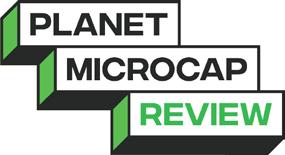
©Copyright 2022 by MicroCap Review Magazine Inc. All Rights Reserved. Reproduction without permission of the Publisher is prohibited. The publishers and editors are not responsible for unsolicited materials. Every effort has been made to assure that all Information presented in this issue is accurate and neither MicroCap Review Magazine or any of its staff or authors is responsible for omissions or information that is inaccurate or misrepresented to the magazine. MicroCap Review Magazine is owned and operated by SNN Inc.
This publication and its contents are not to be construed, under any circumstances, as an offer to sell or a solicitation to buy or effect transactions in any securities. No investment advice is provided or should be construed to be provided herein. MicroCap Review Magazine and its owners, employees and affiliates are not, nor do any of them claim to be, registered broker-dealers or registered investment advisors. This publication may contain “forward-looking statements” within the meaning of the Private Securities Litigation Reform Act of 1995, Section 27A of the Securities Act of 1933 and Section 21E of the Securities Exchange Act of 1934. All statements other than statements of historical fact are “forward-looking statements” for purposes of federal and state securities laws, including, but not limited to, any projections of earnings, revenue or other financial items; any statements of the plans, strategies and objectives of management for future operations; any statements concerning proposed new services or developments; any statements regarding future economic conditions or performance; any statements of belief; and any statements of assumptions underlying any of the foregoing. Such forward-looking statements of or concerning the companies mentioned herein are subject to numerous uncertainties and risk factors, including uncertainties and risk factors that may not be set forth herein, which could cause actual results to differ materially from those stated herein. Accordingly, readers are cautioned not to place undue reliance on such forward-looking statements. This publication undertakes no obligation to update any forward-looking statements that may be contained herein. MicroCap Review Magazine, its owners, employees, affiliates and their families may have investments in companies featured in this publication, may purchase securities of companies featured in this publication and may sell securities of companies featured in this publication, at any time and from time to time. However, it is the general policy of this publication that such persons will refrain from engaging in any pre-publication transactions in securities of companies featured in this publication until two trading days following the publication date. This publication may contain company advertisements/advertorials indicated as such. Information about a company contained in an advertisement/advertorial has been furnished by the company, the publisher has not made any independent investigation of the accuracy of any such information and no warranty of the accuracy of any such information is provided by this publication, its owners, employees and affiliates. Pursuant to Section 17(b) of the Securities Act of 1933, as amended, in situations where the publisher has received consideration for the advertisement/advertorial of a company or security, the amount and nature of such consideration will be disclosed in print. Readers should always conduct their own due diligence before making any investment decision regarding the companies and securities mentioned in this publication. Investment in securities generally, and many of the companies and securities mentioned in this publication from time to time, are speculative and carry
I want to focus on the second point because your guess is as good as mine regarding when sentiment will return. Anecdotally, I’ve interviewed or had conversations with hundreds of management teams over the last 5-6 months (since our last issue), and I would argue that 80-90% have reported one or more of the following: growth in earnings, newly profitable, highly accretive acquisition, multi-year contract with a Fortune 500 company, almost completing a new manufacturing facility, fully financed for growth initiatives - all catalysts for what one would assume would result in share price appreciation. That’s what one would think, and that’s what every CEO would hope and confused/frustrated as to why it hasn’t.
Although I am a market traditionalist and since I historically lean on using my own common sense, this method may be costly since it also embeds learning from one’s own mistakes. For example, for generations investors relied on their stockbroker or wealth advisor to “trust” their advice, timing, ideas, guidance and performance. For better or for worse this marriage could have been a very successful marriage, oh by the way, the Internet, social media, relentless advertising, and regulatory intervention changed everything. The advent of dis count brokering, and millennial DIY activity gave investors the power of making decisions but added the need for discipline, research, and trial & error. As far as I’m concerned and in my opinion, I would rather fail or succeed because of my own decisions rather than being led to slaughter and placing blame elsewhere.
WaiTiNg oN EDiToriaLAnd thus, for this reason, investors and funds with a MicroCap strategy or rather, any MicroCap investor with dry powder feel like they are kids in a candy store. Companies that were liked are now loved with haircuts in stock prices across the board. I’ve been trying to interview as many of these
Like everything in the Stock Market, MicroCaps are down. As of EOD on June 17, 2022, the MicroCap Review (MCRI), our proprietary MicroCap index tracking MicroCap performance, is down 26.73% YTD; the only index we track that is doing worse is NASDAQ, which is down 31.36% YTD. I don’t want to spend time in this editorial discussing why; I highly recommend tuning into Planet MicroCap Podcast to hear what my guests have to say about the matter. The real question is, well, now what? The summer is an opportune time to start reflecting on what your financial goals are for the near and long term using some of the data enclosed in this issue of the magazine, as well as macro data/indicators. Few things we are certain of right now: liquidity has dried up, interest rates have gone up (and probably will continue to) in order to rein in inflation, high flying growth names have taken it on the chin. There’s actually a bunch of things that we’re now certain of, but at the end of the day, despite rising inflation, this may sound otherworldly these days, but CASH IS STILL CASH. Having cash to deploy in times like these is where the greats have made names for themselves. At least for me, especially if we are going to continue to see declines, not just MicroCaps, but overall markets, is when I’m reflecting on how I want to deploy cash that will set me up for financial independence in the next 10-15-20 years. We don’t have all the answers, however, by reading this issue of the magazine, I hope that you’re able to walk away with a few nuggets that can help you on your path to financial independence.

companies as possible for my podcast and feature in the magazine because it confounds me. If you’re reading the Planet MicroCap Review, surely you are aware of the sentiment in this asset class - it’s no surprise. I’m only here to validate that if you even opened the magazine this far, you’re walking the path of every legendary contrarian. Hopefully, you’ll find some actionable information in here and I wish you all the best traveling down the rabbit hole(s) of your choosing.
Thank you for joining us on this journey, and please enjoy the Planet MicroCap Review Summer 2023 Issue (ideally reading this on a beach somewhere with a nice cold one). Cheers!
—Robert Kraft, Host & CEO Planet MicroCapanalysis of the sector and answered my questioned with a resounding yes, that battery metal stocks have transitioned from a fad to fashion.
• Where can investors find Hidden Gems in the numerous listings and noise/news in the market. Yale Bock’s article “Finding hidden gems” answered many of the questions with thought provoking insights.
• Regardless of market conditions, what do professionals do to successfully navigate through headwinds, rough waters and promotions picking stocks? Find it in: …..Other notable articles and Q&A’s cover topics such as updates on SPACs by Doug Ellenoff, and the latest on ESG and sustainability today is covered by Socialsuite’s Seth Forman.
As storytellers ourselves, we comb through the micro & smallcap spectrum of information, social media, press releases and even our own podcasts, magazine inserts, Index and financial conferences in our attempt to provide the most poignant articles, thought leaders opinions, and suggestive reasoning for you our readers.
When choosing content for this issue we asked ourselves a variety of questions such as:
get bombarded with market information intel in the news, social media, newsletters, ads, YouTube etc. we have to keep our perspective in mind, which is, how does what’s the stock market affect microcap stocks? How do we manage the our portfolio? How do we make our decisions of whether we should hold? As investors we do need to decipher pertinent details from those trying to sell us their ideas. Picking up morsels of truth is still our decision making which brings me to the point of staying in our sources we trust with a history of accuracy, doing this will do more self-made directives while resisting a constant repetitive barrage paid influences.
• Are battery metal stocks fad or fashion? Thankfully Gavin Wendt went the extra mile with his
microcap world often preach doing your homework, believe in methods, stick to your plan, learn from your mistakes, and build your maintain focus. I believe for the most part they are correct. Howdifficult to locate non-biased information during our searching for harder to interpret incoming information when it finds you.
• Several features answer pertinent questions on topics we all are pondering such as: Is AI a threat or a financial bonanza?
There’s insight in every article and we’d like to thank all our contributors and advertisers for their support and sharing their views. We look forward to seeing you in person at either of our upcoming events, Planet MicroCap Showcase: VANCOUVER on September 6-7, 2023 or the Planet MicroCap Showcase: VEGAS on April 30 - May 2, 2024.
a market traditionalist and since I historically lean on using my sense, this method may be costly since it also embeds learning own mistakes. For example, for generations investors relied on their or wealth advisor to “trust” their advice, timing, ideas, guidance performance. For better or for worse this marriage could have been a successful marriage, oh by the way, the Internet, social media, relentless and regulatory intervention changed everything. The advent of disbrokering, and millennial DIY activity gave investors the power of making added the need for discipline, research, and trial & error. As far as concerned and in my opinion, I would rather fail or succeed because of my decisions rather than being led to slaughter and placing blame elsewhere.
everything in the Stock Market, MicroCaps are down. As of EOD on June MicroCap Review (MCRI), our proprietary MicroCap index tracking

24 Why
Q&A with Chris Wood, Chief Investment Officer at RiskHedge
30 Survival is Most Important in MicroCaps
Q&A with Ian Cassel, Founder of MicroCapClub
90 Asia Corner: Hong Kong Hopeful to Breakout of IPO Slump
byLeslie Richardson, Elite IR
94 Making The IP Capital Model The Model Of The Future by Robert Cote, Esq., Cote Capital
96 Finding Hidden Gems in MicroCap Stocks by Yale Bock, CFA, Y H & C Investments
100 Awesome Aussies-Rarified Air by Richard Revelins, Peregrine Corporate Limited
102 ESG Investing 101 with ESGFIRE
by Filip Erhardt
106 Adding Public Relations to the IR Mix
by Roger Pondel, PondelWilkinson
48 Overview of the Planet MicroCap Index
P ROFILED C O m PANIES
22 Immuron Limited (NASDAQ: IMRN) / (ASX: IMC)

40 VirTra, Inc. (NASDAQ: VTSI)
68 Xcel Brands, Inc. (NASDAQ: XELB)
86 Pioneer Power Solutions, Inc. (NASDAQ: PPSI)
50-59 Planet MicroCap Index Q3 2023 Constituent List





seeing emerging trends and trends that were in place accelerating in all things related to AI.
The investment landscape was heavily influenced by macro events in what was a volatile first half of 2023. January started off on a strong note; a bit of a relief rally from a challenging 2022 across many sectors. However, the strength was concentrated in stocks that had underperformed meaningfully in the prior year and those with the highest BETAs. January’s market dynamics had all the hallmarks of a classic momentum crash. In fact, by our calculation, January was the 10th worst month going back to the late 1920’s for the momentum factor in US equities and the 17th worst in Non-US equities since the early 1990’s.
Despite the volatility, we have still been able to find meaningful trends. One of the more surprising sources of momentum in the US has been homebuilders and building supply companies - not an area that you would necessarily expect to be strong given higher interest rates and the banking crisis in March. Nevertheless, we are seeing better than expected performance and some green shoots of recovery in those industries. We have also seen momentum in biotech within US micro cap, especially those related to breakthroughs in oncology and liver disease. Of course, more recently we are
No matter what might be happening in the world economically, we have found over the years that there are always companies doing well somewhere. Our systematic application of momentum investing allows us to find them, unbiased to the source of strength.
2. CAN yOU HIgHLIgHT POTENTIAL OPPORTUNITIES, RISkS, AND kEy FACTORS TO CONSIDER wHEN INvESTINg IN mICROCAP STOCkS IN 2023 THUS FAR?
Micro cap is always full of opportunity….and risk. Overall, we think it might be a good time to invest in micro cap overall given its recent historic underperformance relative to larger market caps and tough sledding overall. We believe there could be a good snap-back rally in both absolute and relative terms in an equity market recovery scenario. From a stock specific perspective, we believe there will be massive opportunities for micro cap companies globally to pivot towards the strength in AI. We look at the opportunities from AI in three buckets:
1) enablers – those companies that can provide the building blocks that enable these giant AI workloads from a technology infrastructure perspective and supply innovation to larger companies,
2) integrators – those companies that can integrate the power of AI into their products/services to gain market share
going forward, and 3) harnessers – those companies that can implement the power of AI to unlock massive productivity gains and earnings power in their own businesses. We believe micro cap companies globally can play in all three of these areas as it relates to AI.
Lastly, we believe there is opportunity in micro cap globally as supply chains move closer to home. Micro cap companies tend to be more levered to their local economies, so they should disproportionately benefit from manufacturing and consumption originating with a more domestic orientation.
3. HOw HAS mACRO NEwS INFLUENCED yOUR CURRENT PORTFOLIO CONSTRUCTION AND wHEN ASSESSINg NEw IDEAS?
From a portfolio construction standpoint, we haven’t changed anything given the macro backdrop. Given micro cap’s general volatility, we have always believed that you need a disciplined approach to risk management and a sufficiently diversified portfolio no matter the market conditions. When assessing new ideas in a volatile, macro-driven market, it is even more important to focus on true alpha signals through the noise. Systematically, our investment process captures those companies with positive

momentum in their business and their stock prices. From there, we focus our research on those that have clear rationale for that momentum. We only invest in those companies with clear reasons as to why that momentum may persist long enough to earn value-added returns. We have found that in overly macro-influenced markets, you tend to have a higher proportion of false positives, which is why the combination of momentum and rationale is extremely important.
4. FOR THE REST OF 2023, wHAT ARE SOmE kEy CRITERIA, mACRO EvENTS, mICROCAP EvENTS, ETC... THAT yOU ARE wATCHINg AND wHAT ACTIONS wILL yOU TAkE IF THOSE POTENTIAL OCCURRENCES HAPPEN?
Our investment approach will stay the same no matter what may happen. We perpetually move our portfolios to strength and away from weakness, to new trends and away from old trends that are breaking down. However, for micro cap in general, we believe the macro economic cycle/path of interest rates will be most important to watch. Historically speaking, micro cap stocks are most sensitive to changes in investor sentiment and economic cycles. Micro cap tends to lead into the downdrafts and lead out in the recoveries. Given the amount of money on the sidelines and the relative lack of liquidity in micro cap versus larger market caps, we think the eventual rally in micro cap may be explosive in a recovery scenario. As we like to say, come to micro cap for the BETA in recoveries, but stay long term for the alpha opportunities.
For more information about Travis Prentice and EAM Investors, please visit: www.eaminvestors.com
Given micro cap’s general volatility, we have always believed that you need a disciplined approach to risk management and a sufficiently diversified portfolio no matter the market conditions.

1. CAN yOU PROvIDE A qUICk OvERvIEw OF ACUITAS’ mULTImANAgER STRATEgy?
Acuitas is a boutique multi-manager investment firm based in Seattle, WA. The firm is focused on small and microcap markets. We believe this exclusive focus on the inefficient corners of the market offers the greatest opportunity for absolute and excess returns. Aggressive idea generation and deep manager research are hallmarks of our investment process and we aim to find and evaluate investment managers before they hit the institutional radar. We then draw from this pool of high confidence investment managers to build portfolios where we seek to maximize excess returns. In the end we try to utilize our highest conviction managers and pair them in complementary ways to build custom portfolios for our clients.
2. wHAT mAkES A gREAT mICROCAP INvESTOR?
I think that great microcap investors employ a disciplined process and combine that with an exceptional focus on investing within a high-performance team. We are looking for investment managers that can win through stock selection and we don’t believe it is as simple as “knowing the names”. Acuitas formally evaluates dozens of aspects of an investment manager’s process from portfolio construction to sell discipline and in the end, it is important the investment manager can articulate the keys to the success of the investment process. If there is one characteristic that is common from the investment managers that we employ it is a passion for investing that manifests within a disciplined process. This
passion or competitive fire is really key to generating powerful returns over time. That said, it isn’t enough on its own. It has to exist within the proper framework. Idea generation is important to us so we are always looking to find great microcap investors and we look to form a view on them over time based on many conversations and a deep review of analytics.
3. wE’RE ABOUT HALF-wAy THROUgH 2023, I’vE HAD mULTIPLE CONvERSATIONS wITH BUy-SIDE mANAgERS THAT HAvE BEEN FACINg REDEmPTION ISSUES FROm THEIR INvESTORS. IN yOUR OPINION, wHy IS THIS A REAL CONCERN FOR BUy-SIDE mANAgERS? ESPECIALLy, wHEN CONSIDERINg I CHAT wITH OTHER INvESTORS wHO HAvE A TON OF DRy POwDER AND TOO mANy qUALITy mICROCAP IDEAS TO LOOk AT.
Active investment managers who focus on small and microcap stocks have come through a very challenging period. Prior to the pandemic, from 2009 to 2020, steadily rising markets made it easy for plan sponsors and individual investors to favor passive products. Just gaining market exposure seemed like enough for many. The characteristics of leadership also didn’t help. Large and growthy stocks led the market. While the smallest stocks showed a return advantage over the very long-term, it was easy for investors to ride the wave of mega cap dominance. The pandemic brought a wave of volatility to the market which brought some investors back to appreciating active management. This volatility can mean opportunity for stock pickers and we have seen a better overall active environment recently. Rising
interest rates put a degree of pause on the growthiest non-earners and brought back an environment where valuation and quality mattered. This has been good for long-only active managers. Finally, equity microcap investors have had to face headwinds from the rush toward private investments. We believe at some point there are challenges for the private equity/venture capital space due to higher rates, increased competition and tempered returns from these strategies. In the end, many investors chase returns and rush toward what has worked. That said there are always informed allocators that appreciate the valuation opportunity present within the small and microcap space. While stock opportunities may be abundant for fund managers, it may take a shift toward small cap leadership for plan sponsors to appreciate broader opportunity in microcap and allocate directly to the space.
The combination of large cap leadership and the perceived success of private investments has clearly affected the ability of small investment managers to raise capital. There always seems to be a headline highlighting the latest offshoot from a giant hedge
fund, but raising capital is hard work. Of course raising assets is also only one part of building an outstanding investment organization, but it is a necessary one. Larger allocators often have hurdles before allocating to small managers such as a five-year track record or wanting a critical mass of assets. They may want long tenure from a product or firm as well before they allocate. Of course it results in a chicken and an egg problem for the investment managers. That said, there are allocators like Acuitas. We pride ourselves on being early adopters and are willing to evaluate strategies at the

“If there is one characteristic that is common from the investment managers that we employ it is a passion for investing that manifests within a disciplined process.”
beginning of their life-cycle. In fact, we believe that there is a tangible positive impact to investing early with managers that have a smaller asset base and are best able to implement their strategy.

It is no secret that investors buy brand so I would encourage any buy-side manager to carefully build their brand by working hard to generate strong returns, networking and learning to communicate effectively about the strategy they employ. Historically we have seen some of the most lucrative environments for active management come after extremely challenging periods and it takes diligent and sustained outreach to find allocators willing to take advantage of valuation opportunities and market dislocations like we are seeing today.
funds for microcap managers. Our firm is unique in that we seek out early-stage, low asset base products that we feel have the potential to generate excess returns for our clients. Our process is lengthy, and it is a high bar to reach funded status, but we are proud of our investment results and we continue to believe that deep fundamental research on this inefficient corner of the market has the potential to benefit clients. Our multi-manager offering creates an efficiency for large plan sponsors and a source of capital for smaller investment managers. We believe that there is currently a unique opportunity for the asset class as microcap remains cheap relative to other cap tiers, most notably large cap. These types of dislocations often provide lucrative opportunities for strong active microcap managers and we are always looking to identify the next generation of great investors.
Acuitas can help by acting as a potential source of
For more information about Acuitas Investments, please visit: www.acuitasinvestments.com





FOuR

“Most retail investors believe ESG investments will perform as well as or better than the market as a whole” (Mottola, et al.). Whether it’s physical impacts, decarbonization incentives, or systemic risk to portfolio returns, investors are not taking the topic of climate change lightly; business will correlate to climate concerns.
For starters, their main goal is to provide returns to their clients, and climate change can impact their ability to do so. Professor David Larcker, of Stanford’s Graduate School of Business, told The Wall Street Journal that “fund managers need to acknowledge that there is likely to be some trade-off between ESG and financial returns, and that tradeoff may matter to individual investors” (Ward).
Although there is risk involved with climate change, there is also a lot of opportunity for investors. It is never too early for early action. Investors must manage risk while also exploring opportunities.
Perhaps the most important from a capital standpoint is that the younger generation of retail investors have an increased focus on climate change and ESG issues. An IR Magazine survey from February 2023 found that “45% of retail investors find ESG important” (Distefano). Evidence shows that businesses can attract and retain the best talent if they are making an effort to be sustainable and are trans-
parent about starting their ESG journey. Additionally, the younger generation is more likely to invest in a company that cares about the environment.
“For most retail investors, ESG investing is a natural fit. A recent survey from the Finra Foundation found that 57% of retail investors desire to align their finances with their values and view investing as an opportunity to make a positive change in the world” (Barbosa Vargas).
The Wall Street Journal survey, “How Investors Feel About ESG Initiatives,” details each age group’s willingness to invest in environmental, social, and governance issues. Evidence finds that young investors (18-41) feel positively about ESG, whereas investors 58+ years old were the least likely to support ESG objectives (Ward).
As climate change becomes an increasingly critical global crisis, the trend of young retail investors holding ESG investments will continue to grow.

It can be extremely difficult and overwhelming to start focusing on climate change within a business. Companies are encouraged to have high ambitions in this area. Tim Siegenbeek van Heukelom, Chief Impact Officer at Socialsuite, and Duncan Paterson, Director of Investor Practice at Investor Group on Climate Change, outline four steps as a good place to start focusing on in their July 2023 webinar “Why Investors Care About Climate Change.”
Step One: Develop a statement, policy, or position on climate change for the company. This can be as simple as having a page on the website. It’s important to acknowledge the climate risks the companies’ management will have to deal with, so make a statement that they can build off of.
Step Two: Introduce practices for managing climate risk. You can’t manage what you can’t measure. Try
to find quantitative data that reports can be generated from. Once a baseline has been established, implement changes and evaluate efficiencies. For example, a company could measure their electricity bills month over month to see where to cut usage and ultimately cut costs.
Step Three: Transparency and reporting. The company must identify who the key stakeholders are that they want to report out to. This could be investors, employees, shareholders, the board, or society at large.
Step Four: Generating outcomes. Share outcomes with key stakeholders. For the most part, this feels largely investor driven.
It is understood that climate-related regulation and/ or ESG regulation is on the horizon. Hopefully, there will be a global, unified framework but for now, we must be on the forefront of standardized data. A company who is transparent about starting their ESG journey may be more likely to attract investors, whether that’s institutional investors or Millennials and Gen Z retail investors.
Every company’s ESG journey is going to look different. Each company may disclose different information or gear it toward different stakeholders, but as time progresses we expect there will be standardized regulations.
Creating the company’s first ESG report can be daunting. Where is the data coming from? What framework should we follow? How much is this going to cost? How long will it take? Utilizing a platform like Socialsuite can help with all of the unknowns that comes with ESG reporting.
Socialsuite is an ESG reporting platform geared toward companies who are just beginning their ESG journey. A designated ESG Coach guides you through the process and ultimately creates the company’s initial baseline report.
ESG Disclosures are a great way to communicate to your key stakeholders– the Board of Directors, investors, employees, society at large– that your organization is dedicated to creating a positive impact.
Barbosa Vergas, Erica. “If You Care about Your Investment Bottom Line, You Care about ESG.” Nasdaq, 18 Apr. 2023, www.nasdaq.com/articles/ if-you-care-about-your-investment-bottom-line-youcare-about-esg.
Distefano, Noemi. “How Much Do Retail Investors Care about ESG Ratings?” IR Magazine, 10 Feb. 2023, www.irmagazine.com/case-studies/how-muchdo-retail-investors-care-about-esg-ratings.
Mottola, Gary, et al. Investors Say They Can Change the World, If They Only Knew How: Six Things to Know about ESG and Retail Investors, https://www. finrafoundation.org/sites/finrafoundation/files/ Consumer-Insights-Money-and-Investing.pdf.
Rosenfield, Josh, and Bruce Usher. “Author Talks: An Investor’s Guide to the Net-Zero Transition.” McKinsey & Company, 23 Nov. 2022, www.mckinsey.com/ featured-insights/mckinsey-on-books/author-talksan-investors-guide-to-the-net-zero-transition.
Ward, Lisa. “How Investors Feel about ESG Initiatives.” The Wall Street Journal, 2 Nov. 2022, www. wsj.com/articles/esg-initiatives-investors-survey11666975292?reflink=integratedwebview_share.
Socialsuite is an ESG reporting platform geared toward companies who are just beginning their ESG journey. A designated ESG Coach guides you through the process and ultimately creates the company’s initial baseline report.


Lucosky Brookman is the industry leader in micro-cap IPOs and in uplisting domestic or foreign quoted OTC companies and foreign exchange listed companies to the Nasdaq or NYSE.


Each month, Lucosky Brookman publishes The Uplisting Report and The Micro-Cap IPO Report - the most comprehensive resources dedicated to the Uplist, cross-list and micro-cap IPO marketplaces. The reports bring powerful and in-depth market data and analytics to help issuers, management teams, boards of directors, consultants and others involved in the IPO, uplisting and cross-listing processes make better decisions
Placing a particular emphasis on issuers operating in the micro-cap space (issuers with up to $300 million market cap), the following is a synopsis of our Uplisting and Micro-IPO Reports for the First Half of 2023 (H1) To view current monthly and archived Reports, please visit: https://www.lucbro.com/our-firm/uplisting-monthly, and https://www.lucbro.com/our-firm/micro-cap-ipo
Please contact us at uplist@lucbro.com if you would like to discuss your company ' s IPO, uplisting or cross-listing prospects, if you would like to better understand the IPO, uplisting and cross-listing marketplace, or if you would like to receive a comprehensive 7-8 page listing Analysis of your company
Lucosky Brookman LLP
www.lucbro.com
L i k e t h e l a r g e r c a p i t a l m a r k e t s , t h e m i c r o - c a p m a r k e t p l a c e c o n t i n u e d t o b e s e l e c t i v e i n t h e f i r s t h a l f o f 2 0 2 3 ( H 1 ) M i c r o - c a p u p l i s t e d a n d c r o s s - l i s t e d c o m p a n i e s r a i s e d a p p r o x i m a t e l y $ 5 6 . 7 m i l l i o n i n H 1 , w h i l e c o m p a n i e s c o m p l e t i n g m i c r o - c a p I P O s r a i s e d a p p r o x i m a t e l y $ 4 4 1 m i l l i o n
M I C R O - C A P I P O s
A t o t a l o f 3 9 m i c r o - c a p i s s u e r s , o p e r a t i n g i n 1 5 d i f f e r e n t s e c t o r s c o m p l e t e d t h e i r I P O s i n H 1 , w i t h o f f e r i n g s r a n g i n g f r o m a p p r o x i m a t e l y $ 4 , 0 0 0 , 0 0 0 t o $ 4 3 , 0 0 0 , 0 0 0 . T w e n t yt h r e e ( 2 3 ) m i c r o - c a p f o r e i g n p r i v a t e i s s u e r s ( F P I s ) f r o m 8 d i f f e r e n t j u r i s d i c t i o n s c o m p l e t e d t h e i r I P O s i n t h e U S d u r i n g H 1

U P L I S T I N G / C R O S S - L I S T I N G
A t o t a l o f 9 m i c r o - c a p c o m p a n i e s w h i c h o p e r a t e i n 5 d i f f e r e n t s e c t o r s m a d e u p t h e 2 0 2 3 H 1 c l a s s o f u p l i s t e d a n d c r o s s - l i s t e d c o m p a n i e s F i v e o f t h e n e w l y e x c h a n g e t r a d e d c o m p a n i e s w e r e l i s t e d o r g a n i c a l l y , m e a n i n g t h e y d i d n o t r e q u i r e a s i m u l t a n e o u s u n d e r w r i t t e n p u b l i c o f f e r i n g i n o r d e r t o c o n s u m m a t e t h e u p l i s t i n g o r c r o s s - l i s t i n g t o a S e n i o r U . S . E x c h a n g e . F o u r o f t h e u p l i s t s a n d c r o s s - l i s t s i n c l u d e d s i m u l t a n e o u s u n d e r w r i t t e n p u b l i c o f f e r i n g s , r a n g i n g f r o m a p p r o x i m a t e l y $ 3 , 9
While the number of micro-cap IPOs remained steady in H1, deal sizes and valuations were significantly down. In H1, the median capital raise and the average public offering price were $8.1 million, and $5.32, respectively, down 42% and 12% respectively, when compared to the same period in 2022
In a bid to meet Nasdaq's and NYSE's $15 million "Public Float" requirement in such a selective market, issuers began registering selling stockholders in their micro-cap IPOs, with 12 such issuers in H1, an increase of 11 issuers (1100%) from the same period in 2022
Our key takeaway from H1 is that less is more Smaller deal sizes not only appear to be getting over the goal line, but are also helpful in avoiding increased dilution at lower valuations. The strategy of registering legacy shareholders in the IPO compliments this approach to the challenges of today's market
The market for Uplist/Cross-list is at its most selective point in years During H1, 9 micro-cap uplisting and cross-listing issuers listed on a Senior U.S. Exchange, a decrease of 21 issuers when compared to the same period in 2022 A total of 5 issuers listed organically during H1, a decrease of 7 issuers
A total of 4 offerings were completed by micro-cap uplisting and cross-listing issuers in H1 (down 71%), raising a combined $56.7 million. This represented a significant decrease of $158.3 million from the combined $215 million raised in a total of 18 offerings during the same period in 2022 The average offering size in H1 was $14 million, however, 3 of the 4 offerings raised a combined $12 4 million ($4 1 million on average), with one offering raising a whopping $44 million. Similarly to the micro-cap IPO market, with smaller deals issuers are relying more and more on legacy shareholders to meet the "Public Float" requirement In addition, certain other Nasdaq rules related to reverse splits and simultaneous listing days are having a drag on the process.

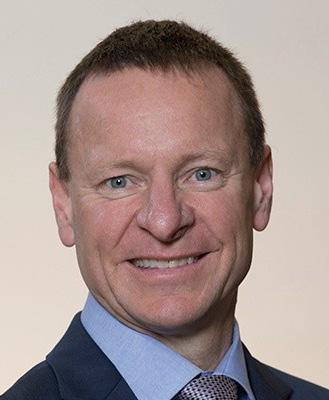
Immuron Limited is commercializing and developing a novel class of specifically targeted polyclonal antibodies which are delivered within the gastrointestinal tract and do not cross into the bloodstream.
Products in clinical development have the potential to transform standard of care for moderate to severe Campylobacteriosis, Clostridioides difficile infections, Enterotoxigenic Escherichia coli (ETEC) infections and Traveler’s Diarrhea. Immuron markets Travelan® in Australia, Canada and the U.S. In Australia, Travelan® is indicated to reduce the risk of travelers’ diarrhea and to reduce the risk of minor gastro-intestinal disorders. In Canada, Travelan® is indicated to reduce the risk of travelers’ diarrhea. In the U.S, Travelan® is a dietary supplement for digestive tract protection.
Immuron’s clinical programs for IMM-124E and IMM529 are the first steps in the pathway towards FDA (US Food and Drug Administration) approval in the BLA process (Biologic License Applications).
Lumanity a leading lifescience consulting company conducted an opportunity assessment of IMM-529. Infectious disease experts reacted favourably to the IMM-529 mechanism of action, and its unique ability to target three elements of the CDI infection – the spores, vegetative cells, and Toxin B. Base case yearly revenue in USA for IMM-529 was estimated at US$92M for the target patient population (limited to second recurrence and later). Positioning IMM-529
earlier than second recurrence could lead to higher uptake.
C. difficile infection (CDI) can cause life-threatening diarrhoea and is the leading healthcare-related gastrointestinal infection in the world.1 The global CDI market was estimated to increase to $1.7B by 2026, according to a report by GlobalData.2
1. Australian Commission on Safety and Quality in Health Care
2. GlobalData via Pharmaceutical Technology

wE’RE ABOUT HALF-wAy THROUgH 2023, wHAT ARE SOmE HIgHLIgHTS FOR THE COmPANy FOR THE FIRST HALF OF 2023?
• Global FY23 sales increased by 136% on FY22 to A$1.8 million
• Two FDA approved INDs: Travelan (IMM-124E) and CampETEC
º Phase 2 clinical programs for each to commence in collaboration with the Department of Defense
• Travelan randomized placebo controlled field trial being conducted by Uniformed Services University (USU) in active military personnel more than 35% recruited of a targeted 868 participants
ARE THERE ANy INDUSTRy TAILwINDS TO PUSH FORwARD SOmE OF THE COmPANy’S gOALS AND OBJECTIvES FOR 2023?
• International travel continues to rebound following removal of pandemic travel restrictions
º 2022 travel to Caribbean, Asia, South America, Central America, Africa, Mexico was 83% of the peak 2019 US outbound travel
º During the March quarter, US outbound travel to these regions was up 6% on 2019
º In Australia, Australian resident short term departures in April 2023 were 82% of those in April 2019
• Pandemic restrictions impacted our ability to conduct clinical trials, especially for traveler’s diarrhoea
º We anticipate strong recruitment for our Phase 2 trials (Travelan, CampETEC) and USU’s field trial
FROm wHAT yOU CAN TELL US, wHAT ARE SOmE OF THE COmPANy’S vALUE CATALySTS FOR THE REST OF 2023?
• We anticipate completion of recruitment for
Travelan Phase 2 clinical study
• We anticipate ethics approval and initiation for one of the CampETEC Phase 2 clinical studies (two Phase 2 studies are planned; one in Campylobacter, another in ETEC)

• We anticipate completion of recruitment for one of the CampETEC Phase 2 clinical studies
• We anticipate cGMP manufacture of IMM-529 clinical product; IMM-529 has been developed to prevent and treat clostridioides difficile (CDI)
• We anticipate pre-IND (Investigational New Drug) application to the FDA (US Food and Drug Administration) for IMM-529
• We anticipate continued strong sales growth for Travelan® in both Australia and USA
º Currently penetration in USA is low; based on US annual travel numbers and a penetration rate of 15%, USA market potential is estimated at $83m
For more information about Immuron Limited, please visit: www.immuron.com
DISCLAImER AND FORwARD-LOOkINg STATEmENTS NOTICE: This article is provided as a service of SNN inc. or an affiliate thereof (collectively “SNN”), and all information presented is for commercial and informational purposes only, is not investment advice, and should not be relied upon for any investment decisions. we are not recommending any securities, nor is this an offer or sale of any security. Neither SNN nor its representatives are licensed brokers, broker-dealers, market makers, investment bankers, investment advisers, analysts, or underwriters registered with the Securities and Exchange Commission (“SEC”) or with any state securities regulatory authority
SNN provides no assurances as to the accuracy or completeness of the information presented, including information regarding any specific company’s plans, or its ability to effectuate any plan, and possess no actual knowledge of any specific company’s operations, capabilities, intent, resources, or experience. any opinions expressed in this article are solely attributed to each individual asserting the same and do not reflect the opinion of SNN. information contained in this presentation may contain “forward-looking statements” as defined under Section 27a of the Securities act of 1933 and Section 21b of the Securities Exchange act of 1934. Forward-looking statements are based upon expectations, estimates, and projections at the time the statements are made and involve risks and uncertainties that could cause actual events to differ materially from those anticipated. Therefore, readers are cautioned against placing any undue reliance upon any forwardlooking statement that may be found in this article.
The company profiled has paid consideration to SNN or its affiliates for this article. SNN does not engage in providing advice, making recommendations, issuing reports, or furnishing analyses on any of the companies, securities, strategies, or information presented in this article. SNN recommends you consult a licensed investment adviser, broker, or legal counsel before purchasing or selling any securities referenced in this article. Furthermore, it is encouraged that you invest carefully and consult investment related information available on the websites of the SEC at http://www.sec.gov and the Financial industry Regulatory authority (FiNRa) at http://finra.org.
Note: This article is not an attempt to provide investment advice. The content is purely the author’s personal opinions and should not be considered advice of any kind. Investors are advised to conduct their own research or seek the advice of a registered investment professional.

1. I THINk IT’S SAFE TO SAy THAT THE SECTOR/TREND THAT By ALmOST EvERy mETRIC HAD THE mOST COvERAgE, mOmENTUm, yOU NAmE IT....wAS ARTIFICIAL INTELLIgENCE “AI”: wHy DO yOU THINk 2023 HAS BEEN THE yEAR OF AI?
I couldn’t agree more. It’s certainly safe to say that.
And it’s really been a long time coming.
As you know, the term “artificial intelligence” has been around since the mid-1950s. And businesses have been taking advantage of AI for years.
I wrote newsletters back in 2014 about how AI was already changing the world in countless ways. But every single application was for businesses.
What’s changed is that we’re now seeing consumerfacing AI applications for the first time.
So regular folks are recognizing how AI can affect their everyday lives. That’s driven a lot of hype in the space.
And it’s thanks to the new generative AIs like ChatGPT and DALL-E.
As you know these kinds of AIs can create unique content in the form of text, images, audio, and even
video from a text prompt. So you don’t need to be able to write code to take advantage of them.
Like you can tell ChatGPT to write a poem about shrimp po-boys in the style of Robert Frost.
Or you could tell DALL-E to create a picture of the New York City skyline in the style of Pablo Picasso.
Pretty cool stuff.
The “transformer” neural network architecture first introduced by Google in 2017 allowed these consumer-facing applications to materialize.
2. wE’vE SEEN mANy ExCITINg NEw INDUSTRIES/SECTORS/TRENDS IN THE LAST 10 yEARS (CANNABIS, PSyCHEDELICS, CRyPTO), wHAT mAkES AI DIFFERENT FROm OTHER “gROwTH-y” TRENDS?
Yeah, the main difference I see is that AI is a true general purpose technology… like the personal computer or the internet. But even more profound in terms of the productivity gains that are possible.
It’s these sorts of general purpose technologies that really make a difference in the world by spreading throughout all sectors of the economy and accelerating the march of economic progress.
When a breakthrough general purpose technology
gets to the point where mass adoption is possible, the growth that comes with it is mind blowing.

And that’s what we’ve seen with AI this year.
3. FROm A RESEARCH PROCESS PERSPECTIvE, CAN yOU LEvERAgE AI AS PART OF THE DUE DILIgENCE PROCESS? wHAT AI TOOLS OUT THERE HAvE yOU USED?
Absolutely.
Now, you should always check the accuracy of what these things spit out because of the “hallucination” issue. That’s when a large language model (LLM), like what ChatGPT is built upon, essentially makes up information.
In late June, for example, two New York lawyers were sanctioned for submitting a legal brief that included six fake case citations that were generated by ChatGPT.
So you must be careful. It’s best to treat these things like a junior analyst that you need to check. But as long as you take the hallucination issue into account, these AIs can definitely help with the research process.
Personally, I was using OpenAI’s ChatGPT Plus Browse with Bing beta feature. It was superior to regular ChatGPT because it used the most capable model (GPT-4) and was essentially stitched onto the
Bing search engine, which allowed you to get up to date information beyond ChatGPT’s last “knowledge update” in September 2021.
Unfortunately, OpenAI disabled the plug-in on July 3 because it “can occasionally display content in ways we don’t want. For example, if a user specifically asks for a URL’s full text, it might inadvertently fulfill this request.”
OpenAI says it’s working to bring back this feature “as quickly as possible.”
Another option for now that works well is Bing Chat, which is built into the Microsoft Edge browser’s sidebar. It lets you choose the tone, the format, and the length of what you want it to write about. I recommend playing around with it to see how it could help you.
4. FROm AN INvESTINg PERSPECTIvE, mANy COmPANIES ARE TRyINg TO CAPITALIZE ON THE AI TREND AND COmINg OUT wITH THEIR “AI” TOOL - wHAT ARE yOUR CRITERIA FOR SEPARATINg THE TRUE AI CONTENDERS FROm THE PRETENDERS?
As a general rule, I tend to avoid stocks with AI in their names…
There is one tiny company with AI in its name that I recently recommended to my subscribers and I invested in personally. But this was a special case.
In general, I’d say stay away from the stocks with AI in their names.
It’s like what we saw with blockchain craze when stocks that added the word blockchain to their names or business descriptions saw their stocks pop. Then reality set in and they fell hard.
Remember in January when BuzzFeed said it was going to use AI to create content and the stock jumped more than 300% virtually overnight. It’s fallen 85% since then.
If you want to go back a little further it’s very similar to the stocks that put “dot com” in their names in the late 1990s… most of which fell apart.
I think a better way to look at the AI space is to start with industries and companies that make sense independent of AI.
You know find fast growing cash generating companies solving problems in big markets…
And then see how they’re taking advantage of AI to grow revenue and improve efficiency and profitability.
So think of how Google used AI to provide the best search results and beat out the competition way back when.
Or how Amazon used AI to provide the best product recommendations and essentially develop a new way to shop.
I also think it’s smart to look for companies riding the AI wave across all sectors of the economy. These are companies that provide something fundamental that all AI needs. Picks and shovels type things.
You know like how regardless of the electric vehicle company, they all need batteries. So if you find the best EV battery company it’s probably a solid investment.
So this would entail looking at the hardware and infrastructure layers of AI rather than the application layer.
A company like NVIDIA would fit the bill here.
As you know NVIDIA’s GPUs power most AI projects.
It’s important to be aware of the amazing run that NVIDIA’s stock has been on… and the fact that it’s not an AI pure play. But I don’t see demand for its AI chips declining anytime soon… quite the opposite in fact.
5. wILL 2023 CONTINUE TO BE THE yEAR OF AI? wHy/wHy NOT? AND, HOw SHOULD wE THINk ABOUT AI’S EvOLUTION FOR THE NExT 3-5 yEARS?
Well, we could definitely see a pullback in the well-known AI pure plays like C3.ai (AI), BigBear.ai Holdings (BBAI), and SoundHound AI (SOUN).
In fact, we’ve already seen that with BigBear.ai. It’s fallen more than 65% from its February highs.
But AI itself is not just here to stay, it’s arguably the biggest disruption in history. And it will continue chugging along for decades to come.
There’s an important thing to keep in mind here: This is the WORST AI is ever going to be. It’s only going to get better from here. And it’s already quite impressive.
I’m not smart enough to be able to predict how AI will evolve over the next 3 to 5 years… or even the next six months really. And I’m okay with that. I mean how many folks could have predicted how the internet and world wide web would evolve?
That’s what makes human beings exceptional… our ability to create previously unimaginable products and services once these kinds of general purpose technologies are unleashed.
But I am smart enough to know that if you’re not paying attention to AI and doing all you can to learn about it and leverage it, then you’re going to be left behind… whether you’re an individual or a business.
For more information about Chris wood and RiskHedge, please visit: www.riskhedge.com









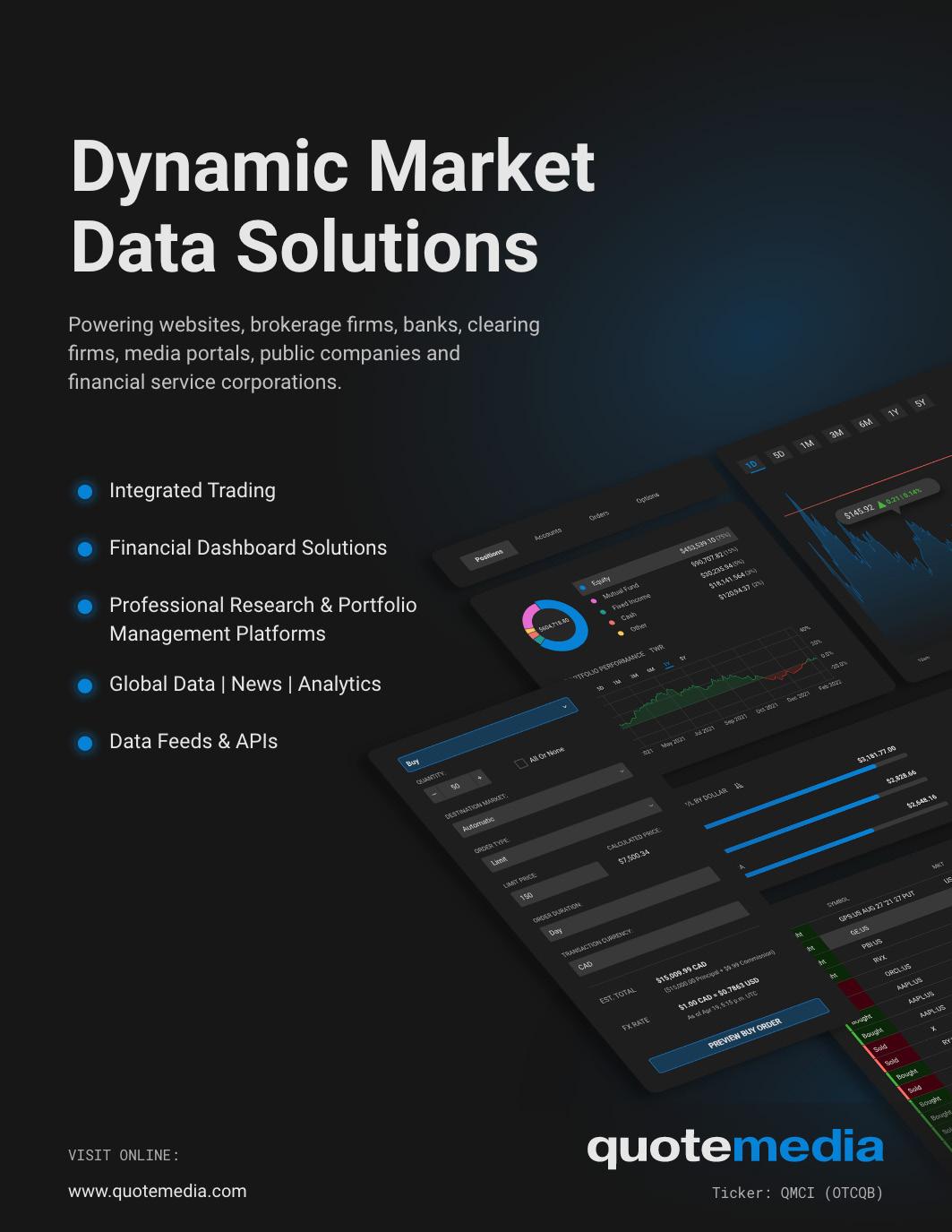
Since 1927 value stocks have outperformed growth stocks and smallcap stocks have outperformed largecap stocks. It shouldn’t be surprising that smallcap value stocks were the best performing segment. In fact, since 1927 smallcap value has outperformed the S&P by 14x. MicroCapClub member Mark Vonderwell mentioned on our forum that during this ~100-year period, smallcap value suffered long periods of mediocre perfor-
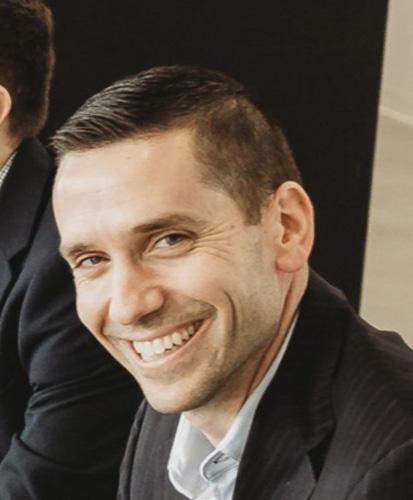

mance or even under performance. The longest period of mediocre performance lasted 19 years. The periods of outperformance can be explosive, and they normally last 5-7 years. We are currently in a 16-year period of underperformance. The EV/EBIT value spread which represents valuations of the cheapest 10% of the market has historically never been cheaper. Smallcap value is cheaper than it was during the DOT COM bubble and the global financial crisis. This is all to say smallcap value is staged to have a few good years. Perhaps even phenomenal years. In Q2 2023 we are starting to see signs of smallcap value
downtrend.
2. CAN yOU HIgHLIgHT POTENTIAL OPPORTUNITIES, RISkS, AND kEy FACTORS TO CONSIDER wHEN INvESTINg IN mICROCAP STOCkS IN 2023 THUS FAR?
Smallcap value stocks are a good opportunity, but the risks in microcap stocks don’t change year to year. Microcap is for stock pickers. The key is finding the ones that can both grow and survive. Some investors only focus on growth (growth investors). Some investors only focus on survival (value investors). I like to find both attributes in a business. Growth is rather easy to identify. The hard part of growth is finding a business that can sustain growth over a 5–10-year period. Does the business have the leadership, people, processes, culture that can scale? These are the growth questions you need to answer.
Survival is more important. As microcap investors, our biggest risk is dilution. It’s hard for a company to create shareholder value when they need to consistently sell equity to survive. It’s hard for management to make long-term decisions when they must constantly worry about their short-term stock price. In general, being an unprofitable microcap company is a big disadvantage. If you do invest in unprofitable companies, you must have confidence in their ability to hit short-term milestones and catalysts and also you are hoping/praying the market will reward the company with a higher stock price.
A much easier way to win is to focus on the 18% of microcap companies that operate profitable businesses or have large cash positions that can get them to profitability.
3. HOw HAS mACRO NEwS INFLUENCED yOUR CURRENT PORTFOLIO CONSTRUCTION AND wHEN ASSESSINg NEw IDEAS?
I can’t control the macro situation. The best macro strategists in the world are right 50% of the time. We are all better off flipping coins if we want to predict the future. The way I handle the macro is the handle the micro. Focus on what you have control over, finding and holding great investments. My primary hurdles for new investments:
• A business that can grow through a recession.
• A balance sheet that can weather a storm and act with occasional boldness.
• A leadership team and organization that show signs of intelligent fanaticism ie Find management teams that deserve to be running much larger companies.
• A valuation that can conservatively double in three years.
Are there many companies that fit these four qualifications? No. It screens out 99% of the microcap investment universe. This is fine. I’m a stock picker. I can be selective. If I’m successful in finding businesses that fit these four parameters, I don’t have to worry about the macro.
4. FOR THE REST OF 2023, wHAT ARE SOmE kEy CRITERIA, mACRO EvENTS, mICROCAP EvENTS, ETC... THAT yOU ARE wATCHINg AND wHAT ACTIONS wILL yOU TAkE IF THOSE POTENTIAL OCCURRENCES HAPPEN?
I’m 100% focused on the micro. Are the businesses I own executing or am I making excuses for them not executing? The businesses that are executing make it look easy. I don’t stress over the stocks that move up and grow into big pieces of my portfolio. They’ve earned that right. I stress over the small ones I’ve been holding and justifying “let’s wait another quarter”. It’s those “wait another quarter” stocks that are like death by a thousand cuts. Holding losers is easier than holding winners. Why? Because losers always look cheap.
If you invest in microcaps you will have turnover. You must have turnover. 20% of what you own today will likely deserve to be owned 5 years from today. This means that 80% of what you own today will deserve to be sold. My intention with every purchase is to hold forever but very few will earn that right.
In a recent article I wrote titled, “Conviction Investing,” I mentioned that successful stock picking isn’t just picking winners. It also means picking out the losers in your portfolio. Warren Buffett wasn’t a coffee can investor. Most of the stock pickers you admire are conviction investors. They focus on finding the best opportunities, knowing them better than most, holding the ones that are worth holding, and selling mediocrity.
For more information about MicroCapClub, please visit: www.MicroCapClub.com
As they sweep up the broken glass, market participants are asking what comes next. Will SPACs return to being a niche alternative approach to going public? Or could new approaches to structuring deals reignite excitement among quality private companies and public market investors?
To rewind a bit, SPACs first caught the attention of average investors and the media back in 2020. While SPACs had existed for several decades, they surged in popularity during the pandemic lockdown as ample liquidity and couch-bound speculators fueled an explosion in deals. That year, 248 SPAC IPOs raised over $83 billion in proceeds, exceeding the number of traditional IPOs. The largest investment banks embraced the format, and many established private equity funds and hedge funds rushed to launch their own vehicles. In 2021, the market doubled as 613 new SPAC IPOs raised over $162 billion.
SPACs are, in essence, public shell companies that load up with cash and go out searching for a private target company to merge with. In those heady days, many deals soared above their $10 offer price as soon as a target was announced. As competition for targets increased, SPAC managers began to embrace earlier-stage companies with visionary promises of flying taxis and space tourism. Aspirational valuations were supported by heroic financial forecasts stretching many years into the future. In addition to the shareholder money held in the SPACs trust fund, many deals lined their war chests with significant PIPE investments by institutional investors.

Unfortunately, not all these management teams were able to deliver the hockey stick forecasts contained in the SPAC merger slide presentations. Shareholders were reminded that venture-stage companies do not always gain market traction on a predictable timetable. And some never gain it at all.

For two years, the SPAC market threw an epic party. Now it’s wrestling with an awful hangover.
As interest rates began to rise and the prospect of a recession appeared on the horizon, investors began to lose their taste for more speculative SPAC mergers. Rather than receive shares in the new company when the deal closed, investors increasingly elected to receive their share of the cash held in trust instead. Companies that missed their forecasts saw market caps wither. SPACs went from white hot to stone cold.
What is the state of the SPAC market in 2023?
Just 19 new SPAC IPOs have gone public thus far in 2023, raising $2.3 billion. That said, SPACs have accounted for half of the total IPOs in what has been an anemic market for new issues.
Over that same period, 131 SPACs have liquidated, returning the cash they raised to shareholders. For the SPAC sponsors, liquidation means losing millions of dollars in risk capital spent to pay fees to investment bankers, lawyers, auditors, and other costs of being a public company and conducting due diligence. While SPAC sponsors are often portrayed as profiting at the expense of retail investors, these deal makers have collectively lost billions of dollars, while public shareholders are made whole when a SPAC dissolves.
44 SPACs have completed a business combination with a private company so far this year. However, investor redemptions on those deals have run at an average of 96 percent, meaning the new public company is left with only a tiny fraction of the anticipated capital raise to fund expansion. In many cases, the accumulated professional fees are higher than the amount of cash left in the SPAC to pay them.
Today 210 SPACs are still searching for deals. But given the inherent uncertainty about how much capital will be injected at the end of the process, luring private companies to embrace the SPAC format has grown more challenging. Many SPACs have reached the end of their allotted time to complete a deal and now must pay additional fees each month to extend their lives.
By the end of the year, the population of SPACs seeking to complete mergers could be winnowed
What does the future hold for the SPAC market?
In the near term, SPAC IPOs will likely be smaller and fewer than during the boom. In 2023, most new SPAC IPOs have been under $100 million, down from over $300 million in 2020. Smaller, specialized investment banks are underwriting these deals. And to entice investors, sponsors are offering a higher guaranteed rate of return by overfunding the trust account or adding on additional warrants or rights to sweeten the deal.
These features make SPACs more attractive to credit-oriented investors and arbitrage funds. But unfortunately, they also increase the probability that shareholders will redeem, and the trust fund will be depleted at closing. Sponsors end up paying a high cost to keep the money in trust while searching for a target and navigating the SEC registration process. But then, when they and the target company really need the money, it disappears.
Restoring a fundamentally healthy SPAC market would require a few significant changes. Investors need to see they can make more money by holding their shares in the merged company rather than redeeming them for cash. Companies need to have a higher degree of confidence that they can raise the capital they require to execute their growth plans. And sponsors need to be rewarded for the effort and capital they put into sourcing great companies and guiding them to be successful in the public markets.
Achieving those goals requires changing how SPACs approach valuations, incentives, and public company readiness.
To entice investors to keep their money in the deal, the SPAC and the target must provide a valuation that offers a reasonable upside to public investors based on achievable financial targets. In the heat of negotiations to persuade a private company to pursue a SPAC merger, sponsors and advisors may be tempted to dangle an inflated valuation to close a deal. Company management must be educated that it is far better to have most of the cash remain in the company and have the stock trade up than to
briefly obtain an inflated valuation and end up with a threadbare balance sheet.
In a difficult financing market, SPACs with some form of captive financing are likely to have a competitive advantage in sourcing quality deals and the credibility to negotiate favorable terms for all investors. One solution could be a hybrid structure combining committed private financing with the contingent capital offered by the SPAC.
The incentives for SPAC sponsors should be aligned away from “get rich quick” towards “build wealth over time.” This might involve rebalancing their equity ownership from shares to warrants that pay off once the stock trades above the cost basis of public investors.
Investment banking compensation could be adjusted to reflect the amount of cash on the balance sheet at the closing of the SPAC merger and not simply the amount raised at IPO. This would create incentives to advise on positioning deals to be attractive to equity investors beyond the “SPAC mafia” of credit and arbitrage funds.
network Iridium Communications (NASDAQ: IRDM), digital sports gaming platform DraftKings (NASDAQ: DKNG), and salty snacks brand Utz Brands (NYSE: UTZ) have created value for shareholders and accelerated their growth via this method.
Given their flexibility, SPACs are likely to be a permanent part of the corporate finance landscape for the foreseeable future. Now that the champagne has gone flat and the bills have come due, it is the right time to look in the mirror and contemplate what changes are required to make the SPAC a valuable tool for discovering and launching great companies.
Drew Bernstein, Co-Managing Partner Marcum Bernstein & Pinchuk (MBP)a leader in SEC audit accounting and consulting services to Chinese companies seeking access to capital markets.
In 1983, Drew Bernstein co-founded Bernstein & Pinchuk. Additionally, he co-founded MarcumBP, which is a member of the Marcum Group and an affiliate of Marcum LLP. a leading U.S. accounting and advisory firm. Both firms have multiple offices within the United States and Asia.
Bernstein is a distinguished expert with deep knowledge of the China and U.S. financial ecosystem with experience extending across Asia. Europe and Africa. Industry experience encompasses technology. retai l. manufacturing, hospitality, pharmaceutical and real estate. Bernstein directs a global team, featuring highly trained PCAOB and SEC accounting experts and financial consultants working in New York as well as Beijing. Tianjin. Shanghai. Shenzhen. Hangzhou. and Guangzhou.
Finally, SPAC managers will need to pay greater attention to selecting targets that have the potential to be successful as public companies. This requires not just an investment story that resonates with public shareholders but the ability to set targets and deliver results in a reasonably predictable fashion. Building a robust financial reporting and forecasting function is essential to earning investors’ confidence and remaining current with reporting obligations.
One of the great potential advantages of a SPAC merger over a traditional IPO is that the target company can draw upon the expertise and guidance of executives with extensive experience in public company management and the capital markets. Ideally, a strong SPAC management team would remain closely involved for several years after the transaction closes, providing a bridge to becoming a thriving public company.
When it works well, a SPAC merger provides a path for companies with solid fundamentals that are slightly outside the mainstream to access the public markets. Companies as diverse as satellite
Additionally, Bernstein is considered a valuable thought leader and news commentator. He has published articles for Forbes.com and China Daily and is a frequently called upon source by prominent media such as China Global Television Network. CNBC. Bloomberg TV. The Financial Times. The South Chino Morning Post. The Wall Street Journal. Yahoo! Finance. and more regarding Chinese IPOs. China’S economic growth. investment appetite, innovation trends, corporate governance, SEC regulations and more.
Bernstein graduated from the University of Maryland with a B.S. in Accounting. Currently, he resides in New York City with his wife and children.
About MBP
Marcum Bernstein & Pinchuk LLP (MBP) offers specialized audit and advisory services to support SPAC sponsors and SPAC targets in Asia. MBP and its parent company, Marcum LLP. have been involved in more SPAC transactions than any other audit firm. MBP is the only audit firm to have a dedicated SPAC team for Asia. MBP performs all audits for Marcum in Greater China. and MBP is a top-five auditor for Chinese companies listed in the United States.
The dedicated SPAC team has worked with SPAC sponsors, underwriters, and targets. MBP draws on wide-ranging experience with the initial publiC offerings and subsequent business transactions forged by such companies. MBP has designed its audit platform to deliver the technical expertise. efficiency. and urgency required by SPAC IPOs. This includes high-quality. PCAOB-compliant audits for private Asian companies that are contemplating entering a SPAC merger.
Website: U.S.: https://www.marcumbp.com:
China: https://cn.marcumbp.com
Note: This article is not an attempt to provide investment advice. The content is purely the author’s personal opinions and should not be considered advice of any kind. Investors are advised to conduct their own research or seek the advice of a registered investment professional. The author does not own shares in any of the companies mentioned in the article.
Sports create purpose and fuels dreams. That’s why the Challenged Athletes Foundation is committed to providing athletes with permanent physical disabilities access to life-changing sports equipment, coaching, and competition expenses.
CAF is ready to deliver more impact, create more invaluable opportunities for mentorship, and strengthen our adaptive athlete community.
Learn how your organization can be part of the movement that’s breaking barriers, igniting futures, and changing lives. challengedathletes.org/partner

It’s hard to believe that 2023 is half over. It has been an interesting year in the markets.
Capital is still available, but harder to come by, IPO’s are slowing down, although there is some upward momentum. SPAC’s continue to have the microscope on them. The redemption rate remains high for SPAC transactions. In March alone we saw almost a 95% redemption rate on trust capital for the March deals. This leaves the SPAC underfunded and investors quickly lose interest in the deals. Companies can’t rely on the funding and have to look to raise capital to meet their plans.
On the executive talent front, 2023 is definitely a transition year. There are very qualified executives available in the market looking for their next opportunity. For companies looking to expand or upgrade their teams, it’s an opportunistic time to bring in some exceptional talent. Many of the available executives are the victims of M&A. Companies are slowing their hiring decision process, many companies are just not adding to the headcount and instead asking the existing team to do the work of two executives. While asking more for less keeps cash burn down, companies that don’t build out their executive team, run the risk of not executing their business plans and not meeting their goals. For companies that are looking to grow, I expect to see hiring growth as we near the end of the year.
On the human capital front, companies are starting to realize that they need employees in the office at least on a hybrid basis. There are studies now stating what many of us knew, remote work is not as productive nor innovative. The pace of innovation has slowed considerably in a remote environment. Employees are still pushing back on retuning the office and are enjoying their work from home situations. Companies need to weigh the productivity and innovation with the happiness quotient of employees. Companies that can educate the workforce and create the culture that incorporates the importance of on-site work for career development will see long term success. In addition, the ability to show employees that collaboration at the office is a vital component of that growth, both personal and corporate will reap the rewards of employee development. Employees who embrace the culture will see a more rapid career growth. Companies that can successfully develop a hybrid culture will be more successful.
Microcap companies are constantly faced with staffing challenges. Competing with larger companies on experience, pay, benefits, etc. that larger companies can use to attract and retain talent. Historically, microcap companies have succeeded as they are nimble and can make decisions faster and more
efficient. In a microcap company there is access to the decision-makers and routinely the executives are working alongside the team, thus creating a sense of ownership and collaboration at a level employees would not experience in a large firm. As larger tech firms are laying off employees, opportunities exist for microcap firms to grab these tech-savvy employees from larger firms. This will create the innovation needed for a microcap company to accelerate development, growth and build their success. Companies that can take advantage of hiring employees will have an advantage in innovation and growth.
From a CFO perspective, there is a lot going on. The microcap capital markets have been volatile. Many companies are losing market value due to the economic conditions as well as the tightening of the ability to raise capital to continue their innovation and growth. The CFO is under pressure to continue to bring company awareness to the market with the challenge of slower growth and less available liquidity. The CFO continues to be under pressure to manage costs and preserve cash. This creates friction between innovation, growth and execution of the strategy. The overhead is scrutinized by investors and there is a lot of pressure to get to cash
flow break even sooner rather than later. While this is always the goal of a company, investing in the initiatives that require more time to vet out or bring to market are not as popular and many CFO’s are experiencing pressure to manage these initiatives or potentially cut them until the market conditions are more friendly for investment.
The interest rates are also impactful to microcap growth. With the cost of capital increasing, there is pressure on the CFO to continue to deliver results that cover the increased costs of capital. i.e. – you need to deliver more to cover your fixed costs. This puts a lot of pressure on the organization to manage their costs and their return on innovation and/or new products. The conundrum between bringing new products to market and creating future value through innovation, or maximizing your existing products and drive the results with market penetration. How do companies manage the speed and cost of innovation that requires capital with the ability to continue to be a going concern. This is always a concern with the microcap company. Executives that can effectively manage the growth capital will reap the rewards into 2024.
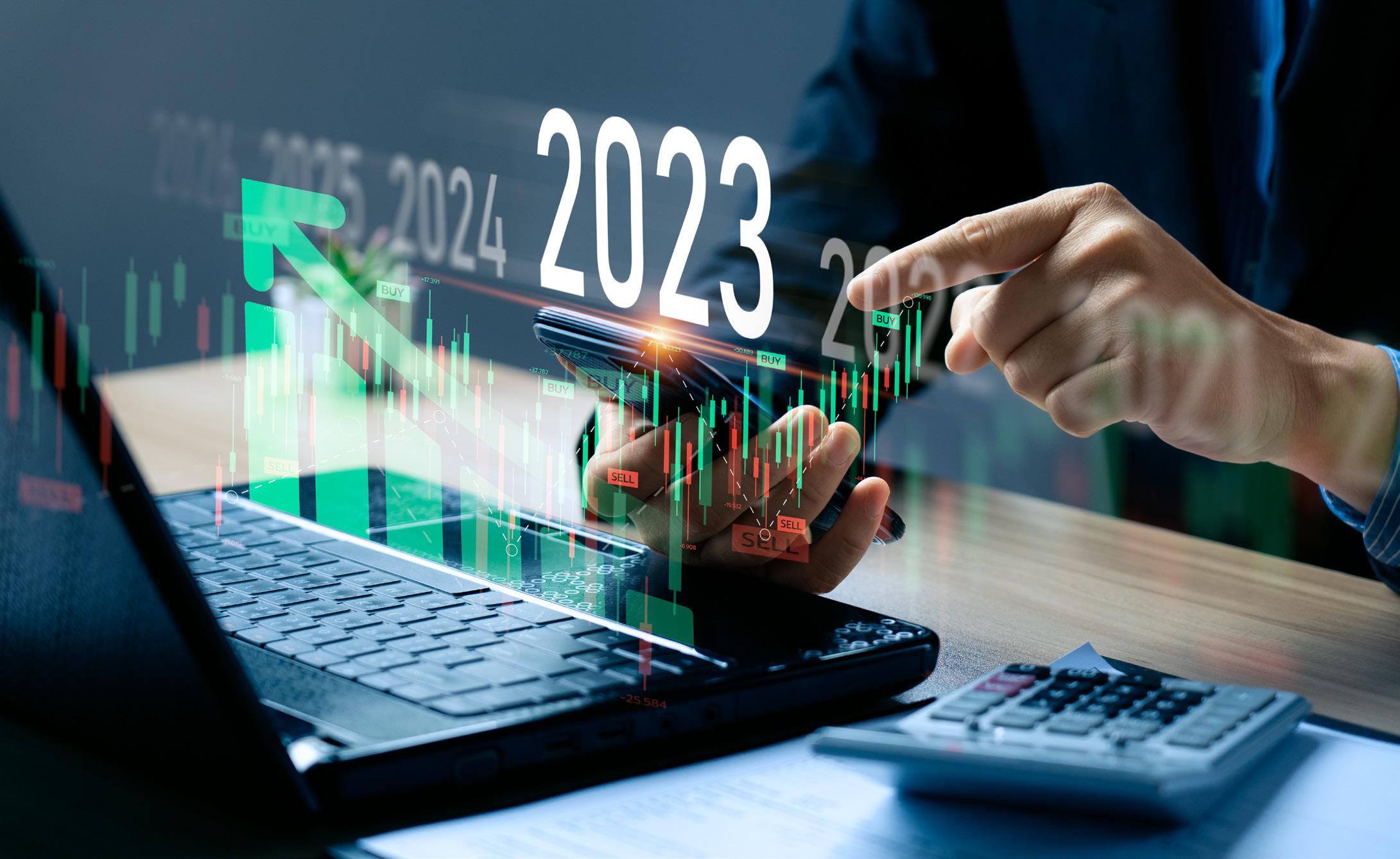
From a staff outsourcing prospective, we are seeing a trend in the CFO outsourcing the back office. With the tight employment market, many companies are looking to the outsourced model. This is starting to include the CFO, however, public companies are still reluctant to have the CFO outsourced due to the risks involved of not having that executive on-site as a key part of the team on a daily basis. We are however, seeing a trend to bring in interim CFO’s to bridge the gap on turnover. For companies that have an executive transition, having an interim executive ready to step in allows the company time to find the right executive and not the right now executive.
DEI initiatives are still in full swing, however, we are seeing many companies cut back on the initiatives and the spend associated with such initiatives. It is important to incorporate the initiatives in the culture and part of the company core values. As we all know, culture is driven from within and not dictated from the top down. As companies continue to incorporate diversity into the workforce, we are seeing the make-up of the C-suite changing. This self-awareness is key to a more inclusive workforce and bringing diversity to the C-suite. Companies that can incorporate the culture aspects of DEI will be more successful than companies that have sponsors trying to push the initiatives through the company.
From an ESG front, we continue to wait for the SEC to finalize the ESG disclosure rules. Companies should be focused on sustainability and focusing on the how developing the sustainable culture. There is a lot of discussion around ESG and the future, including how to continue to frame the “name” of ESG. We can stay tuned on how this will develop into 2024.
Outlook for the rest of 2023. We fully expect hiring to pick up in the fall. Companies need to get the right people in place to ensure that their business plans and strategies can be executed. I expect to see more executive turnover for underperforming companies as well as employees who are not willing to be on-site and working with a team. Investors are starting to demand that companies build teams that are highly functioning and delivering on results. Lackluster performance will not be tolerated as we move into the later half of 2023. This will result in executive turnover on underperforming companies.
There are a lot of great executives on the market right now and companies will take advantage of executives with experience on transformation as well as restructuring companies through and economic downturn. In addition, executives that were successful in launching products and achieving high growth results will continue to be in demand. Don’t be surprised if you start to see the turnover coming.
Recapping, 2023 has been a very tough year in the microcap market. Companies that can be innovative and execute on their strategy while preserving cash and value will see a rise into 2024. Companies that capitalize on building out a team that can execute will be rewarded on the back half of 2023 and set up for success in 2024. Remember, there is nothing like performance to reward a company with continued investor support and the ability to raise capital for the next initiative.
Kelly Anderson, CPA (Inactive) Founder and CEO CXO Executive Solutions (A Hawkstone Capital Portfolio Company)Kelly Anderson is the Founder and CEO of CXO Executive Solutions, LLC, a national woman-owned company providing executives to clients on an interim, advisory or permanent basis. Kelly’s 25+ years as a public and private company CFO is critical to the success of CXO and the ability to have peer discussions with CXO clients. With Kelly’s capital market, strategic development, financial acumen, organizational and communication experience, she is able to partner with clients and partners to solve their issues/problems/concerns.
Kelly/s approach to her clients is as a strategic member of the management team. she takes responsibility for team’s ability to report on performance, trends and business issues that affect the execution of client’s goals. These roles require working closely with her clients, including board of directors and executive management to present and communicate company-wide achievements and provide ideas on how to seize new opportunities and mitigate shortfalls.
Current Board Seats:
• Tomi Environmental Services (TOMZ) – Board member since 2016, Audit Committee Chair, Compensation Committee
• AgEagle (UAV) Board member since 2022, Audit committee chair, compensation committee, nomination/governance committee
• Accounting Advisory Committee – California State University, Fullerton
• Association for Corporate Growth – Board Member and Awards Committee
• Woman Corporate Directors – Co-Chair LA/OC chapter
Past Board Seats:
• Marygold Companies (MGLD) Audit committee, Nomination/governance committee
• Guardion Health Services (GHSI) – Audit and Strategic Committee Member
Education: Kelly has a Bachelor of Arts, Accounting Concentration, from California State University, Fullerton and is a California CPA. Her license is currently inactive.
Note: This article is not an attempt to provide investment advice. The content is purely the author’s personal opinions and should not be considered advice of any kind. Investors are advised to conduct their own research or seek the advice of a registered investment professional.
. As a full-service SEC-registered Transfer Agent with over 3,000 clients, we provide a hassle-free and cost-effective funding and shareholder management solution . Our solution streamlines the investment process and increases efficiency, while eliminating the need for third-party vendors and offering a cost savings of up to 65%*.
| Benefit from a fully digital, end-to-end funding solution.
| Streamline investor onboarding and automate compliance processes.
| Manage your shareholders in real-time with instant share issuances, transfers, and distributions.
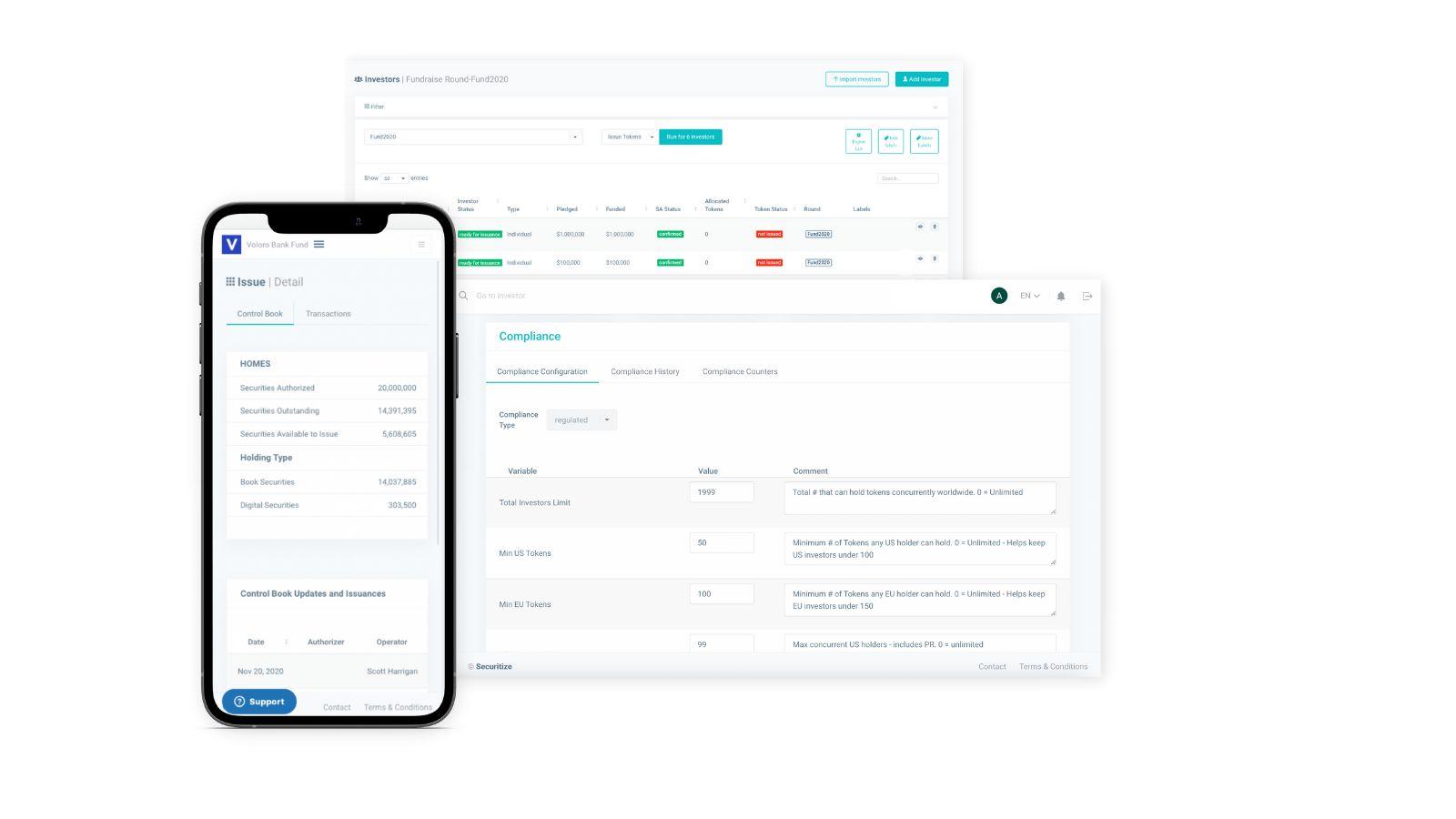
| Simplify distributions and dividend reinvestment plans.
| No per-transaction fees.

Request a demo and see how you can save up to 65% with our end-to-end funding and shareholder management solution.

VirTra, Inc., is a global provider of judgmental use of force training simulators and firearms training simulators. Our offerings target law enforcement, military, and commercial markets. We leverage patented technologies, software, and scenarios to deliver intense, real-world situational training in areas such as de-escalation, judgmental use-of-force, marksmanship, and more. Our mission is to improve and save lives globally through effective virtual reality and simulator technology.
Our firearms training simulator stands out due to its unique features, which enable scenario-based training without the need for live ammunition. These features include multi-screen, video-based scenarios, an exclusive scenario authoring capability, our patented Threat-Fire™ shoot-back system, and realistically powerful gas-powered simulated recoil weapons.
Our customers fall into two main categories: law enforcement and the military. Our strategy is to expand our market share and scope in these areas by enhancing our core business, increasing our total addressable market, and expanding our product offerings.
Our product portfolio is diverse and tailored to meet a variety of needs and budgets. It includes V-300™ , V-180™, and V-100™ simulators, each boasting unique features. For departmental training, we provide V-VICTA™ a curriculum solution, and STEP™, a subscriptionbased program for simulator access for smaller budgets.
With V-Author™ software, customers can create custom scenarios. In addition, we offer simulated recoil kits and the patented Threat-Fire™ device, designed to simulate real-world stress, along with several other innovative offerings.
VirTra’s operations are anchored in two main facilities: our long-standing base in Chandler, Arizona, and our new facility in Orlando, Florida, which came into operation in 2022. Orlando is recognized as the epicenter of the military simulation market, further strengthening our strategic positioning. We rely on local suppliers for sourcing the essential parts of our products. Our dynamic team of 121 full-time employees, as of March 2023, powers our mission.
2. wE’RE ABOUT HALF-wAy THROUgH 2023, wHAT ARE SOmE HIgHLIgHTS FOR THE COmPANy FOR THE FIRST HALF OF 2023?
Reflecting on the first half of 2023, I am pleased with the progress our team has made, but we have much more to accomplish. Building off the momentum of our 17th consecutive year of revenue growth and adding John Givens as Co-CEO, we’ve continued to push the envelope, reaching a milestone with a record quarterly revenue of $10 million in Q1.
Our strategic decision to add John Givens as CoCEO, centralize operations in Arizona, and add a new Orlando facility has played a significant role in accelerating our growth.

Our diverse portfolio of products and services and our

ability to adapt to the changing needs of our customers have played a pivotal role in our financial success. This is also reflected in our robust gross margin, an achievement that speaks to our strong operational control.
In terms of market sectors, we’ve observed a substantial increase in our government revenue, largely due to our enhanced performance in the law enforcement market and an increase in federal government contracts. Our international market has also made significant strides but has not yet achieved the level of sales we expect.
As we celebrate our 30th anniversary in 2023, with our industry leading products and investments, a clear vision and a dedicated team, we’re well positioned to capitalize on the opportunities that lie ahead and deliver increased value for our customers.
3. ARE THERE ANy INDUSTRy TAILwINDS TO PUSH FORwARD SOmE OF THE COmPANy’S gOALS AND OBJECTIvES FOR 2023?
The industry’s rising demand for realistic and effective de-escalation training solutions fits perfectly with our revolutionary V3™ technology. On top of that, we’re seeing broader acceptance of simulation training, especially in government, law enforcement, and military sectors, aligning with our goals of market expansion, including increased focus on the international market, which is still full of untapped potential. In terms of our military market focus, we’re setting our sights on the Department of Defense’s fiscal year ‘24.
Further, some customers want a budget-friendly option which led us to offer a recurring revenue model, called STEP (Subscription Training Equipment Partnership). This arrangement offers budget-conscious agencies access to our solutions, ensuring they get the best training. For us, it added a new recurring revenue source. It aligns well with our goal to increase effective training, increase recurring revenue, and further
reward our shareholders with steady, profitable growth.
All in all, we find ourselves in a promising position, backed by strong industry tailwinds that are propelling us towards our 2023 goals.
4. FROm wHAT yOU CAN TELL US, wHAT ARE SOmE OF THE COmPANy’S vALUE CATALySTS FOR THE REST OF 2023?
Many of the key value catalysts for the rest of 2023 are points we’ve touched on earlier in this conversation.
Our ongoing development of advanced, realistic training solutions is a crucial driver. With the success of our V3 technology, we plan on introducing even more innovative products that are poised to increase market share.
Second is the international market expansion strategy, which is expected to propel our growth significantly. We are currently delving deeper into this underserved and underpenetrated market segment. We’re especially anticipating meaningful traction in the military market as we focus on the Department of Defense in fiscal year ‘24.
Finally, the operational efficiencies we’ve been working on are slated to continue providing considerable benefits and visibility for the years ahead. Our investments in facilities, personnel, leadership, and systems aim to streamline operations, and we expect these efforts to continue to boost our productivity and financial performance.
Yes, we have had a strong start to 2023, but there is still so much work to be done. Our efforts have raised our performance standards and our expectations of what is possible, and I think our customers and shareholders are benefiting in a big way!
For more information about VirTra, Inc., please visit: www.virtra.com
DISCLAImER AND FORwARD-LOOkINg STATEmENTS NOTICE: This article is provided as a service of SNN inc. or an affiliate thereof (collectively “SNN”), and all information presented is for commercial and informational purposes only, is not investment advice, and should not be relied upon for any investment decisions. we are not recommending any securities, nor is this an offer or sale of any security. Neither SNN nor its representatives are licensed brokers, broker-dealers, market makers, investment bankers, investment advisers, analysts, or underwriters registered with the Securities and Exchange Commission (“SEC”) or with any state securities regulatory authority
SNN provides no assurances as to the accuracy or completeness of the information presented, including information regarding any specific company’s plans, or its ability to effectuate any plan, and possess no actual knowledge of any specific company’s operations, capabilities, intent, resources, or experience. any opinions expressed in this article are solely attributed to each individual asserting the same and do not reflect the opinion of SNN. information contained in this presentation may contain “forward-looking statements” as defined under Section 27a of the Securities act of 1933 and Section 21b of the Securities Exchange act of 1934. Forward-looking statements are based upon expectations, estimates, and projections at the time the statements are made and involve risks and uncertainties that could cause actual events to differ materially from those anticipated. Therefore, readers are cautioned against placing any undue reliance upon any forwardlooking statement that may be found in this article.
SNN did not receive compensation for, nor engage in, providing advice, making recommendations, issuing reports, or furnishing analyses on any of the companies, securities, strategies, or information presented in this article. SNN recommends you consult a licensed investment adviser, broker, or legal counsel before purchasing or selling any securities referenced in this article. Furthermore, it is encouraged that you invest carefully and consult investment related information available on the websites of the SEC at http://www.sec. gov and the Financial industry Regulatory authority (FiNRa) at http://finra.org.
Note: This article is not an attempt to provide investment advice. The content is purely the author’s personal opinions and should not be considered advice of any kind. Investors are advised to conduct their own research or seek the advice of a registered investment professional.
The SEC recently proposed a series of new rules which will significantly increase disclosure requirements that relate to: (1) climate related risks, (2) greenhouse gas emissions, and (3) climaterelated financial metrics. The SEC partly modeled the proposed climate disclosure framework on the
Of course, the real world is far more complicated. In my experience, seemingly all companies are convinced they did nothing wrong and have nothing to hide but very few are actually willing to go to trial to prove it. They have no appetite for litigation. This dynamic is only heightened when the litigation would be against FINRA or the SEC. Sure, lenders sue public companies when they default and both sides seem to have accepted that as a part of the lending process. But all parties involved in the microcap space seem to equally resent regulators, and tend to be understandably of even the existence of a lawsuit from a regulator.
This logic is sound. Say, for example, a private company is about to ramp up for an initial public offering after years of preparation. A lawsuit from SEC Enforcement can quickly dry up any hopes of that IPO, no matter how much merit such a lawsuit might truly have. This is why one of the first questions we ask when conducting initial intakes of clients is what their true appetite for litigation is. It is a question everyone in the microcap space really should ask themselves well before they even receive a subpoena from either the SEC or FINRA.
The thing is, there is a long, involved process that occurs prior to either the SEC or FINRA actually dropping a lawsuit. The investigation likely starts before you know about it. Subpoenas will go out to others who were tangentially involved. Testimony may be taken from these other parties. Eventually
Task Force on Climate Related Financial Disclosure (“TCFD”) and the Greenhouse Gas Protocol (“GHG Protocol”) emissions reporting framework. As a law firm focused on providing services and counsel to the microcap space, we fully embrace the challenge these new requirements pose for the microcap
the target receives a subpoena, but it will often be mistakenly perceived as innocent by the target. The SEC is only requesting some information or documents – and it isn’t as if the company in question did anything wrong (right?). Given how certain all of our clients tend to be about how they have nothing to hide because they did nothing wrong, it is at this point that the mistakes really start to be made. This is the point where, without experienced microcap securities litigation counsel, many clients actually seal their fate.
Sometimes it is best to cooperate and work with the regulators. Other times clients seem unaware that the SEC or FINRA has already made up their mind and plan to sue. It is in these situations that cooperation is plainly a mistake. To borrow a phrase, at this point anything you tell or give to the SEC or FINRA can and will be used against you in a court of law. So why do so many players in the microcap space handle this stage of a regulatory investigation on their own? Why do they just give regulators whatever they happen to ask for? Part of it is a practical choice. Retaining experienced microcap securities litigation counsel might be preferable, but most microcap companies aren’t flush with cash. In a liquidity crunch, outside litigation counsel is a luxury many can’t afford. So they have someone in the company, often the CFO handle it the best they can. The other reason is purely mental. Many have a hard time believing that the regulators, if shown everything, wouldn’t just drop the investigation.
ThE SEC’S NEw ENviRONMENTal, SOCial aND gOvERNaNCE (“ESg”) RulES
We hear it all the time. “There’s nothing to worry about. We didn’t do anything wrong.” It sounds good. It makes sense too – if in fact the client is correct that they didn’t do anything wrong.
We see this disconnect in almost every case. A company is certain that they did nothing wrong whatsoever, and genuinely do not understand why the investigation is still going. Clients show up all the time telling us that the investigation will be over shortly and the SEC will realize nothing happened and they’ll just drop the matter entirely. The next case we have where that actually happens will be the first. So on the one hand, we have clients completely convinced that the regulators will drop everything once they just see or hear everything there is to see. And on the other hand, you have the regulators who are fully convinced (yes, sometimes for good reason) that the company or individual in question actually violated a number of securities rules and laws. The regulators view these actions as very serious and believe that the people in question should be barred from the securities industry for years, or sometimes forever. They will seek large monetary amounts in addition to injunctions keeping people from, for example, serving as an officer or director, or licensed broker.
The problem is, of course, when the disconnect between clients who believe they did nothing wrong and the regulators who believe the conduct in question constitutes a serious violation of the law crash up against each other. This usually occurs as part of what is known as the Wells process. Whether or not to submit a Wells response is a question that deserves its own Legal Corner, but the takeaway is the same throughout the entire pre-Complaint phase. Anything you say (or provide) to the regulators can and will be used against you in a court of law.
If the case doesn’t settle, that means litigation. Meaning a Complaint, and everything between that and trial. Unfortunately, there will be motions along the way. The SEC will almost always try to win before the trial using a Motion for Summary Judgment. The best way to survive that motion is to testify well on depositions and not have provided anything damaging to the regulators that they can use against you as an “undisputed fact.” That is the

issue with the notion that giving the SEC everything its asks for pre-Complaint can’t hurt. It hurts when you get to summary judgment. It hurts at trial. We have faced countless motions where the SEC relies largely on materials and testimony freely given over to it by the company in question pre-Complaint.

Fighting regulators in court is hard enough without giving them a head start. The entire process is important, from the first day you find out about it through settlement or trial. The potential penalties are extreme. There will always be the natural urge to just give the regulators whatever they want, since you – like every other client – didn’t do anything wrong. The monetary pressure to go the cheaper route will be there. But the difference in winning or losing a case is often the mistakes clients make during the pre-trial process. Get experienced microcap securities litigation counsel such as PULLP involved as soon as possible.
We invite you to contact uretsky@pullp.com or call
PULLP, “The Microcap Litigators” is one of the only law firms specializing in microcap litigation. Jon Uretsky is the founding and managing partner of PULLP. Mr. Uretsky has a broad multidisciplinary practice that includes extensive experience in litigation and dispute resolution, regulatory investigations (including FINRA and SEC matters like those described above). In addition, he counsels corporate boards, board committees (including special committees) as well as being a personal adviser to many entrepreneurs, business leaders and corporate executives. He has counseled clients on significant litigation, regulatory and transactional matters across multiple industry sectors. Additionally, the PULLP team has extensive experience negotiated mergers and acquisitions (including reverse mergers); domestic and cross-border investments/joint ventures; the representation of private equity; venture capital and other private investment funds; securities offerings; and private and public financings. www.PULLP.com
Notes:
1. Special thanks to Anna Adelstein for her assistance in the preparation of this article, as well as her work in the many matters PULLP handles.
2. This article is not an attempt to provide investment advice. The content is purely the author’s personal opinions and should not be considered advice of any kind. Investors are advised to conduct their own research or seek the advice of a registered investment professional.

We posed several questions to Claire Aitchison to help guide our understanding of sponsored research and how Independent Investment Research utilizes its market experience in providing quality research reports for microcap public company issuers and institutional and retail investors.
In many instances, if not for sponsored research the alternative is no research coverage at all!
I’ve worked in investment markets for over 15 years now covering a range of asset classes including equities, funds, structured products and hybrid securities. I’ve been with Independent Investment Research pretty much since its inception during which time I’ve covered over 100 companies across a range of sectors including industrials, financials biotech and property.
Those that are producing research on companies that they are raising capital for can result in overly optimistic price targets. Given independent research is not partaking in capital formation, investor relations, receiving equity or generating revenue from the company through other activities, we can look at a company objectively and provide an assessment of a company that does not have to take into account the bottom line for other internal service departments.
One of the best things about doing sponsored
research is you get to see a diverse range of companies and meet a lot of great people who are doing some amazing things. The biotech sector is a great example of this. Some of the R&D work being done by these companies has the potential to lead to some life changing outcomes for people. By doing research on life sciences companies, our experts recognize the forward looking potential of the science and the ramifications for humankind. Albeit the time from discovery to regulatory approvals and commercialization can take years, research reports analysing a company’s potential as well as the risks are invaluable to investors.
We maintain independence by the removing the prospect of influence. Companies are required to pay up front so that there can be no potential influence on the outcome. They can choose not to publish the report however they cannot withhold payment to try and get a more positive outcome.
I’m pretty cautious on markets at the moment given inflation is still well above the preferred bands of 2%-3% in a number of countries. Recent and potentially additional interest rate hikes will likely put pressure on economic growth in the near-term. With some markets trading near their all-time highs, I am certainly bracing for some volatility.
Microcap stocks have been hit particularly hard in
the last 18-months with the inflationary environment and forecast economic headwinds resulting in the reallocation of portfolios to more defensive style stocks, including those with strong balance sheets and liquidity. Since hitting highs in February 2021, the Dow Jones U.S Microcap Total Stock Market Index is down over 40%. This compares to the Dow Jones U.S Large Cap Total Stock Market Index which is up 10% over the same period. Given the decline in microcap stocks there is no doubt there is some great value to be found, however given the economic headwinds I would be looking for companies that are well capitalised so they can ride out any market weakness or volatility.
The return on investment from sponsored research for a company is difficult to calculate given it will depend on the outcome of the research and the use of the research by the company as well as the interest shown by the readers that access the research through the distribution networks. Research can be very valuable in terms of getting a company’s story and potential value out to a broad range of potential investors, however research is typically most effective when combined with other tools such as conferences and other stakeholder engagement activities.
You can compare the performance of a company before and after a report is published and distributed through the various retail and institutional channels, however volume as opposed to the movement in the share price is where you can see the value of the research report. In the microcap space, there is limited quality research available and a number of names that investors would not have heard of without a research report coming across their desk. Whether the share price goes up or down will ultimately come down to whether management executes on the strategy and grows the earnings of a company, however there are a lot of great microcap companies that have a great story and earnings potential that are yet to be noticed because they are buried in the pack. This is where research and access to the distribution networks can be very valuable for companies.
ONCE IIR IS ENgAgED TO wRITE RESEARCH wHAT mUST THE COmPANy PROvIDE TO IIR? wHAT IS THE TImINg FROm START TO FINISH?
We use a combination of information provided by the companies and publicly available information to undertake the research on a company. While our models and forecasts will include information garnered from our discussions with management and information provided by companies, we create all our valuation models and analyse information independently. With regards to timing, reports are usually delivered 6 to 8 weeks after a contract is signed, however this may vary depending on the availability of information and management.
The most frustrating part of the job is when you put in all the work on a company and then the company elects not to publish the report as the outcome is not favourable. One of the realities of our sponsored research is that given the company has paid for the research they can elect not to have it published, which happens more than one might think. Companies will often elect not to publish research if our valuation comes in well below that of existing price targets in the marketplace. Of course, you’re not going to publish something that suggests a different value than what we view to be an overly optimistic view of a company, however it can be frustrating when your assessment is correct, and investors potentially lose money from an investment as they didn’t have access to independent research.
Claire has over 15 years’ experience as an analyst specialising in equities and managed investments. Claire commenced her career with the Aegis Group (sold to Morningstar in 2009) as an analyst in 2005 specialising in equities, fixed interest and hybrid research. She also was part of the team that studied listed managed investments and unlisted funds. She has a Bachelor of Commerce with Distinction and a Grad Diploma in Accounting from Deakin University. Claire now supervises all the research outputs across for the firm except for Metals & Mining.
Claire Aitchison Head of Equities & Funds Research Independent Investment ResearchMelbourne
Ph: +61 413 796 022
IIR was established in 2004 to provide investment research to the investment industry including both issuers, Wealth Management firms and Institutional firms. IIR specialises in providing high quality commissioned equities and funds research. IIR provides customers and subscribers unparalleled research that covers listed and unlisted managed investments, resource companies, structured related products, and IPO’s. IIR takes great pride on the quality and independence of the research analysis, underpinned by the high calibre staff and transparent research methodology. IIR does not participate in dealing in securities, investor relations and corporate advisory services and only provides research services to issuers, wealth managers and institutional clients.
Most of the other microcap indices are market cap weighted, giving preference to larger companies with higher trading volumes, and are reconstituted bi-annually or annually, versus quarterly.
In my experience in the MicroCap space, the idea of “discovery” has been a singular driving force for me. Whether its helping folks discover new MicroCap investing strategies or discover new companies that may not show on their screen.
• U.S. (NYSE/AMEX, NASDAQ, OTCM) or Canada (TSX, TSX Venture, CSE, NEO)
• Primary Listing only (meaning, primary symbol dual-listed companies
• On the final day of the quarter, all public companies:
º Between $10 and $300 million in Market Capitalization
º Share price equal to or greater than $0.10
• Filed a 10Q or 10K in the preceding quarter
From there, the index comprises the Top 50 companies from each sector based on 90-day share price appreciation. At most, MCRI will consist of 550 constituents, all equally weighted. While you may expect most, if not all, the Top 30 for each sector will have positive share price appreciation for the quarter, but that’s not always the case, and in my opinion what makes MCRI the purest index for MicroCaps.
The MCRI is as pure an index for microcap stocks as can be. We believe the MCRI provides a much more accurate, in-depth, benchmark of the microcap stock universe, with equal weighting given across the board, regardless of size.
• U.S. (NYSE/AMEX, Nasdaq, OTCM) or Canada (TSX, TSX Venture, CSE, NEO)


• Primary Listing Only
• Average Daily Trading Value of $25,000 or more in the preceding 3 months
• All public companies between $10 and $300 million in market capitalization
• File a 10Q Or 10K in the preceding quarter
• The index comprses the Top 50 companies from each sector based on share price appreciation
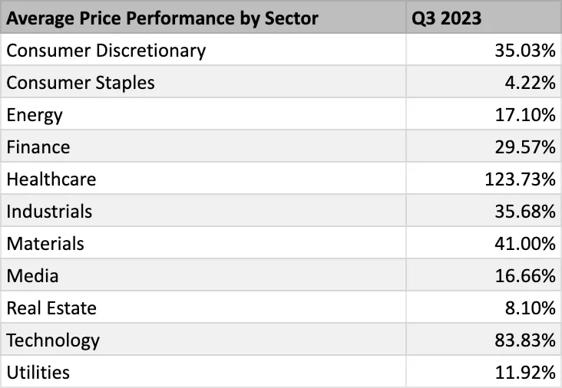
- As of rebalance date July 3, 2023
- Final inclusion determination is affected by available information as per our calculation agent
- No compensation is paid or will be accepted for inclusion in the Planet MicroCap Index
TOP PERFORmINg NEw CONSTITUENTS FROm EACH SECTOR
By SECTOR
AACG ATA Creativity Global
Consumer Staples
AAOI Applied Optoelectronics Inc.
Technology
ACR ACRES Commercial Realty Corp.
Real Estate
ACRX AcelRx Pharmaceuticals Inc.
Healthcare
ACU Acme United Corporation.
Consumer Staples
ADN Advent Technologies Holdings Inc.
Utilities
ADN:CA Acadian Timber Corp.
Materials
ADTH AdTheorent Holding Company Inc.
Media
ADVM Adverum Biotechnologies Inc.
Healthcare
ADW.A:CA Andrew Peller Limited/Andrew Peller Limitee Class A Non-voting Shares
Consumer Staples
AEP:CA Atlas Engineered Products Ltd.
Industrials
AFCG AFC Gamma Inc.
Real Estate
AFRI Forafric Global PLC
Consumer Staples
AHI Advanced Health Intelligence Ltd ADS
Technology
AHT Ashford Hospitality Trust Inc
Real Estate
AIP Arteris Inc.
Technology
AKBA Akebia Therapeutics Inc.
Healthcare
ALCO Alico Inc.
Consumer Staples
ALLI:AQL ALPHA LITHIUM CORPORATION
Materials
ALTO Alto Ingredients Inc.
Materials
AMPY Amplify Energy Corp.
Energy
AMSC American Superconductor Corporation
Industrials
AMTX Aemetis Inc
Energy
AOMR Angel Oak Mortgage REIT Inc.
Real Estate
AP Ampco-Pittsburgh Corporation
Industrials
APCX AppTech Payments Corp. Technology
APEI American Public Education Inc.
Consumer Staples
APYX Apyx Medical Corporation
Healthcare
AQMS Aqua Metals Inc.

Industrials
AREC American Resources Corporation
Materials
AREN The Arena Group Holdings Inc.
Media
ARKR Ark Restaurants Corp.
Consumer Discretionary
ARR:CA Altius Renewable Royalties Corp.
Utilities
ARTW Art’s-Way Manufacturing Co. Inc.
Industrials
ASPS Altisource Portfolio Solutions S.A.
Real Estate
ASST Asset Entities Inc.
Media
ASTC Astrotech Corporation
Industrials
ATLX Atlas Lithium Corporation
Materials
ATOM Atomera Incorporated
Technology
ATOS Atossa Therapeutics Inc.
Healthcare
AUGX Augmedix Inc.
Healthcare
AUID AuthID Inc Com (New) Technology
AYRO AYRO Inc.
Consumer Discretionary
BABY:CA Else Nutrition Holdings Inc.
Consumer Staples
BAER Bridger Aerospace Group Holdings Inc Com
Industrials
BAOS Baosheng Media Group Holdings Limited
Media
BBB:CA Brixton Metals Corporation
Materials
BBGI Beasley Broadcast Group Inc.
Media
BDL Flanigan’s Enterprises Inc.
Consumer Discretionary
BDTX Black Diamond Therapeutics Inc.
Healthcare
BFI BurgerFi International Inc
Consumer Discretionary
BGFV Big 5 Sporting Goods Corporation
Consumer Discretionary
BHIL Benson Hill Inc.
Materials
BHR Braemar Hotels & Resorts Inc.
Real Estate
BIG Big Lots Inc.
Consumer Staples
BLDE Blade Air Mobility Inc.
Industrials
BLIN Bridgeline Digital Inc.
Technology
BLN:CA Blackline Safety Corp.
Technology
BLRX BioLineRx Ltd.
Healthcare
BMR Beamr Imaging Ltd.
Technology
BODY The Beachbody Company Inc. Class A
Media
BOSC B.O.S. Better Online Solutions
Technology
BQ Boqii Holding Limited American Depositary Shares representing Class A
Consumer Discretionary
BRAG:CA Bragg Gaming Group Inc.
Media
BRE:CA Bridgemarq Real Estate Services Inc. Restricted Voting Shares
Real Estate
BRID Bridgford Foods Corporation
Consumer Staples
BRN Barnwell Industries Inc.
Energy
BRO:CA Barksdale Resources Corp.
Materials
BTB.UN:CA BTB Real Estate Investment Trust
Real Estate
BTCM BIT Mining Limited ADS
Finance
BVS Bioventus Inc.
Healthcare
CBAT CBAK Energy Technology Inc.
Industrials
CBIT:CA Cathedra Bitcoin Inc.
Finance
CBNK Capital Bancorp Inc.
Finance
CCEL Cryo-Cell International, Inc.
Healthcare
CCLP CSI Compressco LP
Energy
CDLX Cardlytics Inc.
Media
CDRO Codere Online Luxembourg S.A.
Consumer Discretionary
CDZI Cadiz Inc.
Utilities
CERT:CA Cerrado Gold Inc.
Materials
CHCI Comstock Holding Companies Inc.
Real Estate
CHEK Check-Cap Ltd.
Healthcare
CHKR Chesapeake Granite Wash Trust Units
Energy
CHMI Cherry Hill Mortgage Investment Corporation
Real Estate
CIH China Index Holdings Limited
Media
CIO City Office REIT Inc.
Real Estate
CIX CompX International Inc.
Industrials
CLEU China Liberal Education Holdings Limited
Consumer Staples
CLIR ClearSign Technologies Corporation
Industrials
CLPR Clipper Realty Inc.
Real Estate
CLWT Euro Tech Holdings Company Limited
Industrials
CMCM Cheetah Mobile Inc. American Depositary Shares each representing fifty (50) Class A
Media
CMCT Creative Media & Community Trust Corporation
Real Estate
CMLS Cumulus Media Inc.
Media
CMT Core Molding Technologies Inc
Materials
CN:CA Condor Resources Inc.
Materials
CNF CNFinance Holdings Limited American Depositary Shares each representing twenty (20)
Finance
CNTG Centogene N.V.
Healthcare
CNTX Context Therapeutics Inc.
Healthcare
CODA Coda Octopus Group Inc.
Industrials
COE 51 Talk Online Education Group
Consumer Staples
CORR CorEnergy Infrastructure Trust Inc.
Real Estate

CPS:CA Canadian Premium Sand Inc.
Materials
CPSS Consumer Portfolio Services Inc.
Finance
CRDL:CA Cardiol Therapeutics Inc.
Healthcare
CREG Smart Powerr Corp.
Utilities
CREX Creative Realities Inc.
Technology
CRNT Ceragon Networks Ltd.
Technology
CRT Cross Timbers Royalty Trust
Energy
CRVS Corvus Pharmaceuticals Inc.
Healthcare
CSBR Champions Oncology Inc.
Healthcare
CSTE Caesarstone Ltd.
Industrials
CTIB Yunhong CTI Ltd.
Consumer Discretionary
CXAI CXApp Inc.
Technology
CXDO Crexendo Inc.
Media
CYTH Cyclo Therapeutics Inc.
Healthcare
DALN DallasNews Corporation
Media
DC.A:CA Dundee Corporation Class A Subordinate Voting Shares
Consumer Staples
DCM:CA Data Communications Management Corp.
Industrials
DII.B:CA Dorel Industries Inc. Class B Subordinate Voting Shares
Consumer Discretionary
DIT AMCON Distributing Company
Consumer Staples
DLPN Dolphin Entertainment Inc.
Media
DMAC DiaMedica Therapeutics Inc.
Healthcare
DOUG Douglas Elliman Inc.
Real Estate
DRCT Direct Digital Holdings Inc.
Media
DRX:CA ADF Group Inc. Subordinate Voting Shares
Industrials
DSHK Drive Shack Inc.
Consumer Discretionary
DSS DSS Inc.
Consumer Discretionary
DTST Data Storage Corporation
Technology
DUOT Duos Technologies Group Inc - Ordinary Shares
Technology
DXYN The Dixie Group Inc.
Consumer Discretionary
DYA:CA dynaCERT Inc.
Industrials
EARN Ellington Residential Mortgage REIT of Beneficial Interest
Real Estate
EDTK Skillful Craftsman Education Technology Limited
Consumer Staples
EEIQ EpicQuest Education Group International Limited
Consumer Staples
EEX Emerald Holding Inc.
Media
EFTR eFFECTOR Therapeutics Inc.
Healthcare
ELA Envela Corporation
Consumer Discretionary
ELTK Eltek Ltd.
Technology
ELTX Elicio Therapeutics Inc.
Healthcare
EMPR:CA Empress Royalty Corp.
Materials
EPM Evolution Petroleum Corporation Inc.
Energy
EPSN Epsilon Energy Ltd.
Energy
ESEA Euroseas Ltd.

Industrials
ESK:CA Eskay Mining Corp.
Materials
ESN:CA Essential Energy Services Ltd.
Energy
ESOA Energy Services of America Corporation
Industrials
EVI EVI Industries Inc.
Industrials
EYPT EyePoint Pharmaceuticals Inc.
Healthcare
FAZE FaZe Holdings Inc.
Media
FCAP First Capital Inc.
Finance
FCD.UN:CA Firm Capital Property Trust
Real Estate
FDBC Fidelity D & D Bancorp Inc.
Finance
FENG Phoenix New Media Limited American Depositary Shares each representing 48 Class A.
Media
FET Forum Energy Technologies Inc.
Energy
FGPR Ferrellgas Partners L.P Unit
Energy
FNGR FingerMotion Inc.
Media
FOA Finance of America Companies Inc. Class A
Finance
FPAY FlexShopper Inc.
Finance
FRD Friedman Industries Inc.
Materials
FREE Whole Earth Brands Inc.
Consumer Staples
FRZA Forza X1 Inc.
Consumer Discretionary
FSP Franklin Street Properties Corp.
Real Estate
FSTR L.B. Foster Company
Industrials
FTFT Future FinTech Group Inc.
Technology
FTG:CA Firan Technology Group Corporation
Industrials
FTHM Fathom Holdings Inc.
Real Estate
FTK Flotek Industries Inc.
Energy
FUSB First US Bancshares Inc.
Finance
FWZ:CA Fireweed Metals Corp.
Materials
GAN GAN Limited
Consumer Discretionary
GASS StealthGas Inc.
Industrials
GCL:CA Colabor Group Inc.
Consumer Staples
GEOS Geospace Technologies Corporation
Energy
GETR Getaround Inc.

Technology
GGT Gabelli Multi-Media Trust Inc. (The)
Finance
GH:CA Gamehost Inc.
Consumer Discretionary
GHL Greenhill & Co. Inc.
Finance
GIP:CA Green Impact Partners Inc.
Utilities
GIPR Generation Income Properties Inc.
Real Estate
GLBZ Glen Burnie Bancorp
Finance
GMDA Gamida Cell Ltd.
Healthcare
GMG:CA Graphene Manufacturing Group Ltd.
Materials
GMGI Golden Matrix Group Inc.
Media
GPMT Granite Point Mortgage Trust Inc.
Real Estate
GRAT:CA Gratomic Inc.
Materials
GRCL Gracell Biotechnologies Inc.
Healthcare
GRNQ Greenpro Capital Corp.
Industrials
GROV Grove Collaborative Holdings Inc. Class A
Consumer Staples
GROW U.S. Global Investors Inc.
Finance
GRPN Groupon Inc.
Media
GRZ:CA Gold Reserve Inc.
Materials
GSHR:CA Goldshore Resources Inc.
Materials
GSI:CA Gatekeeper Systems Inc.
Industrials
GSIT GSI Technology Inc.
Technology
GTIM Good Times Restaurants Inc.
Consumer Discretionary
GURU:CA GURU Organic Energy Corp.
Consumer Staples
GXE:CA Gear Energy Ltd.
Energy
HC:AQL HYPERCHARGE NETWORKS CORP.
Consumer Discretionary
HEAT:CNX Hillcrest Energy Technologies Ltd.
Energy
HEO:CA H2O Innovation Inc.
Utilities
HFFG HF Foods Group Inc.
Consumer Staples
HGBL Heritage Global Inc.
Finance
HIHO Highway Holdings Limited
Industrials
HLGN Heliogen Inc.
Utilities
HME:CA Hemisphere Energy Corporation
Energy
HMR:CA Homerun Resources Inc.
Materials
HNST The Honest Company Inc.
Consumer Staples
HOFV Hall of Fame Resort & Entertainment Company
Consumer Discretionary
HOLO MicroCloud Hologram Inc.
Technology
HOT.UN:CA American Hotel Income Properties REIT LP
Real Estate
HRTG Heritage Insurance Holdings Inc.
Finance
HSTR:CA Heliostar Metals Ltd.

Materials
HT Hersha Hospitality Trust Class A of Beneficial Interest
Real Estate
HTCR Heartcore Enterprises Inc.
Technology
HTOO Fusion Fuel Green PLC
Utilities
HUDI Huadi International Group Co. Ltd.
Materials
HWO:CA High Arctic Energy Services Inc.
Energy
HYZN Hyzon Motors Inc.
Consumer Discretionary
ID PARTS iD Inc. Class A
Consumer Discretionary
IDR Idaho Strategic Resources Inc.
Materials
IFRX InflaRx N.V.
Healthcare
IH iHuman Inc. American depositary shares each representing five Class A Consumer Staples
IHT InnSuites Hospitality Trust Shares of Beneficial Interest
Real Estate
IKNA Ikena Oncology Inc.
Healthcare
ILLM:CA illumin Holdings Inc.
Media
IMUX Immunic Inc.
Healthcare
INO.UN:CA Inovalis Real Estate Investment Trust
Real Estate
INTT inTest Corporation
Technology
INVE Identiv Inc.
Technology
IPVF InterPrivate III Financial Partners Inc. Class A
Finance
IPWR Ideal Power Inc.
Industrials
IPX IperionX Limited
Materials
IREN Iris Energy Limited
Finance
ISIG Insignia Systems Inc.
Media
IZEA IZEA Worldwide Inc.
Media
IZM ICZOOM Group Inc.
Technology
JAKK JAKKS Pacific Inc.
Consumer Discretionary
JEWL Adamas One Corp.
Consumer Discretionary
JFIN Jiayin Group Inc.
Media
JOB GEE Group Inc.
Industrials
KAVL Kaival Brands Innovations Group Inc.
Consumer Staples
KEI:CA Kolibri Global Energy Inc.
Energy
KLX:CA Klimat X Developments Inc.
Materials
KNDI Kandi Technologies Group Inc.
Consumer Discretionary
KOPN Kopin Corporation
Technology
KORE KORE Group Holdings Inc.
Media
KPLT Katapult Holdings Inc.
Technology
KPT:CA KP Tissue Inc.
Consumer Staples
LAS.A:CA Lassonde Industries Inc. Class A Subordinate Voting Shares
Consumer Staples
LBPH Longboard Pharmaceuticals Inc.
Healthcare
LEE Lee Enterprises Incorporated
Media
LEJU Leju Holdings Limited American Depositary Shares each representing
one
Real Estate
LFCR Lifecore Biomedical Inc.
Healthcare
LFE:CA Canadian Life Companies Split Corp. Class A Shares
Finance
LFMD LifeMD Inc.
Healthcare
LFT Lument Finance Trust Inc.
Real Estate
LFVN Lifevantage Corporation
Consumer Staples
LIFT:CNX Li-FT Power Ltd.
Materials
LINC Lincoln Educational Services Corporation
Consumer Staples
LITM Snow Lake Resources Ltd.
Materials
LIZI LIZHI INC.
Media
LMB Limbach Holdings Inc.
Industrials
LME:CA Laurion Mineral Exploration Inc.
Materials
LMNR Limoneira Co
Consumer Staples
LNSR LENSAR Inc.
Healthcare
LOAN Manhattan Bridge Capital Inc
Real Estate
LODE Comstock Inc.
Materials
LONE:CA Lithium One Metals Inc.
Energy
LTBR Lightbridge Corporation
Industrials
LTCH Latch Inc.
Technology
LTH:CA Lithium Ionic Corp.
Materials
LTHM:CNX Champion Electric Metals Inc Com
Materials
LUCA:CA Luca Mining Corp.
Materials
LUXH LuxUrban Hotels Inc.
Consumer Discretionary
LVLU Lulu’s Fashion Lounge Holdings Inc.
Consumer Discretionary
LVO LiveOne Inc.
Media
LWAY Lifeway Foods Inc.
Consumer Staples
LYRA Lyra Therapeutics Inc.
Healthcare
MATH Metalpha Technology Holding Limited
Media
MCB:CA McCoy Global Inc.
Energy
MCHX Marchex Inc.
Media
MDF:CA mdf commerce inc.
Media
MDJH MDJM LTD
Real Estate
MDWT Midwest Holding Inc.
Finance
MEOA Minority Equality Opportunities Acquisition Inc.
Finance
MFG:CA Mayfair Gold Corp.
Materials
MFH Mercurity Fintech Holding Inc.
Finance
MG Mistras Group Inc
Industrials
MGA:CA Mega Uranium Ltd.
Energy
MGOL MGO Global Inc.
Media
MGRX Mangoceuticals Inc.
Healthcare
MINM Minim Inc
Technology
MITT
AG Mortgage Investment Trust Inc.
Real Estate
MKFG Markforged Holding Corporation
Technology
MKUL Molekule Group Inc.
Industrials
MLP Maui Land & Pineapple Company Inc.
Real Estate
MMMB MamaMancini’s Holdings Inc.
Consumer Staples
MMV MultiMetaVerse Holdings Limited
Media
MR.UN:CA Melcor Real Estate Investment Trust
Real Estate

MRAM Everspin Technologies Inc.
Technology
MRCC Monroe Capital Corporation
Finance
MRKR Marker Therapeutics Inc.
Healthcare
MRZ:CA Mirasol Resources Ltd.
Materials
MSVB Mid-Southern Bancorp Inc.
Finance
MTR Mesa Royalty Trust
Energy
MVLA Movella Holdings Inc.
Technology
MVO MV Oil Trust
Energy
MXC Mexco Energy Corporation
Energy
MXG:CA Maxim Power Corp.
Utilities
NA Nano Labs Ltd
Technology
NAII Natural Alternatives International Inc.
Consumer Staples
NATR Nature’s Sunshine Products Inc.
Consumer Staples
NBM:CA NEO Battery Materials Ltd.
Materials
NC NACCO Industries Inc.
Energy
NCMI National CineMedia Inc.
Media
NCRA Nocera Inc.
Consumer Staples
NCTY The9 Limited
Media
NECB NorthEast Community Bancorp Inc.
Finance
NEOV NeoVolta Inc.
Industrials
NERV Minerva Neurosciences Inc
Healthcare
NET.UN:CA Canadian Net Real Estate Investment Trus
Real Estate
NGMD:CA Nugen Medical Devices Inc.
Finance
NGS Natural Gas Services Group Inc.
Energy
NGVC Natural Grocers by Vitamin Cottage Inc.
Consumer Staples
NHK:CA Nighthawk Gold Corp.
Materials
NHTC Natural Health Trends Corp.
Consumer Discretionary
NKG:CA Nevada King Gold Corp.
Materials
NNBR NN Inc.
Industrials
NREF NexPoint Real Estate Finance Inc - Ordinary Shares
Real Estate
NRT North European Oil Royality Trust
Energy
NSPR InspireMD Inc.
Healthcare
NTPIF Nam Tai Property Inc.
Real Estate
NTZ Natuzzi S.p.A.
Consumer Discretionary
NXGL NexGel Inc
Healthcare
NXPL NextPlat Corp
Technology
NYC American Strategic Investment Co. Class A
Real Estate
OB Outbrain Inc.
Media
OCN Ocwen Financial Corporation
Finance
OIII:CA O3 Mining Inc.

Materials
OMEX Odyssey Marine Exploration Inc.
Industrials
OMH Ohmyhome Limited
Real Estate
ONC:CA Oncolytics Biotech Inc.
Healthcare
ONTX Onconova Therapeutics Inc.
Healthcare
OPHR:CA Ophir Gold Corp.
Materials
OPRT Oportun Financial Corporation
Finance
OPTT Ocean Power Technologies Inc.
Industrials
ORC.B:CA Orca Energy Group Inc.
Energy
ORMP Oramed Pharmaceuticals Inc.
Healthcare
OSI Osiris Acquisition Corp. Class A
Finance
OVBC Ohio Valley Banc Corp.
Finance
OZ Belpointe PREP LLC Class A Units
Real Estate
PBPB Potbelly Corporation
Consumer Discretionary
PCYG Park City Group Inc.
Technology
PCYO Pure Cycle Corporation
Utilities
PDLB Ponce Financial Group Inc.
Finance
PEA:CA Pieridae Energy Limited
Energy
PETZ TDH Holdings Inc.
Consumer Staples
PEV Phoenix Motor Inc.
Consumer Discretionary
PEX:CA Pacific Ridge Exploration Ltd.
Materials
PFIE Profire Energy Inc.
Energy
PHX PHX Minerals Inc.
Energy
PIF:CA Polaris Renewable Energy Inc.
Utilities
PINE Alpine Income Property Trust Inc.
Real Estate
PKOH Park-Ohio Holdings Corp.
Industrials
PKT:CA Parkit Enterprise Inc.
Real Estate
PLSE Pulse Biosciences Inc
Healthcare
PNRG PrimeEnergy Resources Corporation
Energy
PPSI Pioneer Power Solutions Inc.
Industrials
PRST Presto Automation Inc.
Technology
PRV.UN:CA PRO Real Estate Investment Trust
Real Estate
PSTL Postal Realty Trust Inc. Class A
Real Estate
PVBC Provident Bancorp Inc.
Finance
PVL Permianville Royalty Trust Trust Units
Energy
PWM:CA Power Metals Corp.
Materials
PWOD Penns Woods Bancorp Inc.
Finance
QBTS D-Wave Quantum Inc.
Technology
QH Quhuo Limited
Technology
QUIK QuickLogic Corporation
Technology
RAVE Rave Restaurant Group Inc.
Consumer Discretionary
RCMT RCM Technologies Inc.
Industrials
RCON Recon Technology Ltd.
Energy
RDCM Radcom Ltd.

Media
REAL The RealReal Inc.
Consumer Discretionary
REE REE Automotive Ltd.
Consumer Discretionary
REFI Chicago Atlantic Real Estate Finance Inc.
Real Estate
REKR Rekor Systems Inc.
Technology
RGCO RGC Resources Inc.
Utilities
RGF The Real Good Food Company Inc.
Consumer Staples
RGLS Regulus Therapeutics Inc.
Healthcare
RGTI Rigetti Computing Inc.
Technology
RHC:CA Royal Helium Ltd.
Energy
RM Regional Management Corp.
Finance
RMBI Richmond Mutual Bancorporation Inc.
Finance
RMBL RumbleOn Inc.
Consumer Discretionary
RMCF Rocky Mountain Chocolate Factory Inc.
Consumer Staples
RML:CA Rusoro Mining Ltd.
Materials
RMTI Rockwell Medical Inc.
Healthcare
RNGR Ranger Energy Services Inc. Class A
Energy
ROOT Root Inc.
Finance
ROSE Rose Hill Acquisition Corporation
Finance
RVYL Ryvyl Inc.
Technology
SABS SAB Biotherapeutics Inc.
Healthcare
SACH Sachem Capital Corp.
Real Estate
SAI SAI.TECH Global Corporation
Finance
SALM Salem Media Group Inc.
Media
SALT:CA Atlas Salt Inc.
Materials
SAMG Silvercrest Asset Management Group Inc.
Finance
SANW S&W Seed Company
Consumer Staples
SBNY Signature Bank
Finance
SCOT:CA Scottie Resources Corp.
Materials
SDA SunCar Technology Group Inc.
Finance
SDOT Sadot Group Inc.
Consumer Discretionary
SDPI Superior Drilling Products Inc.
Energy
SEEL Seelos Therapeutics Inc.
Healthcare
SEI:CA Sintana Energy Inc.
Energy
SELF Global Self Storage Inc.
Real Estate
SEVN Seven Hills Realty Trust
Real Estate
SFT Shift Technologies Inc.
Consumer Discretionary
SGA Saga Communications Inc.
Media
SGC Superior Group of Companies Inc.
Consumer Discretionary
SGMA SigmaTron International Inc.
Technology
SHLE:CA Source Energy Services Ltd.
Energy
SHPW Shapeways Holdings Inc.
Industrials
SIEB Siebert Financial Corp.
Finance
SIEN Sientra Inc.
Healthcare
SLNG Stabilis Solutions Inc.
Energy
SLNO Soleno Therapeutics Inc.
Healthcare
SMID Smith-Midland Corporation
Materials
SMLP Summit Midstream Partners LP Representing Limited Partner
Interests
Energy
SNAL Snail Inc.
Media
SNAX Stryve Foods Inc.
Consumer Staples
SNFCA Security National Financial Corporation Class A Common Stock
Finance
SNMPD Evolve Transition Infrastructure LP
Energy
SOHO Sotherly Hotels Inc.
Real Estate
SOU:CA Southern Energy Corp.
Energy
SRL Scully Royalty Ltd.
Finance
SSBI Summit State Bank
Finance
STBX Starbox Group Holdings Ltd.
Media
STEP:CA STEP Energy Services Ltd.
Energy
STHO Star Holdings

Real Estate
STKH Steakholder Foods Ltd.
Consumer Staples
STRS Stratus Properties Inc.
Real Estate
SUNN:CNX SolarBank Corporation
Utilities
SUPV Grupo Supervielle S.A. American Depositary Shares each Representing five Class B shares
Finance
SURG SurgePays Inc.
Technology
SUU:CA Strathmore Plus Uranium Corp.
Energy
SVT Servotronics Inc.
Industrials
SWAG Stran & Company Inc.
Media
SYZ:CA Sylogist Ltd.
Technology
TACT TransAct Technologies Incorporated
Technology
TALK Talkspace Inc.
Healthcare
TAO:CA TAG Oil Ltd.
Energy
TAST Carrols Restaurant Group Inc.
Consumer Discretionary
TATT TAT Technologies Ltd.
Industrials
TAYD Taylor Devices Inc.
Industrials
TBRD:CA Thunderbird Entertainment Group Inc.
Media
TC TuanChe Limited
Media
TCX Tucows Inc.
Technology
TEDU Tarena International Inc.
Consumer Staples
THRN Thorne Healthtech Inc.
Consumer Staples
TISI Team Inc.
Industrials
TKLF Yoshitsu Co. Ltd
Consumer Staples
TMC:CA Trench Metals Corp.
Energy
TNZ:CA Tenaz Energy Corp.
Energy
TORO Toro Corp.
Industrials
TRUE TrueCar Inc.
Media
TRZ:CA Transat A.T. Inc. Voting and Variable Voting Shares
Consumer Discretionary
TSQ Townsquare Media Inc. Class A
Media
TTP Tortoise Pipeline & Energy Fund Inc.
Finance
TTSH Tile Shop Holdings Inc.
Consumer Discretionary
TUSK Mammoth Energy Services Inc.
Industrials
TVC Tennessee Valley Authority
Utilities
TWIN Twin Disc Incorporated
Industrials
TXP:CA Touchstone Exploration Inc.
Energy
TZOO Travelzoo
Media
UG United-Guardian Inc.
Consumer Staples
UIHC United Insurance Holdings Corp.
Finance
ULBI Ultralife Corporation
Industrials
UONEK Urban One Inc.
Media
USAP Universal Stainless & Alloy Products Inc.
Materials
UTI Universal Technical Institute Inc
Consumer Staples
UTME UTime Limited Technology
VEEE Twin Vee PowerCats Co.
Consumer Discretionary
VFF Village Farms International Inc.
Consumer Staples
VGAS Verde Clean Fuels Inc.
Utilities
VIA Via Renewables Inc.
Utilities
VIRC Virco Manufacturing Corporation
Consumer Discretionary
VIRI Virios Therapeutics Inc.
Healthcare
VMC:CA Vicinity Motor Corp.
Consumer Discretionary
VOC VOC Energy Trust Units of Beneficial Interest
Energy
VRA Vera Bradley Inc.
Consumer Discretionary
VRM Vroom Inc.
Consumer Discretionary
VRR:CA VR Resources Ltd.
Materials
VSTA Vasta Platform Limited
Consumer Staples
VTSI VirTra Inc.
Industrials
VVPR VivoPower International PLC
Technology
VWE Vintage Wine Estates Inc.
Consumer Staples
WAVE Eco Wave Power Global AB (publ)
Utilities
WEB:CA Westbridge Renewable Energy Corp.
Utilities
WEYS Weyco Group Inc.
Consumer Discretionary
WHG Westwood Holdings Group Inc
Finance
WILC G. Willi-Food International Ltd.
Consumer Staples
WIMI WiMi Hologram Cloud Inc.
Media
WKEY WISeKey International Holding Ltd
Technology
WKSP Worksport Ltd.
Consumer Discretionary
WLDN Willdan Group Inc.
Industrials
WLDS Wearable Devices Ltd.
Technology
WMC Western Asset Mortgage Capital Corporation
Real Estate

WRG:CA Western Energy Services Corp.
Energy
WRLG:CA West Red Lake Gold Mines Ltd.
Materials
XBIT XBiotech Inc.
Healthcare
XELB Xcel Brands Inc
Consumer Discretionary
XFOR X4 Pharmaceuticals Inc.
Healthcare
XTC:CA Exco Technologies Limited
Consumer Discretionary
XYF X Financial American Depositary Shares each representing six Class A
Finance
YES:CA Char Technologies Ltd.
Industrials
YGF YanGuFang International Group Co. Ltd.
Consumer Staples

The prevailing negatives are inflation, interest rates, recession, as well as a sluggish China recovery. The longer-term positives are based around growth in alternative energy and the corresponding increase in commodity demand and production.
“You have to choose between trusting to the natural stability of gold and the natural stability of the honesty and intelligence of the members of the government. And, with due respect to these gentlemen, I advise you, as long as the capitalist system lasts, to vote for gold.”
trillion investment law, which includes incentives for sourcing dozens of minerals, and the February 27th announcement from the White House Presidential Waiver of Statutory Requirements, it appears a mining boom is close at hand.
The consequence is that the inevitable recovery in commodity pricing will be more pronounced, as record deployments of alternative energy technologies such as solar and batteries will drive demand for critical minerals.
Joe Biden’s Inflation Reduction Act authorizes almost $400 billion for investments in energy projects and climate change, including the mining of critical minerals. When this is combined with Biden’s $1
Much is being made of gold’s recent price performance, with many questioning whether the yellow metal can still fulfill its traditional role as a safe-haven asset in turbulent times, as well as a hedge against skyrocketing inflation. After all, shouldn’t developments over the past couple of years – a global pandemic, unprecedented government spending, European war, global uncertainty, and rampaging inflation - provide the perfect springboard for gold to thrive?
The fact that questions are being asked about gold’s relevance is not at all a new phenomenon. Indeed, over recent decades with the advent of newfangled financial instruments and the emergence of cryptocurrencies, some speculators have become captivated by these shiny new financial market trinkets - to the detriment of gold.
But does this necessarily mean that gold is losing out in terms of performance? Gold’s relevance is typically measured and interpreted on the basis of its US dollar price performance - but this should not be viewed in perfect isolation - as gold’s performance must also be viewed in the context of how it has performed in terms of other currencies, and also against other asset classes.
Let’s begin with an examination of how gold has performed so far in 2022. Although gold is down for
The market for critical minerals used in electric vehicles, solar panels and wind turbines has doubled over the past five years, reaching $320-billion during 2022. The International Energy Agency’s (IEA’s) inaugural ‘Critical Minerals Market Review’ shows that, between 2017 and 2022, the energy sector has been the main factor behind a tripling in overall demand for lithium, as well as the 70% jump in demand for cobalt, and the 40% rise in nickel demand.
the year in US$ terms below $1700, it is nevertheless outperforming most major asset classes - including Treasury bonds, U.S. corporate bonds, the S&P 500 and tech stocks. Gold has therefore effectively fulfilled its role as an insurance policy, by helping investors mitigate losses in other areas of their portfolio.
Furthermore, the latest report by the World Gold Council (WGC) also makes the case that gold can typically be a powerful investment in the face of a potential economic recession. The London-based group has compared the performance of a number of asset classes during the course of the past seven U.S. recessions going back to 1971, and it has found that gold performed the best on average aside from government and corporate bonds.
The bottom-line therefore is that gold’s performance must not be viewed simply in terms of its US$ price performance in isolation, but it must also be viewed within the context of how well it has stacked up against other asset classes. On this basis, gold’s performance stacks up very well indeed.
What we know about gold so far in 2022 is that it has struggled in US$ price terms since April, due to the combined strength of a rampaging US dollar that is at fresh 20-year highs, along with the relentless march of the US Federal Reserve’s rate hike
—George Bernard Shaw
As a result, energy transition minerals, which used to be a small segment of the market, are now moving to centre stage in the mining and metals industry. The market has responded, with investment in critical mineral development rising 30% last year, led by lithium with a 50% jump in investments. Likewise, exploration spending rose by 20% during 2022, again driven by record growth in lithium exploration, particularly in Canada and Australia, where year-onyear growth of 40% was recorded.
Lithium carbonate prices have been steadily increasing over the past two years. In 2021, prices multiplied four- to five-fold, and continued to rise throughout 2022, nearly doubling between 1 January 2022 and 1 January 2023. At the beginning of 2023, lithium prices stood six times above their average over the 2015-2020 period. In contrast to nickel and lithium, manganese prices have been relatively stable.
One reason for the increase in prices for lithium, nickel and cobalt was the insufficient supply compared to demand in 2021. Although nickel and cobalt supply surpassed demand in 2022, this was not the case for lithium, causing its price to rise more strongly over the year. Between January and March 2023, lithium prices dropped 20%, returning to their late 2022 level.
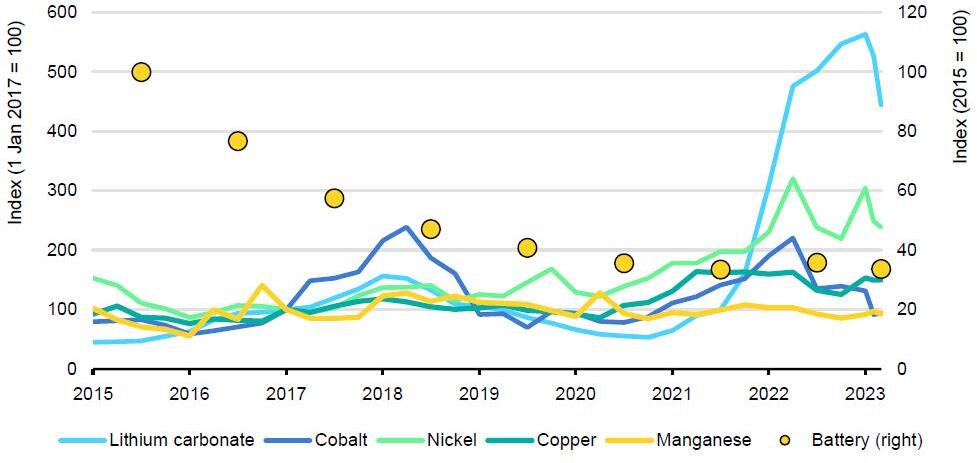
Battery metals will benefit from electric car markets that are seeing exponential growth, with sales
exceeding 10 million during 2022. A total of 14% of all new cars sold were electric in 2022, up from around 9% in 2021 and less than 5% in 2020, with three markets dominating global sales. China was the frontrunner once again, accounting for around 60% of global electric car sales. More than half of the electric cars on roads worldwide are now in China and the country has already exceeded its 2025 target for new energy vehicle sales.
In Europe, the second largest market, electric car sales increased by over 15% in 2022, meaning that more than one in every five cars sold was electric. Electric car sales in the United States – the third largest market – increased 55% in 2022, reaching a sales share of 8%.
Encouragingly, early indications from first quarter sales of 2023 point to an upbeat market, supported by cost declines as well as strengthened policy support in key markets such as the United States. Globally, the IEA’s current estimate is for nearly 14 million electric cars to be sold in 2023, building on the more than 2.3 million already sold in the first quarter of the year. This represents a 35% increase in electric car sales in 2023 compared to 2022 and would bring Electric car sales in the first three months of 2023 have shown strong signs of growth compared to the same period in 2022.
In the United States, more than 320 000 electric cars were sold in the first quarter of 2023, 60% more than
over the same period last year. The IEA’s current expectation is for this growth to be sustained throughout the year, with electric car sales reaching over 1.5 million in 2023, bringing the electric car sales share in the United States up to around 12% in 2023.
Significantly, the European Union and the United States have passed legislation to match their electrification ambitions. The European Union adopted new CO2 standards for cars and vans that are aligned with the 2030 goals set out in the Fit for 55 package. In the United States, the Inflation Reduction Act (IRA), combined with adoption of California’s Advanced Clean Cars II rule by a number of states, could deliver a 50% market share for electric cars in 2030, in line with the national target. The implementation of the recently proposed emissions standards from the US Environmental Protection Agency is set to further increase this share.
Battery metals will also benefit from an ongoing expansion in battery manufacturing capacity, directly linked to the outlook for EVs. As of March 2023, announcements on battery manufacturing capacity delivered by 2030 are more than sufficient to meet the demand implied by government pledges and would even be able to cover the demand for electric vehicles in the Net Zero Emissions by 2050 Scenario. It is therefore possible
that higher shares of sales are achievable for electric cars than those anticipated on the basis of current government policy and national targets.
Global EV battery demand increased by about 65% in 2022, reaching around 550 GWh, about the same level as EV battery production. The lithium-ion automotive battery manufacturing capacity in 2022 was roughly 1.5 TWh for the year, implying a utilisation rate of around 35% compared to about 43% in 2021. Battery demand is set to increase significantly by 2030, reaching over 3 TWh.
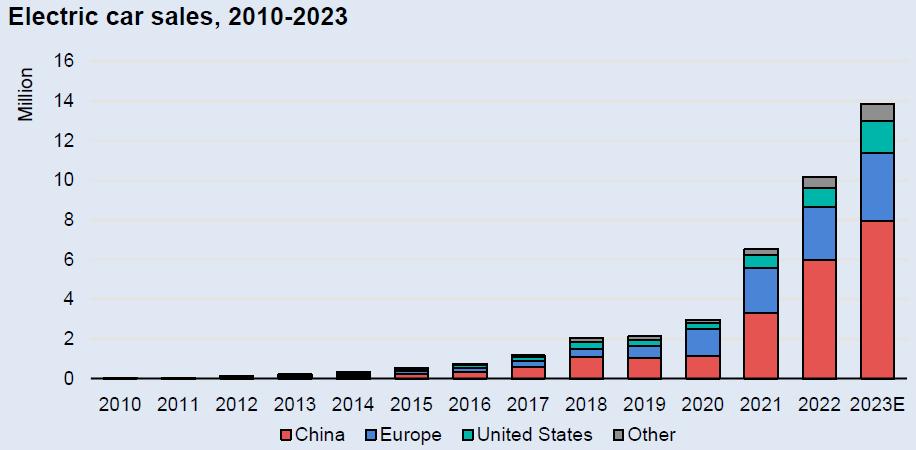
To meet that demand, more than 50 gigafactories (each with 35 GWh of annual production capacity) would be needed by 2030 in addition to today’s battery production capacity. This increases to close to 65 new gigafactories to meet 2030 demand. According to Benchmark Mineral Intelligence (as of March 2023), the announced battery production capacity by private companies for EVs in 2030 amounts to 6.8 TWh.
Far more needs to be done to ensure supply chains for critical minerals, such as lithium, cobalt, nickel and copper, as well as platinum, manganese and various rare-earth minerals, are secure and sustainable. There is also a need to diversify the sources of supply away from their current concentration
in a handful of countries. The Democratic Republic of Congo (DRC) dominates cobalt supply, while China holds half of planned lithium chemical plants, and Indonesia represents nearly 90% of planned nickel refining facilities. Any project delays and technology-specific shortfalls could undermine both the pace and cost of the energy transition, pushing commodity prices higher.
China maintains about one-third of the world’s rare earth reserves, a key component in the production of EV batteries and electronics. China also hosts at least 85% of the world’s capacity to process rare earths into material manufacturers can use, a capability other countries want to develop. China has been the go-to supplier for companies because it is able to export processed minerals at a lower cost than other countries.
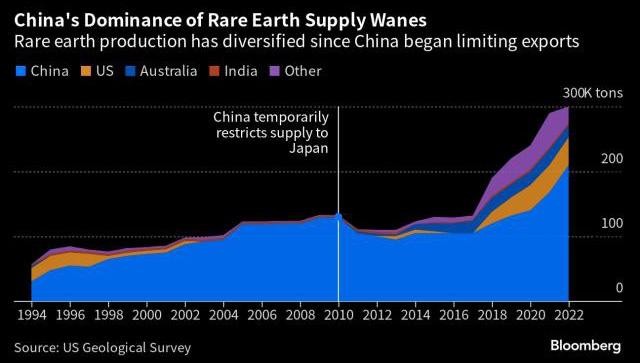

However, if rare earths prices rise as restrictions take hold, companies in the West would have another reason to shift supply chains, and make it more economical to boost output in Japan, Canada, the US or elsewhere. China’s previous efforts to restrict the sale of rare earths have only diminished its market share as other countries work to secure supplies of the metals that aren’t controlled by China. China first introduced an export licensing system for rare earths during the 1990s, whilst also gradually ramping up taxes that squeezed companies in Japan and elsewhere that relied on Chinese supplies.
However the big shift happened in 2010, when Beijing temporary halted exports to Japan in reaction to a collision between a Chinese fishing boat and the Japanese coast guard near islands claimed by both countries. That incident set off a race to find alternatives to supplies from China. Output in Australia and the US subsequently increased, pushing down China’s share of mining output to 70% of global supply in 2022 from a peak of 98% in 2010, based on US Geological Survey data.
China’s recent decision to restrict exports of strategic metals - gallium and germanium - from 1 August, is
causing more angst. China accounted for about 98% of the world’s gallium production in 2022, estimated at 430,000kg in 2021. China was also the world’s leading producer of germanium in 2022, with the country controlling 68% of global refinery production, estimated at 140,000kg in 2021, according to the US Geological Survey (USGS), with the rest of processing spread across Europe and North America.
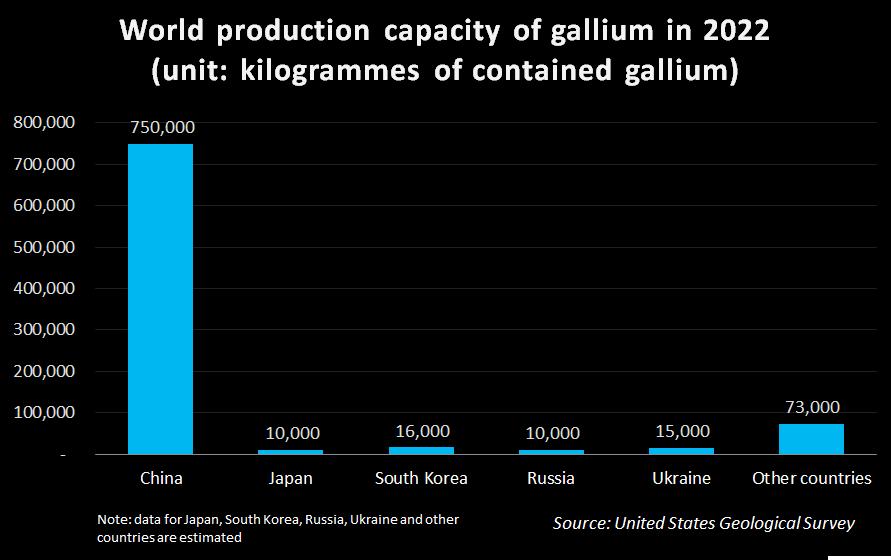
Gallium is a soft silvery metal, that’s similar to aluminium. About 95% of all gallium produced is used to make gallium arsenide (GaAs), a compound used in microwave and infrared circuits, semiconductors and blue and violet LEDs. The compound gallium nitride (GaN) is used as a semiconductor in Blu-ray technology, mobile phones and pressure sensors for touch switches. There are no substitutes for its use in some products and gallium is not currently recyclable. Germanium, a silvery-white metal, is used in the manufacturing of fibre optics to transfer data and information, as well as high-speed chips and infrared radiation.
And aside from China, it’s just taking longer to commission new mines. Quoting from a recnt Bloomberg article, “There’s a huge crisis,” says Doug Kirwin, one
of the earliest geologists to work at the deposit that became Oyu Tolgoi, or Turquoise Hill, named after the area’s rocks, stained by oxidized copper. “There’s no way we can supply the amount of copper in the next 10 years to drive the energy transition and carbon zero. It’s not going to happen,” adds Kirwin, now an independent consulting geologist. “There’s just not enough copper deposits being found or developed.”
Analysts at Wood Mackenzie estimate we will be short about 6 million tons of copper by next decade, meaning 12 new Oyu Tolgois need to come online within that period. But they aren’t, as there are simply not enough new mines, much less enough large ones. The result is a gap, as BloombergNEF estimates appetite for refined copper will grow by 53% by 2040, but mine supply will climb by only 16%.

We’re also approaching a supply crunch in the global lithium market toward the end of this decade, as EV demand ramps up. Raw materials loom as a bottleneck, with about 300 factories that can produce batteries for EVs being developed globally,
about 59 new lithium mines and plants are necessary, according to Benchmark Intelligence. A gigafactory can be built in two to five years, a refinery can be built in two, but the mines needed upstream of them take between five and 25 years to develop.
Junior equities are in the ideal position to benefit from the energy transition. Junior companies are typically far more nimble than the sector heavyweights in terms of adaptation, and being able to acquire and efficiently evaluate exploration projects that are relevant to new commodity demand trends. We’ve seen this already with respect to key Australian and North American junior equity plays that have been successful in the battery metals space.
One of the hottest investment destinations right now for junior and larger companies alike is the James Bay region of Quebec, Canada. Québec represents a highly attractive investment destination for battery metals production due to its supportive resource develop-
ment sector, access to skilled labour and its proximity to the emerging European and North American electric vehicle markets. Canada also has free trade agreements with the United States and the European Union.
The James Bay region hosts projects that include Allkem’s (ASX, TSX: AKE) James Bay deposit, a mine capable of producing 321,000 tonnes of spodumene concentrate per year; and the Corvette project of Patriot Battery Metals (ASX: PMT, TSX-V: PMET), a company chaired by former Pilbara Minerals (ASX: PLS) boss, Ken Brinsden.
One of the key themes in the junior company space is the growing partnership with car makers. Vehicle manufacturers are boosting their upstream investments and supply contracts in order to secure enough battery metals for EV production. It used to be that junior mining companies would only be acquired by majors and mid-tiers, but that’s no longer the case. As vehicle manufacturers and battery manufacturers become more desperate for battery metals, we could be looking at a monumental shift in the way juniors are valued.
One of the stand-out performers in the battery metals space and a great example of what is possible is Western Australian lithium company, Liontown
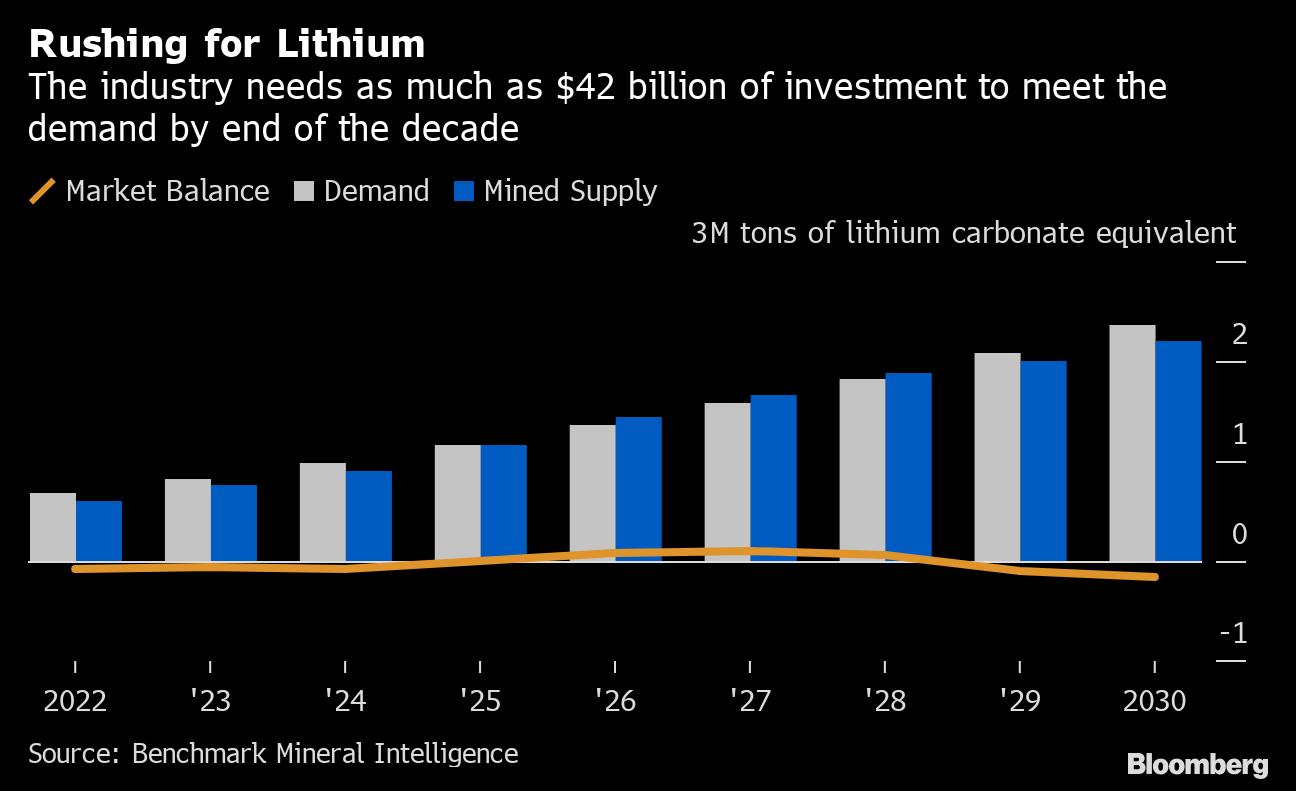
Resources (ASX: LTR), which has risen from a low of ~A$0.02 to ~A$3.00 over the past few years. Its Kathleen Valley project will be one of the world’s largest lithium mines, supplying ~500,000 tonnes of 6% lithium oxide concentrate per year when it comes on stream in 2024. Crucially, it has binding offtake agreements with Tesla, Ford and LG Energy Solutions and A$300m in project funding from Ford.
Battery metals will continue to increase in profile due to a combination of growing demand, constrained supply, and geopolitical risk factors. A robust pricing environment is likely to prevail and to assist in incentivising new production.
Gavin is based in Sydney, Australia and has followed the fortunes of international resource markets for the past 25 years, covering both equities and commodities, as a research analyst. He believes that the most interesting resource opportunities are typically found at the smaller end of the market, which is his exclusive area of focus.
The resource sector is on an inexorable growth path, driven by an ever-increasing world population and modernization of living standards in emerging economies, as well as a significant shift in how we generate energy. This will provide enormous growth in the demand for commodities of all types.
This article is not an attempt to provide investment advice. The content is purely the author’s personal opinions and should not be considered advice of any kind. Investors are advised to conduct their own research or seek the advice of a registered investment professional. The author does not own any shares in the companies mentioned.
In the corporate battlefield, mental acuity and focus are your most potent weapons. But amidst the incessant pressure and high-stakes decisions, even the sharpest minds can succumb to brain fog.
Growing research shows that optimal brain function is significantly influenced by our diet. But in our hectic schedules, consuming enough 'Brain Food' is often a challenge.
Enrich your diet with SmartBRAIN and unlock a whole new level of cognitive potential:

✔ Support the normal functioning of your cell membrane signal receptors for seamless communication within the brain*

✔ Promote a healthier memory and uplifted mood, adding vibrancy to your daily life*
✔ Hone your focus and concentration, empowering you to excel in every task you undertake*
✔ Experience an enhanced sense of clarity, cutting through the mental fog like a beacon*
This groundbreaking dietary supp to deliver the vital nutrients your m


m a r t B r a i n
"I’ve only been taking this for one month and already feel that I’m not as forgetful and my memory is improving."

Xcel is a media and social commerce company with owned brands generating approximately $600MM in annual retail sales through livestream and other distribution. We seek to reimagine shopping, entertainment, and social media as one. We are engaged in design, marketing, merchandising, licensing, short form video content, sales and talent management through livestream television and digital commerce. The company is poised to launch the first fully integrated social commerce marketplace which management believes has unicorn potential.
The company is poised to launch a social commerce marketplace by 2H 2023 which is a multi-brand short-form video content platform with the ability for shoppers, creators, and influencers to earn fees based on conversions. It combines live streaming, ecommerce, and social media in one seamless social commerce platform which drives brand discovery. The strategic partners and brands onboarded to the beta testing of this marketplace have combined customers lists of over 10 million people which will drive demand for the marketplace. This marketplace is fully developed.
The company has successfully reduced overhead costs by $13mm in Q1 2023 and outsourced its wholesale ventures to major industry leading players. For Halston a new partnership with GIII has been announced, expecting to drive wholesale sales from $50mm to $250mm by 2027. For Judith Ripka the ecommerce website, livestream and production has been licensed to JTV a leader in the jewelry marketplace with over $500mm of livestream sales. These transitions are expected to drive top line and the company plans to be EBITDA positive by Q4 2023. The company has no long term debt on its balance sheet and has significant cash reserves to bolster its brands, positioning it for high growth in the near term.
Billions are now up for grabs as ecommerce, livestreaming, and social media are evolving into Social Commerce marketplaces powered by short form video content, with an estimated 20% of all online sales expected to be driven by social commerce by 2026. Xcel is at the forefront of this change with its proprietary technology designed to drive audience engagement and sales of products. Xcel has over a decade of expertise with 10,000 hours of live stream programming and over $4bn in cumulative retail sales via livestreaming. The company’s social com-

merce marketplace will benefit from this industry tailwind.
The three main value catalysts for the company are:
• New Social Commerce Brands: We are currently developing new brands in collaboration with designers and other social media influencers who have millions of followers and are positioned to succeed in Live Stream and Social Commerce. We plan to launch 2-4 new brands within the next 12 to 18 months.
• Social Commerce Marketplace: We expect to
launch a social commerce driven marketplace and app, which will feature well-known designer brands as well as Xcel’s brands. This marketplace will harness the power of our unique social commerce technology, creating a dynamic and engaging platform for shoppers and brands alike.
• Pursue Acquisition Opportunities: We seek to divest and/or harvest our brands where we can generate significant returns for our shareholders, with our 2022 sale of a majority stake in Isaac Mizrahi generating an excess of 99% Return on Equity.
For more information about Xcel Brands, please visit: www.xcelbrands.co
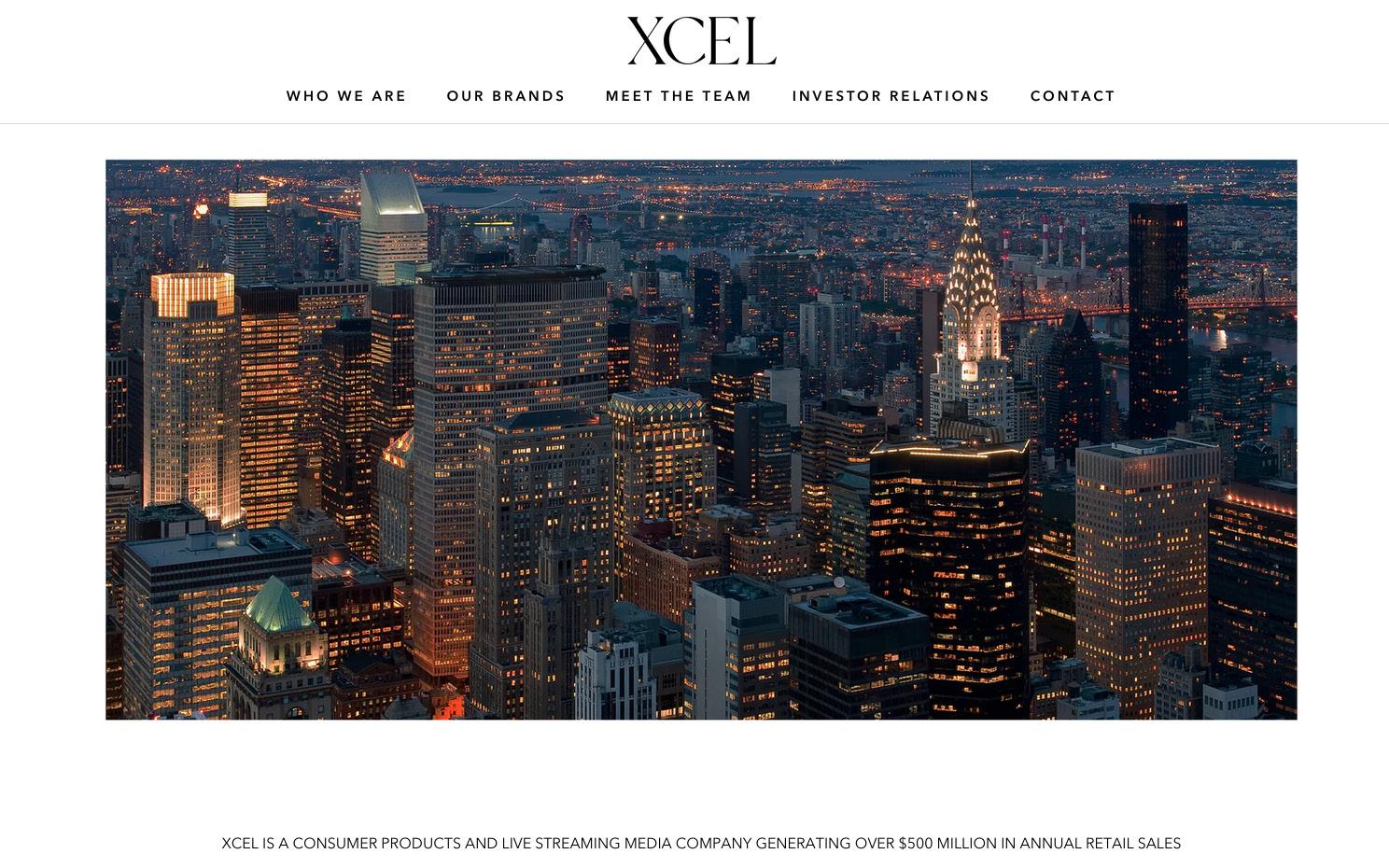
DISCLAImER AND FORwARD-LOOkINg STATEmENTS NOTICE: This article is provided as a service of SNN inc. or an affiliate thereof (collectively “SNN”), and all information presented is for commercial and informational purposes only, is not investment advice, and should not be relied upon for any investment decisions. we are not recommending any securities, nor is this an offer or sale of any security. Neither SNN nor its representatives are licensed brokers, broker-dealers, market makers, investment bankers, investment advisers, analysts, or underwriters registered with the Securities and Exchange Commission (“SEC”) or with any state securities regulatory authority
SNN provides no assurances as to the accuracy or completeness of the information presented, including information regarding any specific company’s plans, or its ability to effectuate any plan, and possess no actual knowledge of any specific company’s operations, capabilities, intent, resources, or experience. any opinions expressed in this article are solely attributed to each individual asserting the same and do not reflect the opinion of SNN. information contained in this presentation may contain “forward-looking statements” as defined under Section 27a of the Securities act of 1933 and Section 21b of the Securities Exchange act of 1934. Forward-looking statements are based upon expectations, estimates, and projections at the time the statements are made and involve risks and uncertainties that could cause actual events to differ materially from those anticipated. Therefore, readers are cautioned against placing any undue reliance upon any forwardlooking statement that may be found in this article.
SNN did not receive compensation for, nor engage in, providing advice, making recommendations, issuing reports, or furnishing analyses on any of the companies, securities, strategies, or information presented in this article. SNN recommends you consult a licensed investment adviser, broker, or legal counsel before purchasing or selling any securities referenced in this article. Furthermore, it is encouraged that you invest carefully and consult investment related information available on the websites of the SEC at http://www.sec. gov and the Financial industry Regulatory authority (FiNRa) at http://finra.org.
Note: This article is not an attempt to provide investment advice. The content is purely the author’s personal opinions and should not be considered advice of any kind. Investors are advised to conduct their own research or seek the advice of a registered investment professional.
Amale lion roaring to assert his dominance of the pride; female baboons with their bright sexual swelling indicating their readiness to mate; bees performing the waggle dance to show the direction and distance of flowers.
All these are examples of signals, and no textbook on evolutionary theory is complete without a lengthy discussion on them. Signals can be both “honest” and “dishonest”. Let’s start with a deceptive signal.
Green frogs, like most animals, have a short window for mating. During this crucial period, males need to defend their territories aggressively to maximize their reproductive success. Larger males advertise their size and dominance by making calls (croaks, if you prefer) at a lower frequency than smaller frogs.

What do you do if you are a small green frog? Live without a mate and die a virgin? No sir! Some small green frogs have found a way to lower their signals’ pitch, thereby communicating that they are larger than they actually are. This dishonest signal is easy to produce and imposes a very little cost on the signaller, the small green frog.
Unlike green frogs, male guppies lead a more upright life.
Guppies populate the mountain forest streams of Venezuela, Trinidad, and Tobago. While the female guppies are plain and drab looking, the male guppies are quite colourful, and no two males have the same colour pattern.
Females have a clear preference for brighter and more conspicuously red males. But conspicuous coloration comes at a huge cost to the males – of their life. Thus, brighter colours in a guppy are an honest signal of attractiveness to the females.
The words “honest” and “dishonest” in the discussion above do not communicate the intent of the signaller. They point to the effect of the signal on the receiver. When a signal fools the receiver, it is dishonest; when the receiver understands the signal for what it is, it is honest.
While I call myself an investor, an evolutionary biologist would not be remiss in branding me as a “signal decoder”. The only things investors can rely on to assess a company are the signals emitted by it.
If you are an ardent fan of the National Geographic TV channel as I am, some or all the following scenes should be familiar to you.
Companies relay signals in the form of press releases, media interviews, analyst meetings, annual reports, and so much more. Among the many reasons for performance variance among fund managers, one that stands out for me is the their ability to decode the honest signals from the dishonest ones. Acting on a dishonest signal and ignoring an honest one can lead to hunger or death in the natural world, a fate not too dissimilar to a fund’s performance.
But how is an investor supposed to distinguish between an honest signal and a dishonest one?
Let’s turn to an Israeli evolutionary biologist Amotz Zahavi. In 1975, he proposed his famous handicap principle. Zahavi’s profound observation was that when signals for a particular trait are costly to produce – he rightly termed them “handicaps” – and cannot be matched by someone else with a lower quality of that trait, they can be deemed “honest”.

And herein lies Zahavi’s lesson for us investors: lend credence to only those signals from companies that are costly to produce. This, however, is easier said than done.
Let us start with real life examples of dishonest signals, i.e., those that do not reliably communicate the trait they are supposed to. A “dishonest” signal does not imply that the sender is dishonest, although they might be; it simply means that the signal may not communicate what it is supposed to.
Take this example of a Unilever press release on 20th January 2015. The headline states confidently, “Profitable growth in tougher markets”. I assume you agree that developed markets like the US and Western Europe should be classified as “tough” because they are mature with very high competitive intensity and have growth challenges. But if you read the press release carefully, you will notice that the sales in 2014 declined by 0.8% in developed markets. The sales grew 5.7% in emerging markets (and even this growth was lower than 2013), but I would not call emerging markets “tough”. Maybe you disagree with me and you would prefer to call emerging markets as tough. But then how does one
explain a sales decline of 20% in the 4th quarter in China?

We don’t give press releases any importance.
It was 13th June 2019. The 51-year-old visionary CEO was giving an interview to Bloomberg’s Matt Miller on the sidelines of Europe’s most prestigious digital and tech conference in Berlin. Its stock price had tripled over the past three years valuing at about €18 billion.
The relaxed and confident CEO looked Miller directly in the eyes and answered every question with remarkable clarity and precision. He assured Miller that Asia was the primary growth engine, its new sales were up 160%, and they were also witnessing growth in Europe. Almost exactly a year after this interview, the CEO was arrested on charges of criminal fraud. The company filed for insolvency on 25th June 2020.
The CEO’s name? Markus Braun. The company? Wirecard.
While I have taken an extreme example, it highlights two common features of almost all management interviews. First, they are an exercise in making
the management look good. But as you must know from your own life experience, looking good is not the same as being good. Second, these kinds of interviews can inform us a lot about the and the company, but not a lot that is relevant to an investor.
In a typical investor conference, tens, sometimes even hundreds, of companies converge to make a series of presentations to visiting investors. Roadshows are a scaled-down version of these conferences where the company management typically visits investors in their offices.
They are a dishonest signal not because managements are dishonest – most of them are upright folks doing their job – but because it does not cost anything to spin the best story possible in a 45-minute presentation to an audience that is partly brain-dead rushing from one meeting to another.
Investors and analysts love earnings guidance from companies. What do you think management’s projections about the next year are based on? Recent past? Hope for a better future? Spreadsheet manipulation? All of the above? Earnings guidance is a dishonest signal even though the management may fervently believe in it. It is cheap – easy to produce and needs little effort to deliver.
We base our assessment of the company on its riskiness, competitive moat, quality of financials, and on management integrity; not on its ability to forecast earnings accurately.
In mid-2015, Valeant, a pharmaceutical company run by a McKinsey alum called Mike Pearson, was the darling of the stock market and had a market value of about $90 billion. Just five years before, in 2010, its market value was only about $5 billion. Investors loved Mike and his seemingly unbeatable strategy, and marquee investors like Sequoia, ValueAct, and Pershing Square were big fans.
Charlie Munger, however, was having none of it. He rightly spotted that the debt-fuelled acquisition spree of Valeant was a recipe for disaster. Com-
bined with Valeant’s numerous unethical business practises, he opined that Valeant would fail spectacularly sooner or later.
Why could Munger correctly predict Valeant’s demise without meeting Mike Pearson when many of Valeant’s board members and investors continued to be passionate supporters? The reason Munger was right was that he knew that any face-to-face meeting is a dishonest signal.
It looks like we are in a bit of soup here. If we can’t rely on press releases, investor conferences, earnings guidance, and management meetings, what kinds of signals can we, as investors, trust?
Let’s go back to Zahavi, whose assertion for the natural world is highly relevant for the investing world; we should only trust costly signals emitted by companies because they are the only ones we can rely on. There are broadly two such signals.
The past has happened. It is there for us to see. It can’t be denied. It is an undeniable signal of the company’s actions and outcomes. The problem, of course, is that investors seem intently focused on receiving signals about the future.
If you have some spare time, please find the transcript of any company’s quarterly conference call with analysts and investors. Almost every question from the analysts and investors alike will attempt to predict the future of the company, industry, and in some case, even the broader economic environment.
An honest signal is not “our margin will be 15% next year” but “our average margin was 12% over the last ten years”; an honest signal is not “we will have robust free cash flows starting two years from now” but “we have generated free cash flow only one year in the last decade”; an honest signal is not “we will launch six new products next year” but “in our recent history, we have launched an average of one product every two years”.
No stories, no projections, just facts about the past.
While most people show positive bias in evaluating themselves and their kids, they can be remarkably candid and accurate when it comes to analysing other people and their spouses. As an investor, we have used this well-proven human quality to solicit positive and negative signals on companies. A good reputation is a very costly signal – and hence an honest one – because building a name for oneself in any industry consumes enormous management time and effort over many years, if not decades.
Hence, before we make any investment, we spend many months speaking to dealers, competitors, ex-employees, suppliers, and industry experts to get a holistic understanding of the company and the industry.
In the business world, the senders of the signals – the companies – are clearly winning over the receivers – us, the gullible investors. No wonder our community performs poorly compared to the broad market. What should we long-term investors do?
Ignore the green frog and heed the guppy.
Pulak Prasad is the author of What I Learned About Investing from Darwin (Columbia Business School Publishing, May 2023,) and the founder and CEO of Nalanda Capital, a Singapore-based firm that invests in listed Indian equities and manages about $5 billion primarily for US endowments, and US and European family offices and foundations. At Nalanda, in his quarterly letter to investors, he started drawing parallels between investing concepts and evolutionary theory. Encouraged by many of his readers who said they loved his letters, he decided to write the book What I Learned About Investing from Darwin. To learn more visit www.pulakprasad.com




q.- DOUg, EgS HAS BEEN IN THE SPAC mARkET FOR OvER 20 yEARS AND HAvE OBSERvED mANy CyCLES AND SHIFTS, wHERE DO yOU BELIEvE wE ARE AT THE mOmENT?
A. - It’s actually a very dynamic market at the moment, which may not be obvious to many observers. The standard narrative in the mainstream press and with academics is that SPACs had this massive run-up, failed miserably and are now winding down. It’s much more nuanced than a broad strokes conclusion. You need to appreciate that during the course of my professional career the number of traditional IPOs has dropped from nearly a thousand a year to less than 50 last year. The number of brokerage firms willing to undertake an IPO process, which is time consuming and costly, has similarly been reduced. In contrast to the IPO market last year, nearly 100 private companies elected to go-public through a SPAC. This year will be higher still.
So when we are analyzing the current state of play, let’s be clear that there are still (15+) SPAC IPOs that have been listed in 2023. There were mid 80s last year. Net of successfully concluded and dissolved SPACs coming into 2023, there were 450 funded and listed SPACs. 150 announced their proposed business combination partners prior to the end of the year and there probably have been another 50 this year- leaving 265 listed SPACs looking to identify suitable targets. Given the inactivity in the broader capital markets, I think it’s fair
to say that more companies will go public again this year through a SPAC than a traditional IPO- so no, there is no truth to the rumor of the demise of SPACs. What’s lost by the detractors of SPACs (deSPACs) is they perform quite similarly to both IPOs and Direct Listings, their preferred approach to going public. So, we have a very active SPACquisitions market, with some simultaneous PIPE financings and the RE-emergence of a SPAC IPO market.
q.- yOU POINT OUT THAT THE PERFORmANCE OF SPAC BUSINESS COmBINATIONS, IPOS AND DIRECT LISTINgS ARE ALL PERFORmINg POORLy, IS THAT A gOOD DEFENSE OF THE SPAC INDUSTRy.
A.- No, not at all. My point is that you first need to acknowledge that the SPAC mechanism is neither good nor bad, it is merely an alternative way of taking a company public. As the SEC likes to remind us “treat like alike”- well I’d like to see their analysis be equally high-minded. While regulators have proposed substantial changes to the SPAC program, nothing has been suggested as it relates to IPOs nor Direct Listings, which given their mirror images of one another, I just don’t understand. Don’t get me wrong, any mechanism that responsibly transitions private companies into our public markets I’m fully in favor of, but continue to challenge the asymmetry of regulatory approach.
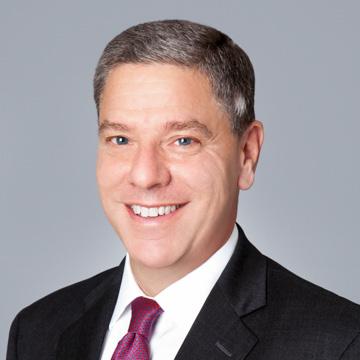
q.- wHILE wE ARE ON THE SUBJECT OF THE SEC’S PROPOSED RULES FROm APRIL OF LAST yEAR, wHEN DO yOU BELIEvE THEy wILL BE CONSIDERED FOR APPROvAL.
A.- Maybe never. I’m told that the SEC may be of the view that it is their considered view that the proposed rules have already served their function in both chilling the market as well as possibly altering how business combinations have been processed since. The SEC proposed several rules that several commentators challenged and argued that the SEC didn’t have the proper authority to advance- particularly the elimination of the Congressionally approved safe harbor for the use of Projections and the imposition of Gatekeeper Liability in brokerage firms involved in both the front-end and back-end process. To be clear, failure to approve either of those provisions confirms our historic view that absent these rules, SPACs and targets may continue to use the projections pursuant to the M&A safe harbor and member firms can’t be held responsible for those numbers of many other issues. While I’d continue to argue that is very healthy, I’m also supportive of professionals applying the same standard of care on a voluntary basis that is present in an IPO. With respect to other aspects of the proposals I’d argue that the SEC has always had the authority to force additional/clearer disclosure and that they haven’t because it was never a legitimate criticism of the program since the SEC has been actively engaged in the program for 20 years and given all of their comments during all these years, the law firms are the same large firms that process most of the IPOs
in the US and have been applying the same exacting standard to SPACs as they have to IPOs, and, most importantly NOTHING has changed during g the last year.

q.- EvEN THOUgH THE SEC’S PROPOSED RULES mAy NOT HAvE BEEN APPROvED, HASN’T THE LITIgATION IN DELAwARE AFFECTED THE SPAC BUSINESS?
A.- To some limited degree. For all the noise, there are a few cases that are working their way through the Delaware court system but there’s no final determination that the plaintiff’s bar can point to as a categorical win. That’s not to say that they haven’t had positive results like settlements or decisions, that based upon the facts, have advanced their arguments. However, the D&O carriers have generally taken comfort. The Delaware court found in favor of the dual class voting issue and that issue seems to have resolved itself for the industry. There are certain claims surrounding structural conflicts of interest of Board Members and the Sponsors because of the founder shares that will continue to be determined on a case-by-case basis. Going forward though, Delaware has sent a message to the industry and it just won’t be the jurisdiction of choice.
q.- I THINk yOU’D AgREE THAT EvEN IF THE SPAC INDUSTRy RESUmES, IT wON’T BE AS FROTHy AS IT wAS IN 2021?
A.- Unquestionably, I’d not only be surprised but concerned if it did. Although regulators aren’t
concerned, I’m dismayed by the significant loss of sponsor capital over the last couple of years in addition to losses suffered by the public in spacs, IPOs and direct listings. I’d like to see a slow and steady re-emergence of the industry, with broad positive results for each constituent party.
q.- wE OBSERvE wITH THE ExCEPTION OF THE ARES SPAC, THAT THE IPOS SEEm TO BE SIgNIFICANTLy SmALLER THAN THE AvERAgE SPACS FROm THE LAST SEvERAL yEARS.
A.- The observation is a correct one, for the most part the trend is $100mm or less. This makes sense since smaller spacs have the ability to pursue a much larger universe of potential targets. Additionally, smaller SPACs require less sponsor At Risk Capital investment.

q.- IN THE LAST yEAR THE LEvEL OF INvESTOR REDEmPTIONS SEEmS TO HAvE INCREASED SUBSTANTIALLy?
A.- Yes, this is a current market reality. In many ways this is healthy, although amusingly reported as negative by the press. All high redemptions mean is that the investing public either doesn’t like a deal or that
generalized market appetite for risk is low. In either case, those investors that want their capital returned have that automatic right. It’s a foundational principle of SPACs and unique to this vehicle. It should be lauded rather than used as a metric for the failure of SPACs. Unfortunately, for sponsors the higher the redemption rate the less likely the proposed deal is likely to get funded. This is their risk and a risk to any proposed business combination being consummated.
Douglas S. Ellenoff, a member of Ellenoff Grossman & Schole LLP since its founding in 1992, is a corporate and securities attorney with a focus in business transactions, mergers and acquisitions and corporate financings. Mr. Ellenoff has represented public companies in connection with their initial public offerings, secondary public offerings, regulatory compliance, as well as, strategic initiatives and general corporate governance matters. In the last several years, he has been involved at various stages in numerous SPACs, SPAC M&A transactions, registered public offerings, and private placements into public companies, representing either the issuers of those securities or the registered broker-dealers acting as placement agent.
The Firm represents nearly 70 public companies with respect to their ongoing 34 Act reporting responsibilities and general corporate matters. He also provides counsel with regard to their respective ongoing (SEC, AMEX and NASD) regulatory compliance. Mr. Ellenoff is routinely requested to be a panelist and presenter at industry conferences.
Mr. Ellenoff has been ranked by Chambers and Partners USA as a Notable Practitioner: “Douglas Ellenoff is a leading figure in equity capital markets, garnering fame for his ability to take blank-check companies public. He is very knowledgeable about SPACs as he has done this for a long time.”


It is a common issue, trying to find a broker/dealer or investment bank that meets the needs of your company. Your company needs additional capital to grow and expand, yet finding an investment bank to raise those funds is proving harder than expected. This is an important task, and those companies that can successfully navigate this process are able to secure that capital they need to fuel their growth and expansion.
To m successfully navigate this issue, it is important to understand the nature of the brokerage industry. The Financial Industry Regulatory Authority (“FINRA”), which is charged with regulating the brokerage industry provides an annual industry snapshot. The 2022 Industry Snapshot provides some interesting information about the nature of the industry.
The most recent data shows that at the end of 2021 there were 3,394 brokerage firms registered with FINRA. FINRA primarily groups firms into three (3) categories based on their size, large, medium and small. Large firms are those with 500 or more registered representatives. Firms with 151 to 499 registered representatives are considered to be medium sized firms; and those with 150 or less registered representatives are considered to be small sized firms. According to FINRA, at the end of 2021, there were 161 broker/dealers considered to be large sized firms, 185 firms considered to be
medium-sized, and 3,048 considered to be small firms. This is important, as firms tend to focus on clients who are relative to their size. The large firms pursue the larger projects, medium sized firms focus on medium sized projects, and smaller firms focus on smaller capital raising projects.
in conversations
and prospective clients; they have spoken with countless broker/ dealers and investments banks, and just can’t seem to find one that provides the services they need or is interested in their company.
Registered firms are required to receive FINRA approval for the various lines of business they engage in. This complicates things. Not every registered firm is approved for every line of business. This is primarily a function of the personnel they have available. In order to operate in a particular business segment, a broker/dealer must have appropriately licensed personnel. As a result, most brokerage firms only engage in a limited number of, or niche segments of the securities industry. In the small firm category, the 2021 Industry Snapshot reports lists approximately 1,381 firms that are active in the Capital Markets and Investment Banking Services. There are approximately 192 firms that provide retail private placement services; and approximately 356 are firms listed as providing trading and execution services. The point of all this is that it can be very difficult to find a brokerage firm or investment bank to service the needs of your company. It can be somewhat like searching for a needle in a haystack.
Moreover, it is important to understand that many firms develop specialization. There are firms that specialize in servicing retail customers, discount brokerage firms, cross border trading, as well as merger and acquisitions. Within the investment banking space there are many brokerage firms that specialize in finding privately held companies and private equity firms to buy those companies. Once, I even met with an investment bank that specialized in arranging financing for companies whose facilities were damaged by natural disasters. Talk about a niche line of business. Overall, there is a tendency to focus on those industries the investment bankers understand the best, and have had success in.
All that being said, I think the capital raising process and the ability of companies to raise growth capital here in the United States is the best it has been in decades. The United States continues to have the most liquid and well-developed capital markets in the world. I believe the regulatory changes starting with the JOBS Act have opened the capital markets for US companies. I believe that subsequent regulatory changes have forced broker/dealers and investment banks to diversify in order to survive. This has resulted in better more well-rounded businesses, more able to serve the needs of their clients. This has tremendously increased the opportunities for companies seeking to raise capital.
find a broker/dealer or investment bank to raise the capital it needs? It is important to remember that the brokerage and investment banking industry is one of personal relationships. Who you know is important. And having someone who can help get your company reviewed by the right people is even more important. The ability to receive a personal introduction cannot be underestimated. The various conferences like Planet MicroCap are an excellent way to get in front of the investment banks that are seeking to raise capital.
Being well prepared as a company is key. Time and time again, we have looked at companies we thought had excellent prospects; only to find they lacked the preparation necessary for an investment bank to work with them. For too many companies, starting the process of getting prepared came to late, and they were not able to complete it in time before they ran out of money. In many cases we have seen the market change by the time a company was prepared to start the capital raising process. Back in the mid-2000’s there were many ethanol companies that thought they had an unlimited amount of time to raise money, only to find out that the market had soured on their industry and the window of opportunity for them to raise capital had closed.
I truly believe the companies that take the time to become well prepared and understand the capital raising process will be successful at raising capital. It is also important to understand that not all broker/ dealers or investment banks are the same, and why they are different.
Erik Nelson is the President of Coral Capital Advisors, LLC. www.coralcapital.com and www.dtc.coralcapital.com, an independent consulting and advisory firm focused on companies and participants in the lower and middle markets. Coral Capital Advisors specializes in DTC Eligibility services, due diligence, and corporate restructurings. Coral Capital Advisors. provides services to Investment Banks, Private Equity Funds, investors, and both privately held and publicly traded companies, as well as various stakeholders in those organizations. This has included international public companies with operations on three (3) continents to smaller privately held domestic companies. Our experience in the areas of corporate advisory, due diligence reviews, and regulatory compliance allows for a cost effective and efficient solution to the issues at hand. Please feel free to visit our web site at: www.coralcapital.com or call our offices via. telephone # (404)-816-9220 to see how we may be of assistance.
On July 26, 2023, the Securities and Exchange Commission adopted long-awaited cybersecurity disclosure rules for all reporting companies. While the rules will phase in by the end of the year, the most immediate impact of their adoption is the need for companies to begin planning well in advance, most likely with the help of cybersecurity consultants and counsel.
Reporting companies must now disclose in a Current Report on Form 8-K, under Item 1.05, “any cybersecurity incident that they experience that is determined to be material” and describe “material aspects” of the reported incident, including a description of its nature, scope, timing and impact on the company, within four business days after determining a cybersecurity incident is material. One thing of note is that the requirement to file a Form 8-K is not within four business days following the incident itself, but rather within four business days following the determination that the incident is material. That is an important distinction.
Nonetheless, a determination of the materiality of such an incident needs to be done “without unreasonable delay . . . consistent with the standard set out in the cases addressing materiality in the securities laws”. While not quite creating a safe harbor, in the release adopting the new rules the SEC noted that “adhering to normal internal practices and disclosure controls and procedures will suffice to demonstrate good faith compliance”. Therefore, following any cybersecurity incident, manage-
ment should proceed with all deliberate speed to determine the materiality of the incident in order be consistent with acting in good faith and in compliance with the new rule.
In rare circumstances, pursuant to a national security exception, if the U.S. Attorney General determines that such a disclosure “poses a substantial risk to national security or public safety,” companies may delay providing the Form 8-K disclosure until such period determined by the Attorney General, up to 30 days, which can be extended for additional 30 days (or even longer) if the Attorney General determines that disclosure would pose a continuing risk.
To get ready for this new rule, management and directors of reporting companies should begin early assessment of their existing disclosure controls and procedures to ensure that information about cybersecurity incidents are properly and promptly escalated to management, the Board of Directors and any Board committees with cybersecurity oversight responsibility. This “reporting up” the chain of command is essential to ensure that timely analysis of the materiality of any cybersecurity incident and the possible need to file a Form 8-K is made. Companies may also wish to arrange having
appropriate industry advisors “on call” to assist in making a materiality determination regarding a particular cybersecurity incident.

Pursuant to Regulation S-K, Item 106(b), reporting companies must now describe annually in their Annual Report on Form 10-K their processes, if any, for assessing, identifying and managing material risks from cybersecurity threats, as well as the material effects or reasonably likely material effects of risks from cybersecurity threats and previous cybersecurity incidents.
Item 106 also requires a description of the Board of Directors’ oversight of risks from cybersecurity threats and management’s role and expertise in assessing and managing material risks from cybersecurity threats. This is a change, and relaxation, of
the proposed rule that would have required 10-K disclosure about specific Board expertise regarding cybersecurity matters. On the other hand, the final rules do require disclosure of the cybersecurity expertise for those members of management responsible for assessing and managing cybersecurity risks. It is time for them to get educated.
.
. . the final rules do require disclosure of the cybersecurity expertise for those members of management responsible for assessing and managing cybersecurity risks. It is time for them to get educated.
Reporting companies must describe annually in their Form 10-K their processes, if any, for assessing, identifying and managing material risks from cybersecurity threats “in sufficient detail for a reasonable investor to understand those processes”. Companies must also describe if the risks “have materially affected or are reasonably likely to materially affect” the company, “including its business strategy, results of operations or financial condition and if so, how.”
Note that the final rule’s requirement to disclose “processes” is not the same thing as the SEC proposal, which would have mandated disclosure of the company’s cybersecurity “policies and procedures”. From the lively debate among the commissioners at the time of adoption of the new rules, it appears that the commissioners regard “processes” as a broader and less defined concept whereas “procedures” was thought to be much more specific. In the end, a majority of the commissioners thought that the requirement to disclose specific cybersecurity procedures could have resulted in companies revealing sensitive information that hackers could use to find flaws in a company’s cybersecurity systems.
It goes without saying that reporting companies will need to get an early handle on their existing cybersecurity processes and make any changes that are appropriate to their circumstances. They may wish to consider retaining outside industry experts early on, well before the next 10-K reporting season, to help train directors and officers in cybersecurity matters, including on incident response, assess their current processes of dealing with potential cybersecurity threats, ensure that there is appropriate and meaningful Board oversight of cybersecurity risks,
and develop tools at both the Board and management levels for dealing with actual incidents.
The final rules will become effective 30 days after the date of publication in the Federal Register. All reporting companies, including smaller reporting companies, that file their Form 10-K for fiscal years ending on or after December 15, 2023 must comply with the final rules in their next 10-K. Form 8-Ks reporting a material cybersecurity incident will be required beginning on the later of (i) December 18, 2023 or (ii) 90 days after the date of publication of the final rules in the Federal Register; smaller reporting companies will have an additional 180 days to comply with the 8-K reporting requirement. The new rules apply equally to, and as of the same effective dates for, foreign private issuers who use Forms 6-K and 20-F.
Lance Jon kimmel is the founding and managing partner of SEC Law Firm, which represents growth companies around the globe, the investors and funds who capitalize them, and the regulated professionals who serve them. Mr. Kimmel’s practice focuses on public and private securities offerings, SEC reporting, corporate governance, mergers and acquisitions, representation of companies before the SEC and stock exchanges, and SRO compliance for investment bankers, PCAOB audit firms and other service providers. He handles capital raising at every level, from seed capital to initial public offerings, from SPACs to PIPEs, from equity credit lines to bank credit facilities. Mr. Kimmel is actively involved in alternative public offering strategies, including SPACs for domestic companies, reverse mergers for Chinese companies going public in the United States, and direct public offerings.
The firm’s clients reflect the spectrum of 21st century business, from robotics to medical devices, from biotechnology to green technology, from financial services to the entertainment industry, from consumer goods to AI.
As one of the most frequently quoted securities attorneys in America, Mr. Kimmel has regularly contributed his insights to NPR Marketplace, Dow Jones, Sky Radio, the Los Angeles Times and Bloomberg Forum, among other mainstream and financial broadcast and print media around the world. He has written numerous articles and speaks often on current legal issues in the corporate finance and corporate governance arenas in the U.S., the U.K. and China. Mr. Kimmel is a member of the California and New York Bars, a member of the American Bar Association Securities Regulation Committee and an approved sponsor of the OTCQX Market, and has given testimony to the SEC’s Advisory Committee on Smaller Public Companies.
SEC Law Firm
11693 San Vicente Boulevard, Suite 357 Los Angeles, California 90049
Tel: (310) 557-3059
www.seclawfirm.com
email: lkimmel@seclawfirm.com
It goes without saying that reporting companies will need to get an early handle on their existing cybersecurity processes and make any changes that are appropriate to their circumstances.

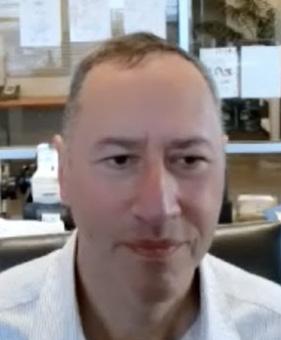
LET’S START wITH A qUICk OvERvIEw OF THE COmPANy.
Pioneer Power Solutions, Inc. is a leader in the design, manufacture, integration, service and distribution of electric power systems, distributed energy resources, power generation equipment and mobile EV charging solutions for applications in the utility, industrial and commercial markets.
wE’RE ABOUT HALF-wAy THROUgH 2023, wHAT ARE SOmE HIgHLIgHTS FOR THE COmPANy FOR THE FIRST HALF OF 2023?
The company reaffirmed organic revenue growth guidance of 50% for the full year of 2023 and at this point any new orders are filling in backlog for Q1/Q2 of 2024.
Two main products: E-bloc and e-Boost:

• Our innovative and highly customizable E-Bloc solution continues to expand its customer base and new use-cases. Customers come to Pioneer Power with unique challenges and energy needs, and we can utilize E-Bloc’s modular design to quickly design, deliver and support specialized, complex, and large electrical applications. EBloc’s design also allows us to seamlessly control multiple sources of power, including green energy especially from solar customers.
• The e-Boost system is an e -Mobility offering to charge a broad range of EVs such as EV shuttle buses, delivery vehicles, electric warehouse equipment and many other types of EVs as transportation companies, fleet managers, and other enterprises recognize the ease and cost benefit of charging at multiple locations without investing in fixed infrastructure. We are confident that increased adoption for these types of deployments will lead to additional awareness, resulting in more use cases and greater sales.
• Massive movement towards electrification of all types of vehicles to reduce carbon emissions.
• Federal, state and local mandates to electrify their fleets, buses etc.
• Explosive growth of electric vehicle ownership without adequate charging infrastructure in place.
• Continued growth of distributed generation as large users cannot get the power they need and anticipate needing from their utilities
• From what you can tell us, what are some of the company’s value catalysts for the rest of 2023?
• Additional customer wins with both the E-bloc
• Further penetration within existing large customers and industry use-cases
• Broader market adoption with more use-cases
• Full year organic revenue growth of 50% vs. 2022 with full year EPS and positive FCF
• No debt. ~$11 mil in cash on the balance sheet.
market expectation. Prime example- energy storage being offered in conjunction with E-Bloc and EBoost- will battery solutions to add additional power source on E-Bloc side and a zero emissions option on the E-Boost side.
To learn more about Pioneer, please visit its website at www.pioneerpowersolutions.com.

DISCLAImER AND FORwARD-LOOkINg STATEmENTS NOTICE: This article is provided as a service of SNN inc. or an affiliate thereof (collectively “SNN”), and all information presented is for commercial and informational purposes only, is not investment advice, and should not be relied upon for any investment decisions. we are not recommending any securities, nor is this an offer or sale of any security. Neither SNN nor its representatives are licensed brokers, broker-dealers, market makers, investment bankers, investment advisers, analysts, or underwriters registered with the Securities and Exchange Commission (“SEC”) or with any state securities regulatory authority
SNN provides no assurances as to the accuracy or completeness of the information presented, including information regarding any specific company’s plans, or its ability to effectuate any plan, and possess no actual knowledge of any specific company’s operations, capabilities, intent, resources, or experience. any opinions expressed in this article are solely attributed to each individual asserting the same and do not reflect the opinion of SNN. information contained in this presentation may contain “forward-looking statements” as defined under Section 27a of the Securities act of 1933 and Section 21b of the Securities Exchange act of 1934. Forward-looking statements are based upon expectations, estimates, and projections at the time the statements are made and involve risks and uncertainties that could cause actual events to differ materially from those anticipated. Therefore, readers are cautioned against placing any undue reliance upon any forwardlooking statement that may be found in this article.
SNN did not receive compensation for, nor engage in, providing advice, making recommendations, issuing reports, or furnishing analyses on any of the companies, securities, strategies, or information presented in this article. SNN recommends you consult a licensed investment adviser, broker, or legal counsel before purchasing or selling any securities referenced in this article. Furthermore, it is encouraged that you invest carefully and consult investment related information available on the websites of the SEC at http://www.sec. gov and the Financial industry Regulatory authority (FiNRa) at http://finra.org.
Note: This article is not an attempt to provide investment advice. The content is purely the author’s personal opinions and should not be considered advice of any kind. Investors are advised to conduct their own research or seek the advice of a registered investment professional.







Atotal of 30 companies raised HK$17 billion (US$2.2 billion) from January to June compared to 27 listing that raised HK$19.7 billion (US$2.5 billion) in 2022. Expectations for the second half of the year are more optimistic with PwC Hong Kong predicting around 100 companies will list in the city for the full year 2023, raising total funds between US$19.1 billion and US$21.7 billion. Market optimism for a comeback is further supported by a stable IPO pipeline and new listing rules that open the door for technology start-ups.
The biggest IPO in Hong Kong, and eighth largest worldwide in the first half of 2023, was from China’s fourth largest private baijiu maker, ZJLD, which raised US$675 million in April. Baijiu, a traditional Chinese liquor with a 5,000-year history, is the world’s most consumed liquor. ZJLD is looking to gain market share in a highly competitive environment by expanding its premium baijiu nationally. The market for the fiery spirit is forecast to grow from $112 billion in 2022 to $153 billion in 2032, according to Prudour Private Ltd, primarily due to a growing demand for high-end Baijiu combined with the liquor’s popularity spreading outside of China.
While volatile markets have swayed many companies to delay their IPO plans as they wait for market
conditions to improve, investor sentiment is gradually turning around. By July, appetite for new listings showed signs of a rebound as New Media Lab’s retail tranche was 40 times oversubscribed, making it the highest subscribed initial public offering in Hong Kong this year. The digital media flagship group priced its stock at the upper end of its range to raise HK$101 million. New Media Lab will use the funds to expand its digital media presence in the online media industry.

IPOs on the horizon include Chinese e-commerce giant ‘s JD.com spin offs Jingdong Property and Jingdong Industrials which could each raise about US$700m–$1bn. Jingdong Property is the asset management and operation arm of JD.com and exclusively handles the development, operation, and management of warehousing and logistics facilities for the company. Jingdong Industrials is an industrial supply chain technology and service provider that offers digital solutions to help customers achieve supply guarantee, cost reduction, and efficiency improvement.
China’s largest express delivery company, SF Holding, plans to raise up to US$2-3 billion in a second listing in Hong Kong which would make it one of the largest listings in the SARS this year. The Shenzhen-
The expected rebound in Hong Kong’s IPO market following the pandemic has been slow to materialize as the city fell to ninth place in global IPO rankings in the first half of 2023 and funds raised from new share listings dropped to a two-decade low.
listed company currently has a market value of UD$33 billion. Lalatech, an operator of on-demand logistics and delivery, has filed its application to list in Hong Kong. While the company did not specify how much it intends to raise, expectations are that it will be about US$1bn.
Chinese chip startup Shanghai Biren Intelligent Technology Co. is considering an IPO in Hong Kong this year, according to Bloomberg. The company has not stated how much it intends to raise but it is already considered to have reached Unicorn status as it is capitalizing on domestic demand due to export controls on Nvidia’s leading-edge GPUs. Biren specializes in chips for display cards, cloud computing and AI systems. The company is supported by the Chinese government’s effort to accelerate the development of its domestic semiconductor industry.
Although the overall market is struggling under geopolitical and economic pressures, the HKEX achieved several milestones that bolster its capital
markets and strengthen its position as an international financial centre. In March, the HKEX gave a boost to its technology sector with the inclusion of Chapter 18C to its listing rules. The new rules apply to applicants in five hi-tech sectors: cloud computing and artificial intelligence (AI), advanced hardware including electric and autonomous vehicles, semiconductors and the metaverse, along with new materials, new energy and food and agriculture technologies. Under Chapter 18C, companies with at least HK$10 billion (US$1.3 billion) are able to list, even if they have yet to earn a single dollar in sales. For companies with at least HK$250 million in sales in the financial year before their IPOs, the minimum valuation was slashed to HK$6 billion from HK$8 billion. While most companies listing under the new rules are expected to come from mainland Chinese tech firms, the new listing regime is also likely to attract companies from Southeast Asia and the Middle East, both regions with their own hotbeds of innovative tech companies.

The HKEX is also accelerating its international reach as it looks to attract more foreign listings. Following the February signing of a Memorandum of Understanding with Saudia Arabia to cooperate with crosslistings, the HKEX and the Indonesia Stock Exchange (IDX) signed a Memorandum of Understanding at the end of July. The exchanges hope to develop new capital market products, including exchange-traded funds and derivatives; enable cross-border listings; and promote sustainable finance across the region. The MoU also enables Indonesia greater access to Chinese issuers and the related international investment base.
Indonesia is experiencing a boom in IPOs, ranking the fourth largest market for IPOs in terms of capital raised this year, according to Dealogic. The country’s rise in IPOs is being fuelled by the government privatising some state-owned enterprises combined with its move to capitalize on its rich mineral deposits essential for global decarbonization measures. Southeast Asia’s largest economy is looking to become a major player in the global electric vehicle (EV) supply chain by tapping its nickel reserves, the largest in the world, and huge deposits of cobalt and copper. All three metals are used to make the
batteries in electric vehicles, while copper is also a key material in solar panels and cobalt is an essential part of the magnets used in wind turbines. On June 19th, Amman Mineral International, the country’s second largest copper and gold producer, listed on the Indonesia Stock Exchange. The company raised over $700 million, making it the country’s biggest IPO in 2023. Trimegah Bangun Persada, a nickel mining and refining company under the local conglomerate Harita Group, is the second-biggest fundraiser for 2023, raising $673 million. The company produces nickel-cobalt mixed hydroxide and other materials for EV batteries.
As the world’s largest offshore renminbi hub, Hong Kong has long played a pivotal role in the internationalization of the RMB. Further advancing the currency’s globalization, on June 19, the HKEx launched the much-anticipated HKD-RMB Dual Counter Model to the secondary market for trading and settlement purposes. The scheme allows investors in Hong Kong to trade stocks concurrently in both Hong Kong dollar and the yuan as the shares are fungible. The dual trading counter injects liquidity and vitality to the equity market. It is also expected to draw more global investors and boost trading on Hong Kong’s stock market. The initial batch of 24 companies, including AIA Group, Bank of China (Hong Kong), Hang Seng Bank, Tencent Holdings, Geely Automobile Holdings, Xiaomi Corp, Alibaba Group Holding and HKEX, make up about 40% of the average daily trading volume in the Hong Kong.
Ms. Leslie Richardson has over 20 years of investment management and equity research experience. She operates a boutique investor relations firm in Hong Kong for Asian companies listed in the U.S. and Hong Kong. She also assists private companies develop investment material and build an investor following in preparation for a public listing. Additionally, she is the Asian Correspondent for Micro-Cap Review, www.microcapreview.com, a financial magazine focused on mirco-cap companies. Previously, she worked for CCG Elite in assisting Asian-based, U.S. listed clients formulate key communication strategies. Ms. Richardson began her investment career at U.S. Trust Company then went on to join Odyssey Advisors as a portfolio manager and Director of Research. Ms. Richardson specialized in high growth sectors such as bio-tech, alternative energy, IT and telecommunications. She earned her M.B.A. from the University of Southern California. Ms. Richardson is based in Hong Kong. www.elite-ir.com.
Indonesia is experiencing a boom in IPOs, ranking the fourth largest market for IPOs in terms of capital raised this year, according to Dealogic. The country’s rise in IPOs is being fuelled by the government privatising some state-owned enterprises combined with its move to capitalize on its rich mineral deposits essential for global decarbonization measures.

COTE Capital’s Intellectual Property (IP) Capital model is one such groundbreaking approach that has been gaining traction in recent years. This article will discuss the key reasons why the IP Capital model is the investment model of the future, and how it is transforming the landscape of asset management and wealth creation.
Traditional investment models primarily focus on tangible assets like real estate, stocks, and bonds. The IP Capital model, on the other hand, recognizes the value of intangible assets, such as patents, trademarks, copyrights, and trade secrets. By incorporating these often-ignored assets into investment portfolios, COTE Capital is tapping into a vast pool of untapped wealth, creating new avenues for growth and value creation.
The IP Capital model allows investors to capitalize on the immense value generated by innovation. With the rapid pace of technological advancements and a growing emphasis on research and development, intellectual property has become a critical driver of economic growth. By investing in companies with strong IP portfolios, COTE Capital enables investors to gain exposure to the most innovative and forward-thinking firms, thereby future-proofing their
investments.
By including intellectual property in investment portfolios, COTE Capital’s IP Capital model adds a new dimension of diversification. This diversification helps to spread risk across a broader range of assets, reducing the potential impact of market volatility on individual investments. As a result, investors can enjoy the benefits of a more stable and resilient portfolio.
The importance of intellectual property is increasingly being recognized on a global scale, with governments and international organizations promoting the development and protection of IP assets. This global trend towards the prioritization of IP rights supports the growth and relevance of COTE Capital’s IP Capital model, ensuring that it remains a vital component of the investment landscape in the future.
Investing in companies with robust IP portfolios can give investors a competitive edge. Firms with strong IP assets are often better positioned to defend their market share, maintain pricing power, and drive
In the world of finance, innovation is the driving force behind the development of new investment models.
innovation. By identifying and investing in such companies, the IP Capital model enables investors to gain a strategic advantage over their competitors.

COTE Capital’s IP Capital model also emphasizes the integration of environmental, social, and governance (ESG) factors into the investment process. By considering ESG criteria alongside IP assets, the model aligns with the growing importance of responsible investing and allows investors to make more informed, ethical, and sustainable investment decisions.
COTE Capital’s IP Capital model is revolutionizing the world of investment by recognizing the value of
intangible assets and capitalizing on the power of innovation. This unique approach offers investors the opportunity to diversify their portfolios, reduce risk, and align with global trends, while also gaining a competitive advantage and contributing to a more sustainable future. As a result, the IP Capital model is well-positioned to be the investment model of the future.
Website: www.cotecapital.com
Email: rcote@cotecapital.com
Bio: Robert Cote, founder and CEO of Cote Capital (www.cotecapital.com), is one of the world’s leading intellectual property (IP) lawyers and investors. He has 25 years of experience in identifying, valuing, and investing in the breakthrough IP of technology companies that built new industries in the United States. He has experienced firsthand the challenges technology companies face in funding the growth of their businesses as they enter commercial markets. He developed the IP Capital model as a better way of investing in and scaling a new generation of these companies.
ShiFTiNG ThE OddS iN yOuR FavOR
It is a city built on a tiny statistical advantage in the games of chance offered by the casinos. Small edges in the risk reward outcomes moves millions of dollars into the pockets of the shareholders of casinos. Investors give themselves a better probability of success by having a thoughtful process of
researching, analyzing, and investing in microcap companies. The same way casinos hold a small advantage in games of chance, this article describes actions investors can take to strengthen their investment process and shift their probability of success for investing in microcap companies.

Today, nearly 50 million visitors a year come to Las Vegas to enjoy the city, which obviously includes gambling.
Let’s start by understanding the challenges of active investing. According to a study by Hendrik Bessembinder of the W.P. Carey School of Business at Arizona State University, from 1990-2020, 2.4% of all the companies in the stock marke accounted for 75.7 trillion dollars of the wealth created. Essentially, one out of 40 companies do the heavy lifting of generating great returns. In the microcap area, the probability of finding one of these entities is even smaller, probably much more so. We know we are up against a difficult task. If you are privately investing in microcap companies, a percentage of up to 10% of your capital is probably reasonable. Still, investors come to the microcap area because it is possible to find situations where the returns can be substantial, and in some cases, life changing.
The first recommendation is to invest in industries and companies where you are excited about the prospects. One way to do this is to eliminate industries you have no interest in. Personally, I rarely look at the automobile, airline, cannabis, biotechnology, early-stage pharmaceuticals, leasing, and many manufacturing entities. Industrial entities are probably not going to get much of a look, either. I means you say no to 90-95% of most companies. The filtering is importan because the largest microcap conferences like the Planet Microcap Showcase, LD Micro, or investment banking conferences often have hundreds of issuers presenting. Online conferences will have smaller numbers, closer to 10-20 entities, but narrow your search to only those you are excited about. A healthy number is 10-15 companies you really want to pursue with a more detailed examination.
The second piece of advice is to go to each web site of the company you are researching and learn about the individual members of both the board of directors and the management team. You are looking at the backgrounds of these individuals for proof they have a historical track record of creating value for their shareholders. You will find a vast majority of microcap companies have executives which have not proven they are wealth generators. While you are researching the board and executive team, you should find out what percentage of the economic and voting ownership of the company these individuals possess. You can go to the proxy statement to learn this information. I look for percentages of over 25% or more, and higher is better. As part of this research, you should discover if there is a dual class
of shares and what voting rights each class of shares is entitled to. With multiple classes of shares, you will find situations where the founder might own 5-10% of the company but has 50.01% voting control. I wan situations where the management team has a history of creating great wealth and high ownership. If they have voting control you can live with it, but the first two criteria are mandatory. As part of the ownership investigation, yearly issuance of stock options needs to be analyzed. A good general rule is that issuance of 1-2% per year is acceptable. As a company moves towards 5% per year it becomes more of a concern. Anything over 5% per year is a problem. Remember, you don’t ge those options and when exercised, they reduce your ownership piece of the company. On a yearly basis, constant dilution can really detract from returns.
The third area to research is analyzing the balance sheet of the company, specifically the capital structure. Before diving into the liability section, look a the total number of shares outstanding. In the microcap area, it is often the case that the total number of shares outstanding is not symmetrical with the size of the business. Typically, it involves a total number of shares outstanding of over 100 million or more, when the revenue (top line) of the business is 20 million or less. In these circumstances, unless the business sees tremendous year over year growth for a long period of time, equity holders are burdened with too much supply of equity. There are high profile investors who believe you should look for situations where the number of shares outstanding is less than 10 million. The scarcity of the number of shares available is what you are concerned about, especially relative to the size of the business.
On the liability side, it is important to know the debt profile of the company. How much debt does the company have? How many tranches of debt exist? What is the interest rate on each tranche? When does the most immediate piece mature? Are there credit lines and how much has been drawn? When do the lines mature? Most importantly, what do the interest and asset coverage ratios look like?
As far as assets are concerned, value investors are always looking for situations where there is a great deal of cash relative to the market value of the company. I is very rare, but there are some companies with more cash on the balance shee than the current stock price. These are occasions where
a closer look is necessary, but it is often the case that the operations are burning cash. Comparing the quarterly and yearly burn rate to the existing cash level gives you an idea of the time horizon before more cash potentially needs to be raised. You often see this with early-stage biotechnology and pharmaceutical companies. One other asset to pay attention to is any tax loss carryforwards and those amounts. Larger is better, and combined with a cash generating business, these assets are strategic and potentially valuable for an extended period.
Fifth, let’s turn to existing operations, the income statement, and the size of the business. Understanding the unit economics, business model, competitive advantages, and growth prospects of the business is the highest priority for any investor. Those areas are directly related to the integrity, credibility, reliability, and focus of the management team. Strong management teams tell you the plan, and execute it. There is consistency over a long period of time, and the attention is on their core business. The main business should have one or two segments. Any more and there is not enough focus.
For a company to begin to attract institutional sponsorship, the top line needs to be close to a
hundred million and headed towards five hundred or a billion dollars. From my perspective, I want to see businesses with a top line of at least 50 million dollars or close to it. Anything less than twenty-five million is going to be relatively small versus what is needed to overcome the institutional barrier. Interesting situations can be discovered where a business might be at twenty million on the top line, and they are involved with an acquisition which would double or triple the top line and immediately improve the cash generation capabilities. Clearly, this depends on the specific situation and the ability to execute and integrate.
I also am looking at 2,3-, and 5-year comparisons of the income statement to look at top line growth and margins. Clearly, higher growth rates, improving margins (shoot for at least 10% on the operating margin level), and operations which are consistently improving over time is the ideal situation. Now, let’s move to cash flow and capital expenditures.
I want companies that are either generating cash, or are systematically moving towards operating cash flow. I also don’t want to see a lot of capital expenditure so you will potentially own a high free cash flow generating entity. Comparing the balance sheet to the cash flow statement gives you an idea of how the working capital, cash conversion, and timing of the receivables and payables is taking place. Many investors use adjusted EBITDA, EBITDA, and EBIT as proxies for cash flow from operations. It is important to look at capital expenditure as well. I typically avoid anything that is capital intensive, but each company is unique in this regard.
Finally, every listed company on a public exchange is trying to improve their business. Those which involve a big change, like a management replacement, business model overhaul, spinoff, exchange or sale of a division, or a stock buyback, are potentially worth investigating further. If you incorporate all of these points into your investment process, it will help improve your chances of finding a hidden gem in the microcap area. Like the casino in Las Vegas, improving your risk reward is potentially a tremendous source of value.





Yttrium, Neodymium, Terbium, Lanthanum, Dysprosium, Cerium, Praseodymium, Gadolinium………..You can be excused for thinking someone is trying to secure a critical element to maintain the warp core stability of the US Starship Enterprise. For the “Trekkies” amongst us, of course well all know it is the dilithium crystals that perform that function. Dilithium is a molecule composed of two covalently bound lithium atoms which exist in gaseous lithium. Word of warning, I wouldn’t be putting dilithium crystals into your new Tesla or you’ll be traveling “Back to the Future” quicker than you can say Elon Musk! For non-Trekkies, dilithium crystals don’t actually exist in the real world…………….or do they?
what does exist are the 17 Rare Earth metals, which are increasingly being spoken about and explored for and are arguably about to become the next big thing because of their strategic importance. According to ResearchandMarkets.com (1 February 2023), in 2021 the Rare Earths market was worth around
$7 billion and is projected to reach $15.5 billion by 2030, growing at 9.1% CAGR from 2021 to 2030. To put this into perspective the lithium market for 2022 was also estimated at $7 billion. The lithium market will probably grow at a more rapid rate than that of Rare Earths over the next few years, because of the number of deposits already discovered and the advanced nature of many emerging new lithium producers.
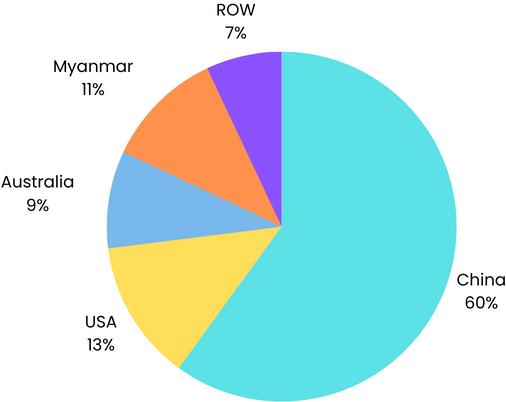
So, what are Rare Earths used for and why are they so strategically important? To start with, the term “Rare Earths” is a bit of a misnomer, as they are not really rare at all. However, because of their geochemical properties, Rare Earths are typically dispersed and not often found concentrated in Rare Earth minerals. Rare Earths, or REEs, are primarily used in the production of permanent magnets (30%), high tech devices, smart phones, electric vehicles, computers, LEDs and flat screen TVs. These uses, as well as high tech military applications, make these elements
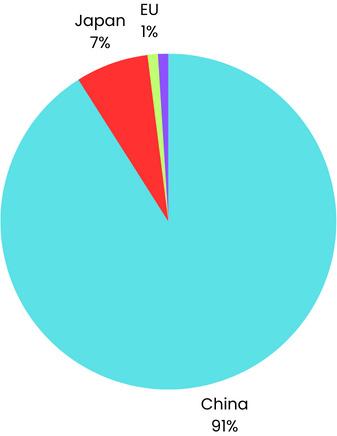
increasingly important in today’s high-tech world. China accounts for approximately 60% of world REE production, 85% of REE processing and 91% of REE magnet production. Myanmar, the US and Australia account for around 33% of world REE production, with the Rest of the world accounting for around 7%. Western countries have become conscious and understandably concerned about China’s ability to control and potentially manipulate this market.
The only operating Rare Earths producer in the US is the Mountain Pass REE project located in the Clark Mountain Range of California, about 53 miles southwest of Las Vegas, and owned by Mountain Pass Materials Corp. The project has had a somewhat checkered history with the project and its former holding company having gone through Chapter 11. In 2002 a toxic waste spill closed production for a number of years. Around the same time virtually all other US Rare Earths producers closed as they were unable to compete with China. This was due to far cheaper labor costs and poorer working conditions, and significantly less stringent environmental controls. Many Rare Earths deposits contain radioactive elements such as thorium and uranium which not only pose health and safety risks, but also can affect recovery rates, impurities, and acid usage. This in turn can impact on the economic viability of projects.
It should be noted that not all Rare Earths projects are equal. The primary distinction is between hard rock hosted REEs and ionic adsorption clay hosted(“IAC”) projects. As a rule, hard rock deposits require a number of processing stages, much larger capex and can be consumers of substantial quantities of reagents and acid. There are currently not many IAC projects (and none currently in production) outside of China. Based on the nature of the mineralization, they should be able to be exploited far more cost effectively and environmentally much friendlier than their hard rock alternatives.
The geological theories and production scenarios behind IAC REE deposits are still emerging as this is a relatively new area and economic viability is a function of size, grade and importantly pH levels. As pH levels decrease this influences acid consumption and impurity removal. IAC deposits usually contain very low levels of radioactive thorium and uranium elements and are usually found at, or close to surface. There is also a degree of homogeneity within the mineralization. These factors make explo-
ration and discovery generally far cheaper than hard rock hosted deposits. Outside of China, new IAC REE deposits have been discovered in the Southern States of Australia including Tasmania (ABX Group, ASX: ABX), Victoria (Australian Rare Earths, ASX: AR3) and in Queensland (Devex Resources, ASX: DEV). A number of other ASX listed companies have reported important IAC discoveries in parts of the US, Africa and Latin America, particularly Brazil. One Aussie company, Meteoric Resources (ASX: MEI) is developing its Caldeira IAC project in Brazil, which is claimed to be the world’s highest grade IAC deposit. The current JORC defined resource base sits at 409 mt @ 2626 ppm TREO (Total Rare Earth Oxide).
Meteoric Resources’ Chairman Andrew Tunks commented “This is a particularly exciting time for the company with both Europe and the US looking to secure a large reliable and cost-effective supply of REEs outside of China”. The Australian market has certainly jumped on board with the price of MEI shares increasing over tenfold since November last year and driving the company’s market cap to around USD $ 300 million, in what some may call a “meteoric” rise.
As we have all come to appreciate, commodity cycles can be fickle, and commodities can go in and out of favor in response to world demand. It seems that Rare Earths, especially IAC hosted Rare Earths, are set for an exciting ride. Reliance upon technology, electric vehicles, permanent magnets and high-tech electronic devices isn’t going anywhere and underpins the ongoing and increasing demand for REEs. China aside, a growing focus on environmentally sustainable extraction and processing techniques are highly influential in terms of the permitting and approval process and favor IAC hosted deposits.
So, are Rare Earths set to become the next big thing and should we as investors be jumping on this Starship? You know the greatest danger facing us is ourselves, and an irrational fear of the unknown. There is no such thing as the unknown, only things temporarily hidden, temporarily not understood-Captain James Kirk.
That’s all for now folks, “Beam me up Scotty”.

ESGFIRE has a performance record of over 1000 % returns since 2018. By only investing in environmentally friendly companies, ESGFIRE has outperformed the major indexes for several years. We have a track record of over 1000 % returns since 2018 using our own proven method of identifying high potential ESG companies. During the same time period (2018-2021) the Nasdaq has returned ~126 % and the Swedish stock index OMSPI has returned ~82%. For example, during 2021 our portfolio returned 91% compared to ~21% for the NASDAQ and ~35 % for the Swedish stock index OMXSPI. We
take great pride in the fact that we personally invest in ALL of our portfolio companies and they all have to go through the same rigorous selection process. This means that when our portfolio does well, our readers who follow us do well too. About 70 % of the portfolio consists of public companies and 30 % are nonpublic companies which typically have 12-24 months until IPO. Our non-public investments have year to date on paper averaged returns of around 400 %*. We regularly meet with interesting climate tech startups all over Europe and this gives our free newsletter subscribers a very interesting
deal flow since we write about all our new portfolio picks. Currently we have 12 companies in total in the ESGFIRE portfolio.
Our challenge when first starting with ESG investing was that that there weren’t any clear guidelines on how to define what constitutes as ESG friendly investing. Most people would agree that the acronyms of ESG namely Environmental, Social, Governance cover different aspects of how a company should act and treat stakeholders in order to comply with ESG regulations. However, receiving a good ESG rating essentially means a company is managing its environment, social, and governance risks well relative to its peers. This is the reason why a company making harmful products such as tobacco or an oil company such as Chevron and Marathon Petroleum receive high ESG scores. This is also the very fact why ESG ratings have been highly criticized by the broader investment community. The CEO of Blackrock Larry Fink said last month he was going to stop using the term ESG “because it is being politically “weaponized” and he’s “ashamed” to be part of the debate on the issue.”
*This does not constitute liquidated assets / investments we have made exit on.
If our governments around the world are to succeed in keeping global warming at a maximum of 1,5 degrees celcius to stop disastrous climate change, it will require massive investments into clean energy technologies to help reduce CO2 emissions. Not only will a massive reduction of CO2 and therefore green energy be necessary, it will also become a necessity to transform our society from a buy & throw society into a society which prioritizes circular economy and reusing valuable resources. ESG for us is a sector of interest which is bound to have massive growth and enormous governmental subsidies support for the foreseeable future. This macro trend offers investors a huge advantage few other sectors are even remotely close to. This is the reason investors should pay attention to ESG.
Where we believe most managers and ESG gurus go wrong in ESG investing is that they focus too much
Since there was no clear definition of ESG investing back when we started in 2018 we decided to create our own. In our opinion a company essentially has to have either an environmentally friendly product or service for us to even consider investing. ESgFIRE focuses on small cap and microcap companies which for us typically are at a market cap below $100 million USD. The reason for our focus on smaller companies is that our strategy is based on finding high potential companies in early stages in order to maximize our returns during the expected growth journey. The other reason we have chosen to focus on companies in this range is that they are usually not covered by other analyst firms and the chance of finding mispriced companies is considerably higher.
As of now, the main scope of our investing companies is on those companies which are profitable or at least very near breakeven in the cleantech / Agtech sector. In other words, it has to be an environmentally friendly business product or service. If the company is not profitable it needs to have a high MOAT or uniqueness for us to become interested.
We have a unique way of picking our portfolio companies and they need to meet almost all of our criteria described below in order to qualify for the ESGFIRE portfolio selection:
• Environmentally friendly business idea
• Unique product offering or service with strong IP and/or patent portfolio.
• Either profitable or near profitability
• Solid management.
• Sustainable production methods.
• Investor friendly management team.
• Recurring revenues.
• Solid path to profitability.
on the standard ESG rating criteria described in the beginning of this article and less on how sustainable a company actually is. One mutual fund we think is worth mentioning, which is somewhat aligned with our own investment criteria is the Swedish climate tech fund Proethos. They currently have about $80 million USD under management. The fund mainly invests in companies with a market cap above $100
million USD which excludes most microcap and small cap companies of interest to ESGFIRE. They have chosen to focus on sustainable energy, energy efficiency and sustainable transport / lifestyle which we think is a good investing angle. Traditional ESG ratings are useful for screening out potentially reckless companies but its less effective in actually identifying companies that ESGFIRE constitute as truly sustainable and environmentally friendly investments.

As an investor if you wish to create your own ESG investing strategy our opinion would be to focus on green energy transitioning, sustainability, agtech and companies offering solutions that reduce carbon footprint. By focusing on these four major areas you will position yourself in the four areas we think will have the largest growth in the ESG space for the coming ten to fifteen years. The companies mentioned below are a few of the many bargains that can be made right now by observant ESG
investors. We would keep a lookout for companies with a depressed share price return and don’t be afraid to look at companies that have had a rough journey as long as you believe management has a viable plan financing path to profitability. A large share count does not necessarily mean a red flag as long as management has a plan to actually turn the company around and/or to make a reduction in number of outstanding shares.
Among the four areas mentioned above Agtech is worth highlighting since its often overlooked by most investors. To give a short explanation of what Agtech is: Agtech is the application of technology and digital tools to farming. However, from our investment scope we mainly look at Agtech companies which either reduce carbon footprint or enable larger crop yields with environmentally friendly innovations. We would like to share two examples of climate friendly Agtech companies in our portfolio and those are Replenish Nutrients (CSE: ERTH, OTCQB: VVIVF) and Ekobot (Nasdaq First North Growth Market EKOBOT) . Replenish Nutrients is a Canadian company which produces a patented
naturally-sourced, regenerative fertilizer which re-establishes soil health and increases crop yield while reducing co2 emissions. Ekobot is a Swedish company is at the forefront of the development of the Autonomous Field Robot for Mechanical Weed Control which makes ecological farming a lot more cost effective thereby reducing the need for harmful pesticides. Both companies are currently, in our opinion, quite mispriced due to a very challenging market conditions for small cap companies in general but especially for companies not already profitable. Another company worth mentioning in the green transitioning sector is Landi Renzo ( Milano exchange LR) which is an Italian small cap company that is supplying green technology to some of the largest players in the automotive industry. The company also has a subsidiary which is supplying technology to hydrogen refueling stations across the globe.
The G in ESG stands for governance and examines how a company polices itself, focusing on internal controls and practices in order to maintain their compliance with regulations, industry best practices and of course corporate policies. In fact, most investors may be an ESG investor without knowing it since all companies have to comply with regulations if they wish to stay in business for the long term without unmanageable risks. Following the governance of the G in ESG involves, among other things, financial transparency and business integrity. The German company Wirecard is a great and well-known example of failed governance where poor governance led to the biggest scandal in German financial history . The scandal concluded with the publicly listed company Wirecard reporting on June 18th 2020 that 2 billion EUR were missing from their accounts which amounted to all the profits the company had ever reported as a public company in the end it turned out the profits had been inflated. If this could happen in Germany of all places you may ask yourself, could it happen anywhere? Luckily authorities in Europe and North America have become increasingly more aware and vigilant regarding accounting scams but this alone does not make it possible for investors to relax and not question red flags. It has become increasingly more important for all types of investors to manage the governance risk of their investments. Investors should also be aware of the governance risk which follows hiring fund managers and wealth managers to invest their money. If these profession-
als lack the proper internal governance structure it may affect the risk management of how they invest your hard-earned money.
To conclude, we think there is mainly one principal problem in ESG investing. All investors, regardless of whether it be institutional or retail, are essentially delegating investing decisions to portfolio managers that are supposed to be outperforming the market in picking the right stocks and experts in assessing companies ESG credentials. ESG funds typically have a higher fee than regular funds and without knowing how these companies actually pick their portfolio companies investors, in our opinion, are throwing their money away in most cases. If you want to be a responsible ESG investor you need to pay attention to what a company actually does, not what it says. The same goes for when choosing what funds to invest your money in. Investors need to be more critical of portfolio managers stock selection criteria to avoid making the mistake of simply placing money with a fund or wealth manager that is using traditional ESG criteria instead of a more accurate sustainability / lowering carbon footprint criteria more like Impact investing. All investors need to take note of the governance risk when both investing in individual stocks as well as picking the right wealth manager or fund manager for their investments. If you want to make above index average returns you need a strategy that enables above index returns. This inevitably means you will have to take greater risks and potentially you will make big losses on some investments. The key to succeeding investing in the ESG microcap sector is to be critical, investigative and by applying a sound risk management / diversification. Try to find companies that you are interested in since this will keep your own interest for the long run but don’t make the mistake of falling in love with your investments. Regularly review your strategy and cut out the companies who aren’t meeting your expectations. One thing is certain, companies and investors will need to be pay attention to ESG criteria and environmental impact for the foreseeable future.
Although most publicly traded companies pay close attention to engaging in professional investor relations practices, adding public relations to the corporate communications mix can pay tangible, added benefits.
Planet MicroCap’s Shelly Kraft recently sat down with veteran investor relations and corporate communications advisor Roger Pondel, CEO of PondelWilkinson Inc., to ask a few questions about how PR adds value and why public relations should be considered for public companies.
Sk: LET’S START wITH THE BASICS … HOw DO yOU DEFINE PUBLIC RELATIONS?

RP: Public relations is a highly professional discipline, with its own national association and thousands of practicing professionals. While there are any number of definitions, pros will say it is the practice of communicating with targeted audiences, which involves managing, crafting and disseminating factual information to educate, inform and to help influence change or perception.
Sk: wHAT ARE SOmE OF THE PUBLIC RELATIONS STRATEgIES THAT CAN BE DEPLOyED TO ENHANCE AN INvESTOR RELATIONS PROgRAm?
RP: A few strategies that can enhance investor relations include developing a comprehensive media relations plan, utilizing social media platforms for targeted investor messaging, maintaining a strong online presence, and engaging in thought leadership activities to position organizational executives
as industry experts. This can be further amplified through regular press releases, media outreach and publicity, investor events and leveraging digital platforms to communicate key messages.
Sk: wHAT OTHER vALUE-ADD BENEFITS COmE TO mIND wITH ENgAgEmENT OF PROFESSIONAL PR?
RP: There is one big one: the ability to reach multiple constituencies. While investor relations focuses on one primary audience - the investment community - the use of PR can help a company get its messages out broadly to many audiences, including customers. So there are marketing benefits. Customers can become shareholders, and shareholders can become customers.
RP: Not at all. Publicity, which can be favorable or not, is a tactic that could be incorporated into a broader public relations strategy. For example, firms pitch narratives to reporters to get them to write positive stories about their clients, such as a company’s earnings. The benefit of “earned,” vs. payfor-play, media coverage is the amount of awareness and credibility that publicity can bring to a brand, organization or equity. However, earned media has become increasingly challenging to obtain given the ever-shrinking news hole. Ensuring press coverage requires creativity and expert knowledge of various media landscapes.
RP: Absolutely. While it is possible for public companies to practice one discipline without the other, paying attention to both disciplines will indeed maximize communications value. For example, a solid IR program without stellar PR could mean that messages are not getting out to the right and widest audiences, or perhaps not getting out clearly and concisely. Conversely, a PR program that does not pay close attention to IR could be fraught with risk from a legal standpoint. That’s why we believe CEOs and CFOs should view corporate communications with both disciplines in mind as “needs” and not just frilly “wants.”
Sk: HOw CAN A COmPANy LEvERAgE PR AND IR TOgETHER?
RP: Certainly having expert tacticians in each discipline is critical. But experience and teamwork are the real key. It is almost easier for microcap and small cap companies than it is for larger companies to manage the communications process. With larger companies there are typically, and often by neces-
sity, more bureaucratic management structures. Silos often exist, separating the PR and IR departments, with divergent reporting structures and different priorities. Smaller companies are usually more entrepreneurial and nimble, which in itself, better facilitate a smooth, consistent path to communicating, regardless of intended audience.
Sk: HOw CAN PR CONTRIBUTE TO ATTRACTINg INvESTORS?
RP: Public relations efforts can contribute to attracting new investors and reinforcing the existing the investor base by showcasing the company’s strengths, highlighting its financial performance, and positioning it as an attractive investment opportunity. Through targeted media coverage, thought leadership articles, and engaging content on digital platforms, public relations can effectively reach potential investors and generate interest in the company.
Sk: wOULD yOU SAy THAT ‘COmmUNICATIONS’ IS A COmmON THEmE FOR BOTH PR AND IR?
RP: Definitely. Communicating is the red thread that brings the two disciplines together. For public companies, while the PR professional may be more adept in the tactic and art of communicating and getting messages heard, it is typically the IR pro who has the deeper understanding of value creation and the knowledge of what and what cannot be communicated.
Sk: wHAT ROLE DOES PUBLIC RELATIONS PLAy IN BUILDINg INvESTOR CONFIDENCE AND TRUST?
RP: Public relations plays a crucial role in building investor confidence and trust by shaping positive public perception, promoting the company’s mission, values and achievements, and addressing any potential concerns or issues. Through strategic communication and effective media relations, public relations can help establish a strong reputation, which in turn enhances investor confidence and trust.
Roger Pondel is CEO of PondelWilkinson Inc., a full-service investor relations and strategic public relations consultancy, operating for more than 50 years that has earned a national reputation for innovative, aggressive, professional service. The firm represents publicly traded, pre-public and privately owned companies - from microcap to big cap - in multiple sectors, blending public relations and investor relations disciplines to provide a value-add offering. Roger and his team can be reached at rpondel@pondel. com, or 310-279-5965.
Lucosky Brookman LLP, a leading corporate law firm, is devoted to contributing time and resources to giving back to the community through a hands-on approach to charitable activities. Since 2014, Lucosky Brookman, together with its friends, clients and colleagues, has donated over $775,000 to charitable endeavors throughout the world. In 2017, Lucosky Brookman founded the Lucosky Brookman Foundation, a public 501(c) (3) charity, through which the Firm uses the power of philanthropy to impact the lives of those less fortunate.



Lucosky Brookman invites you to join it in supporting The Save A Child’s Heart Foundation (SACH). SACH is a global humanitarian organization, with a mission to provide life-saving cardiac care to children of all backgrounds, regardless of race, religion, gender, nationality, or financial status, who suffer from congenital and acquired heart defects and have no access to quality care in their native countries. SACH is also committed to providing training to doctors from developing countries to set up local centers of competence. To date, SACH has have saved the lives of 5,000 children from 58 countries and has trained over 120 international medical personnel.
To learn more or make a donation visit www.theLBF.org
